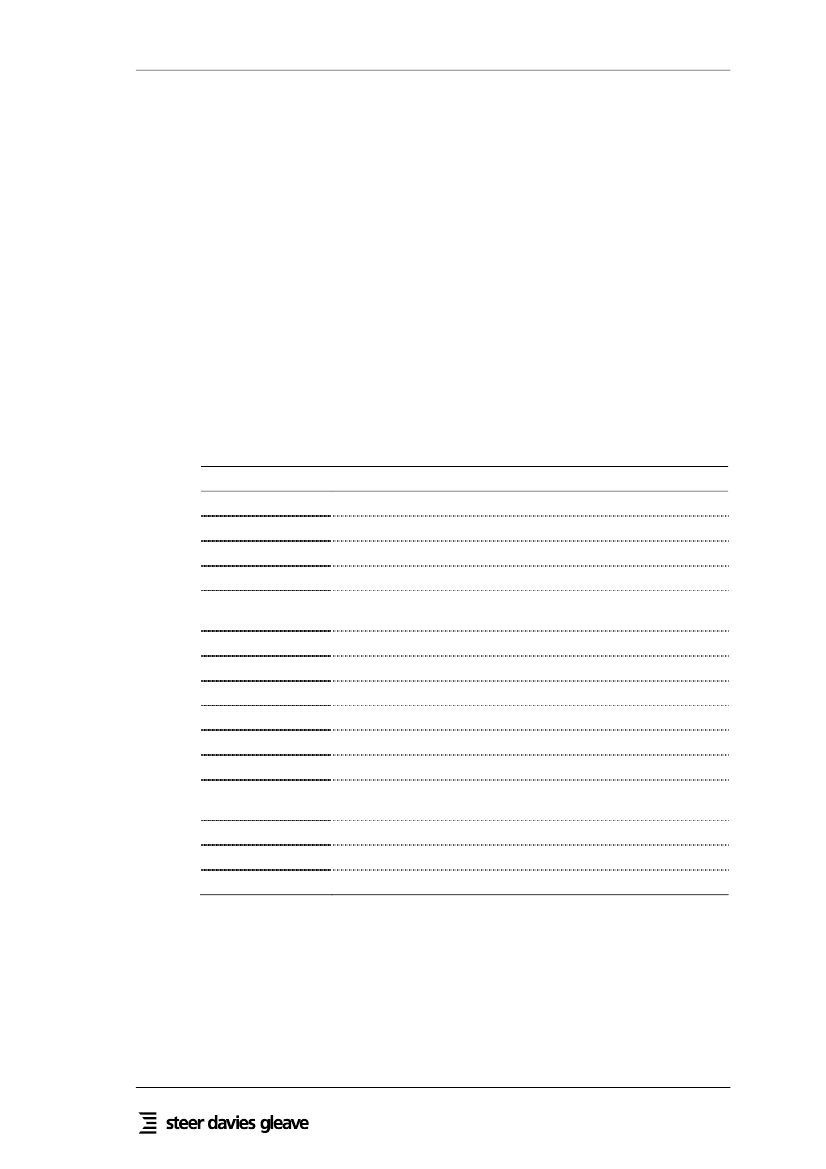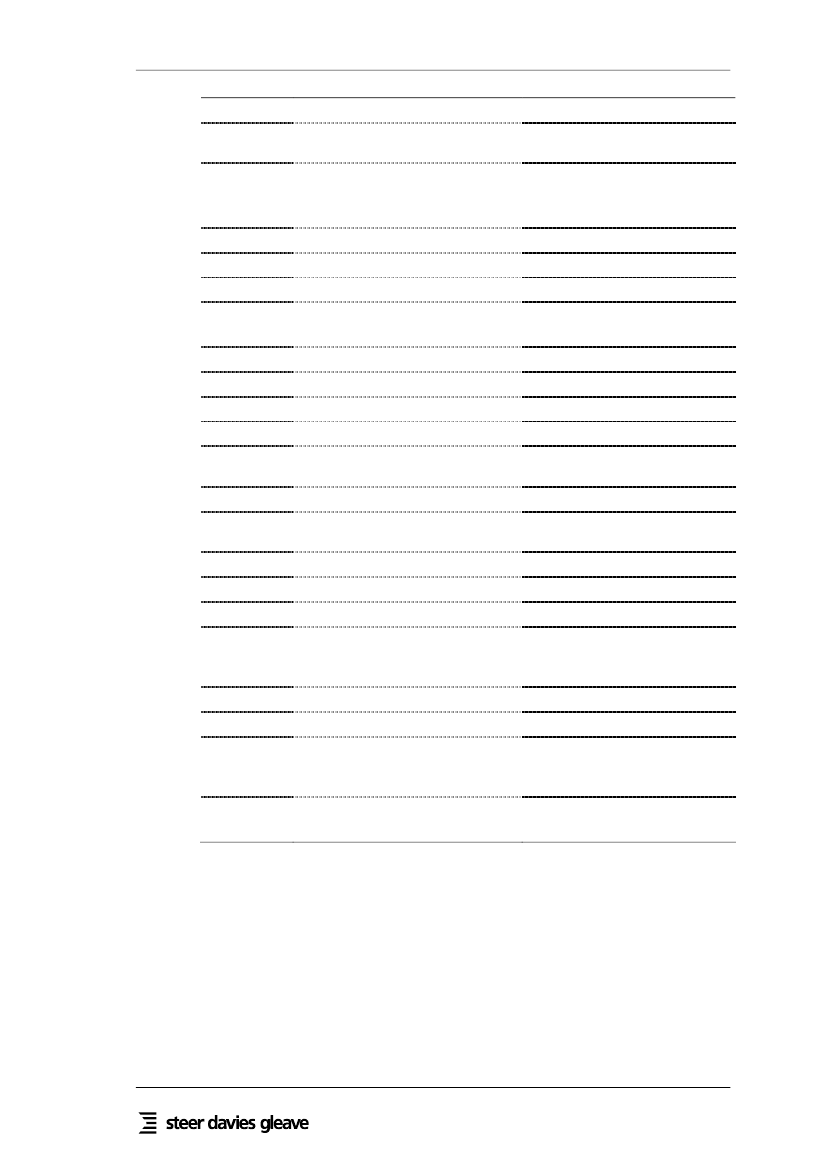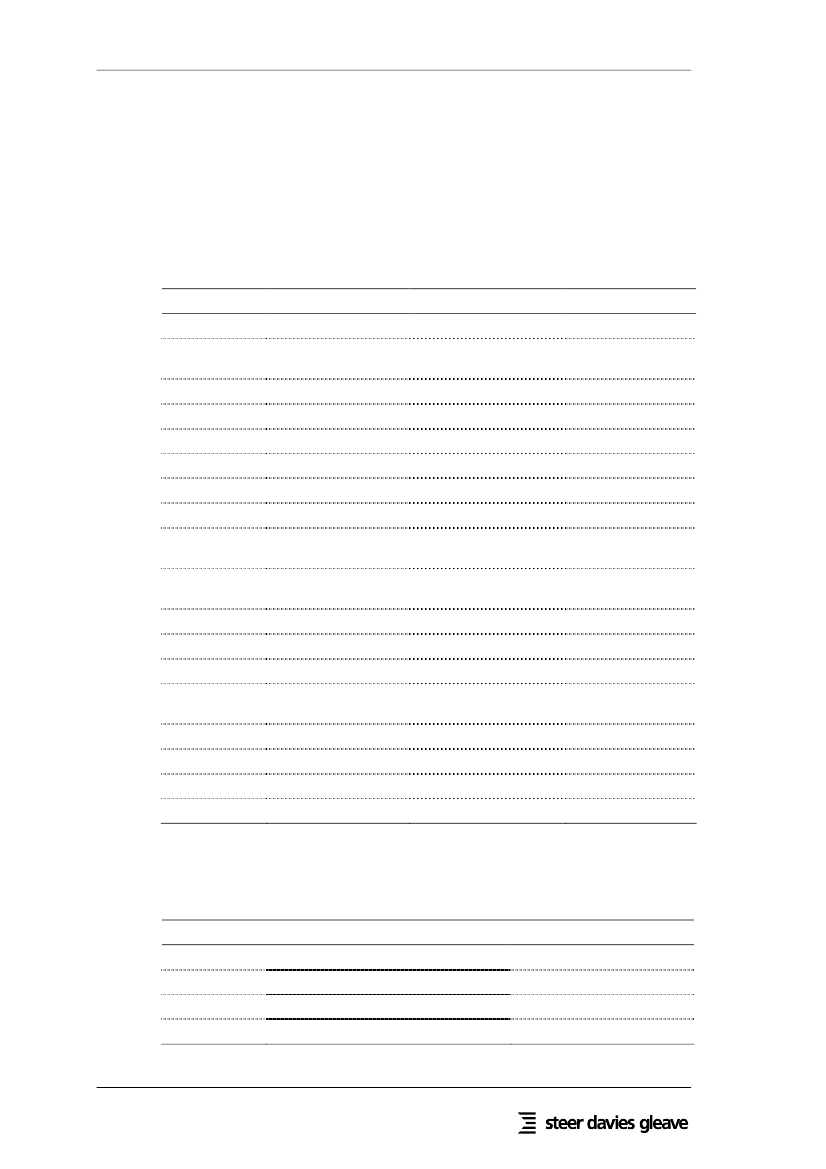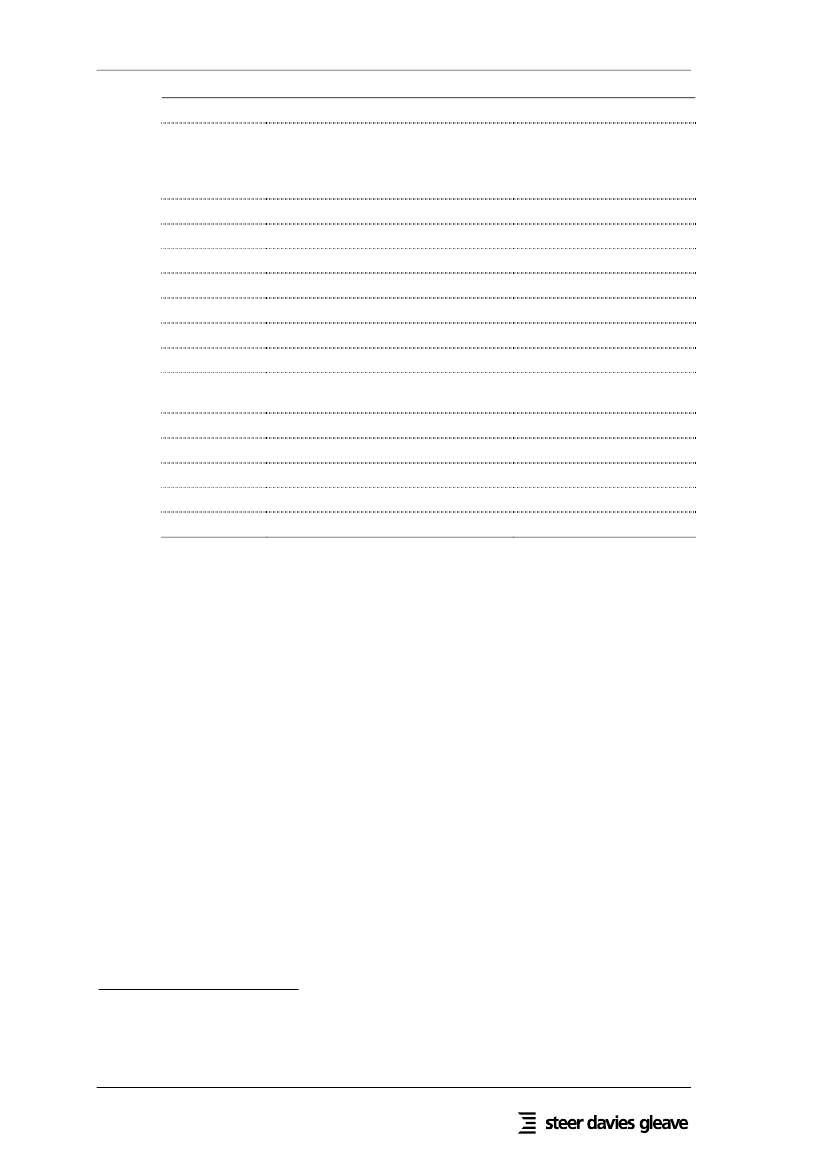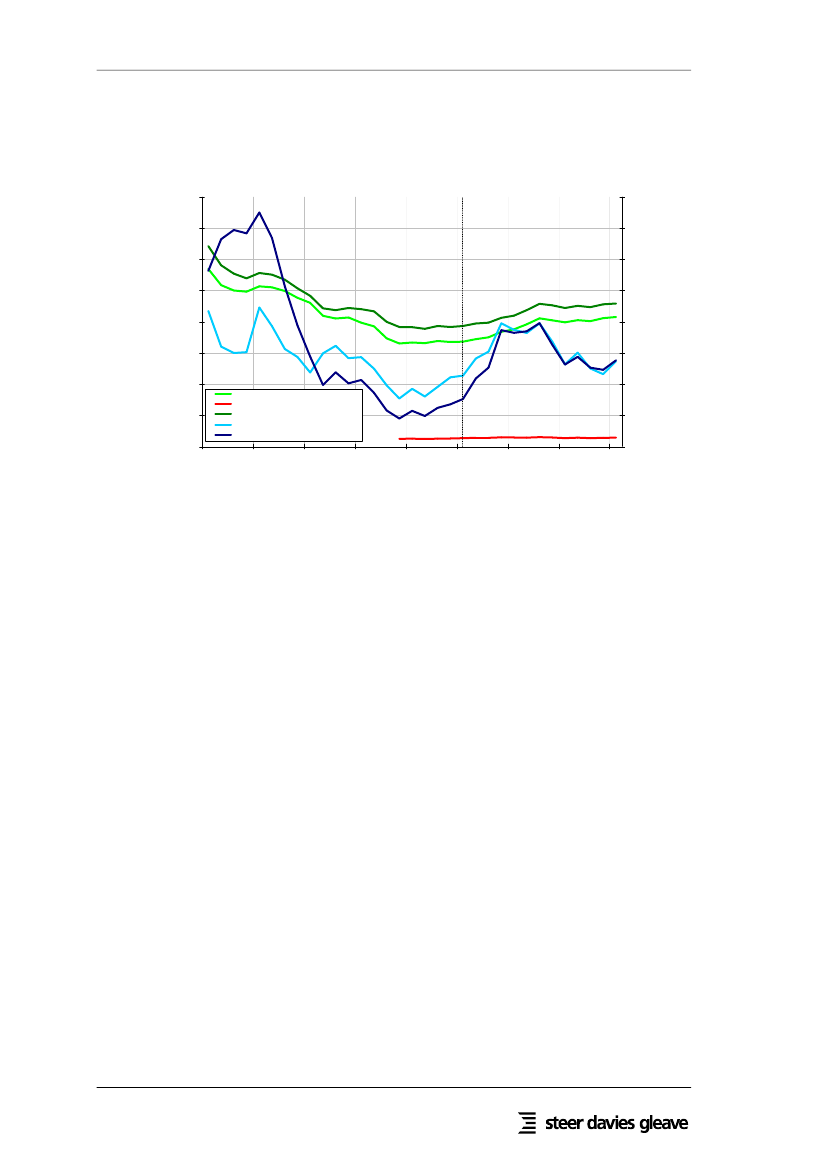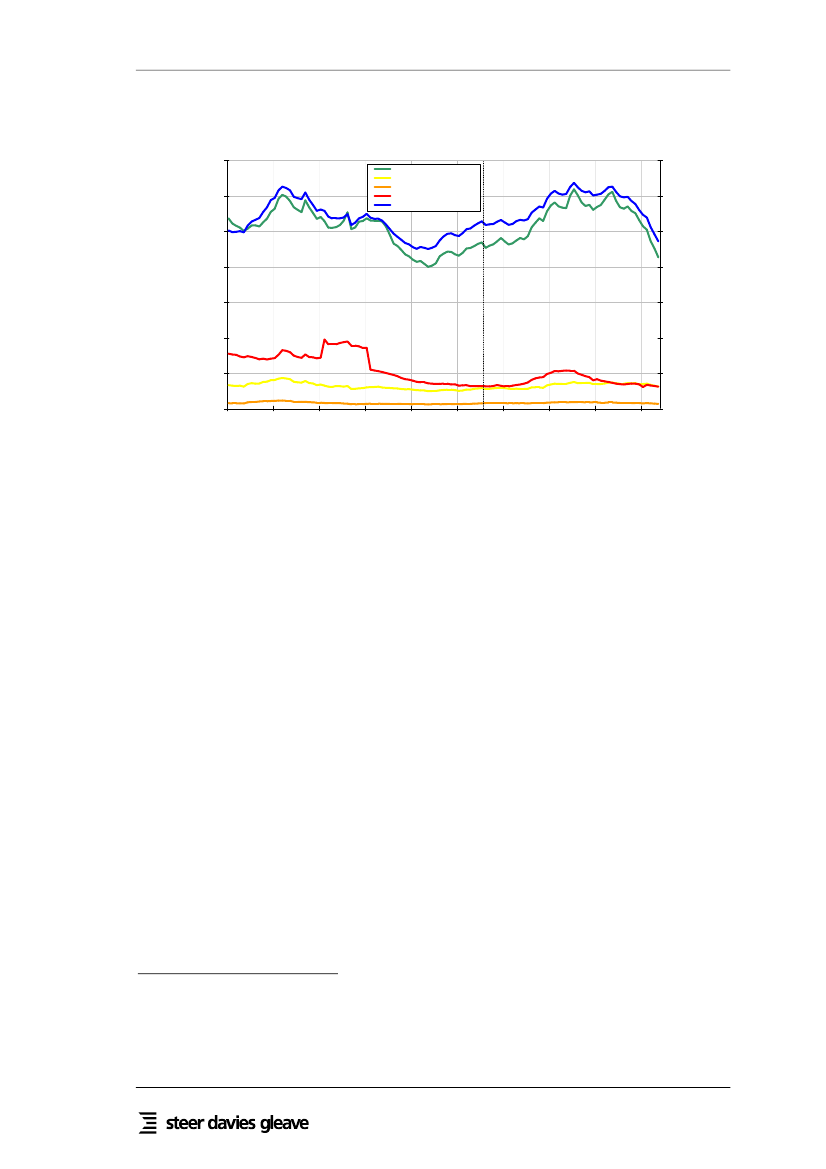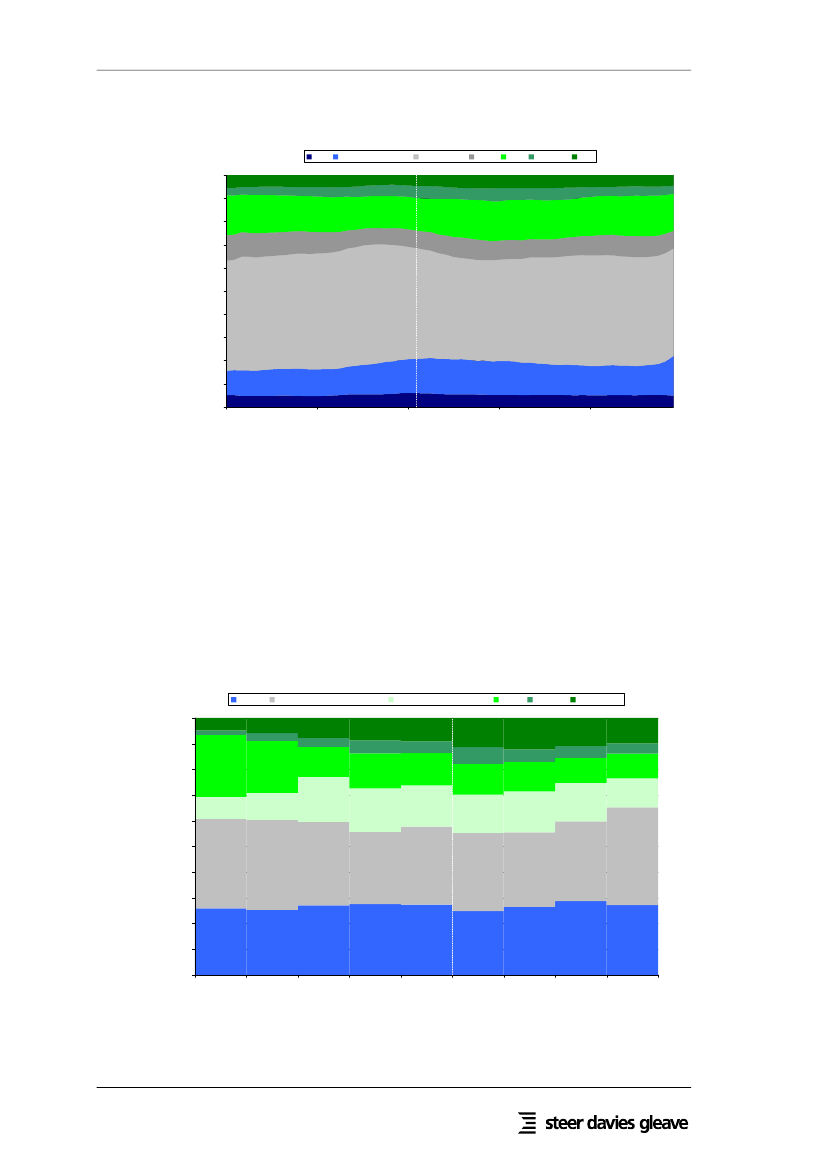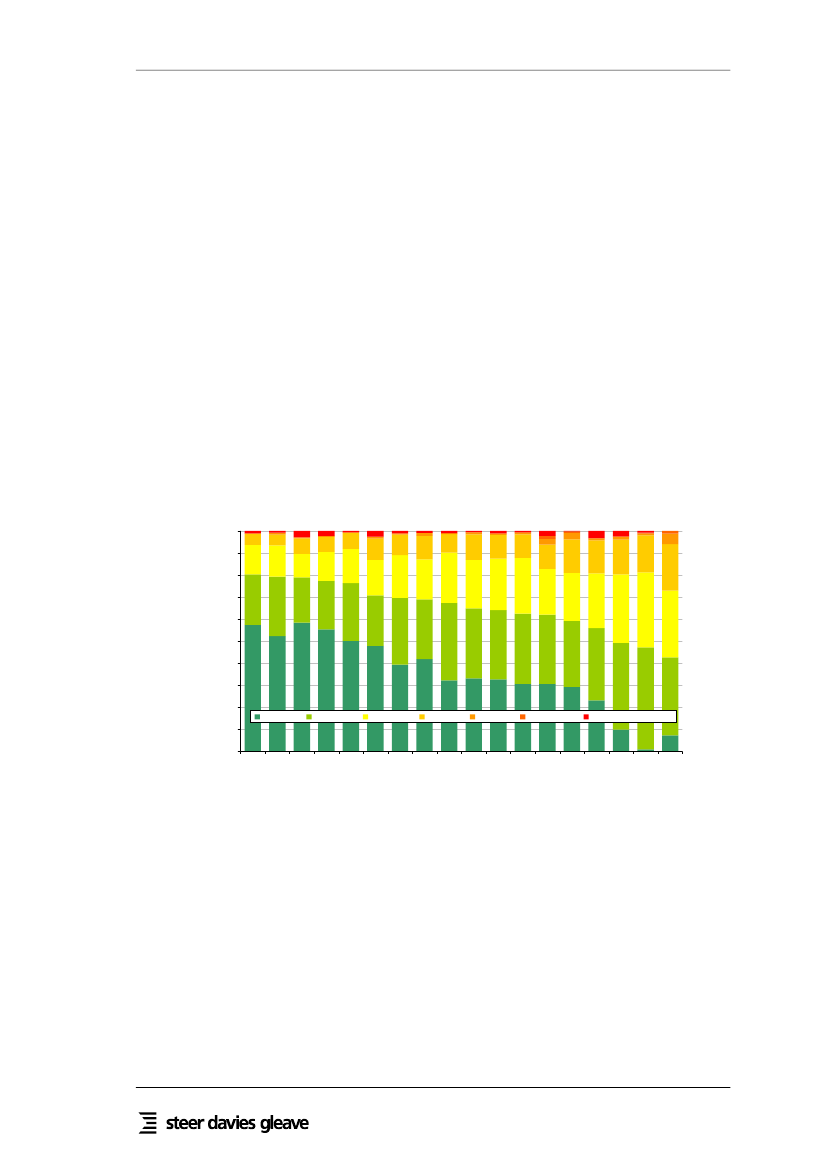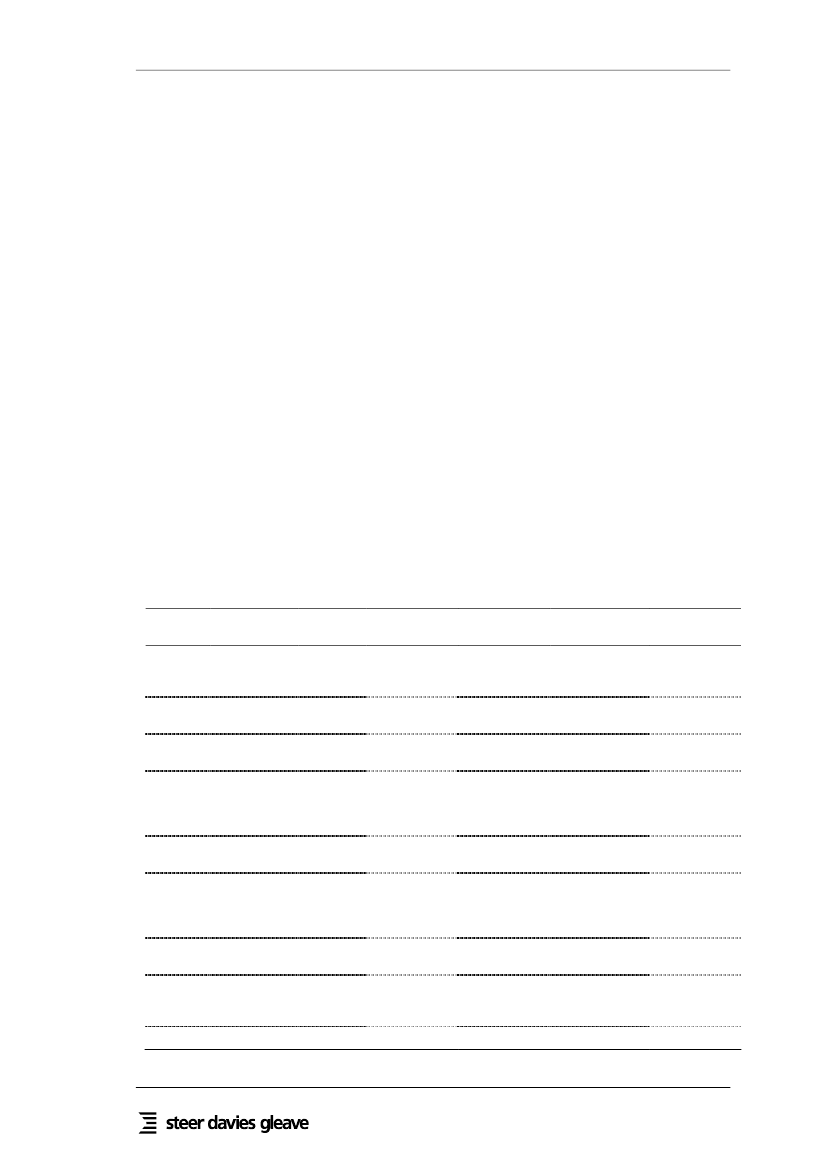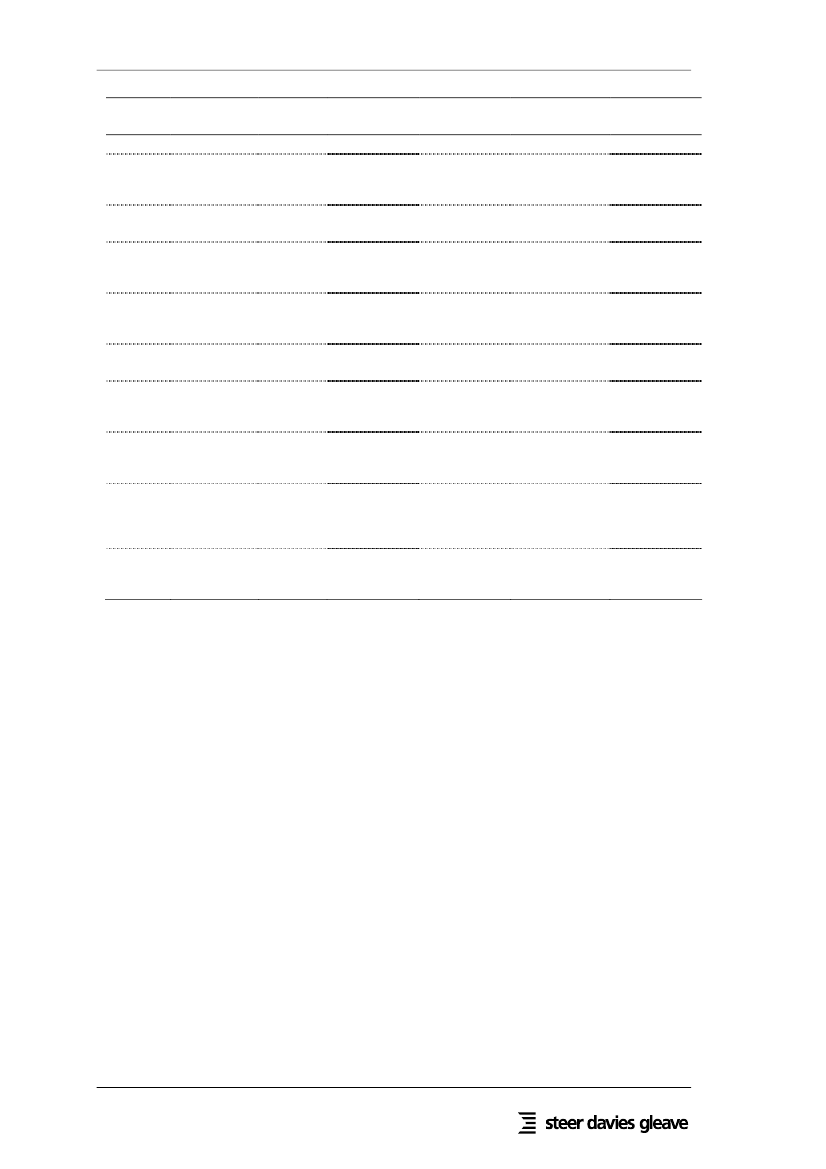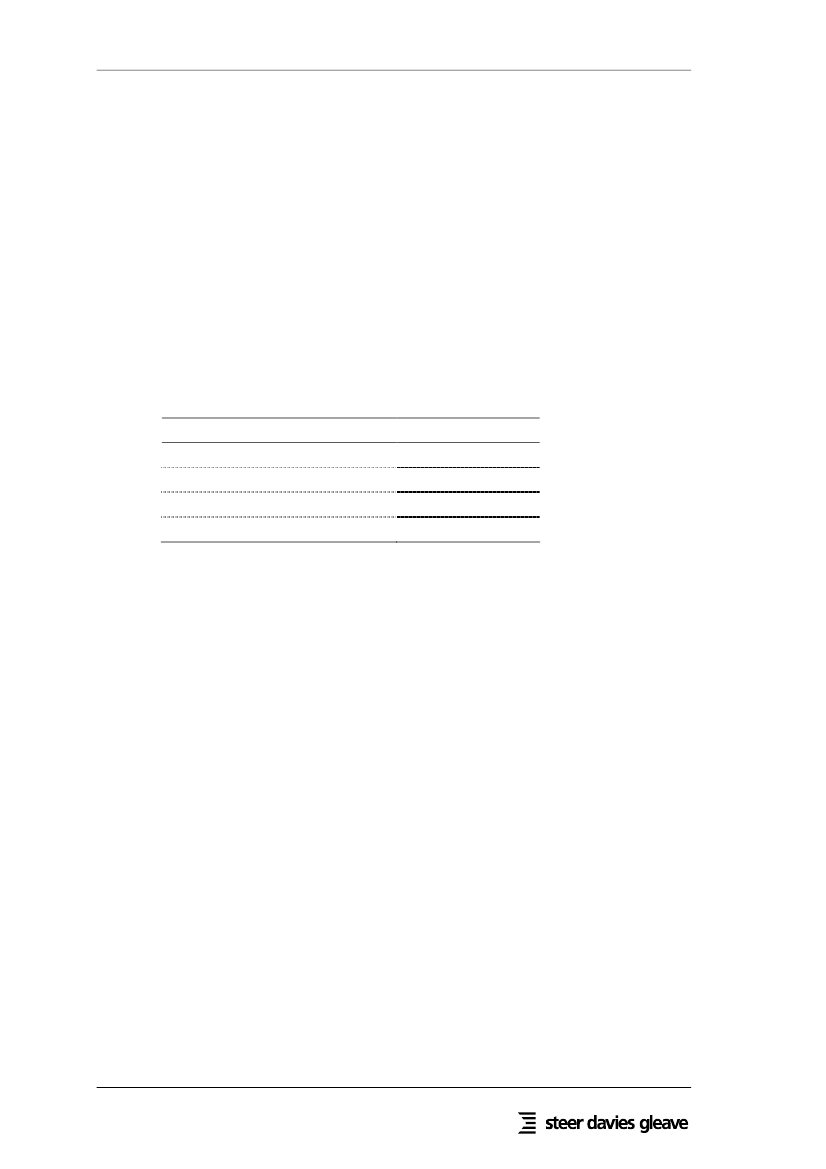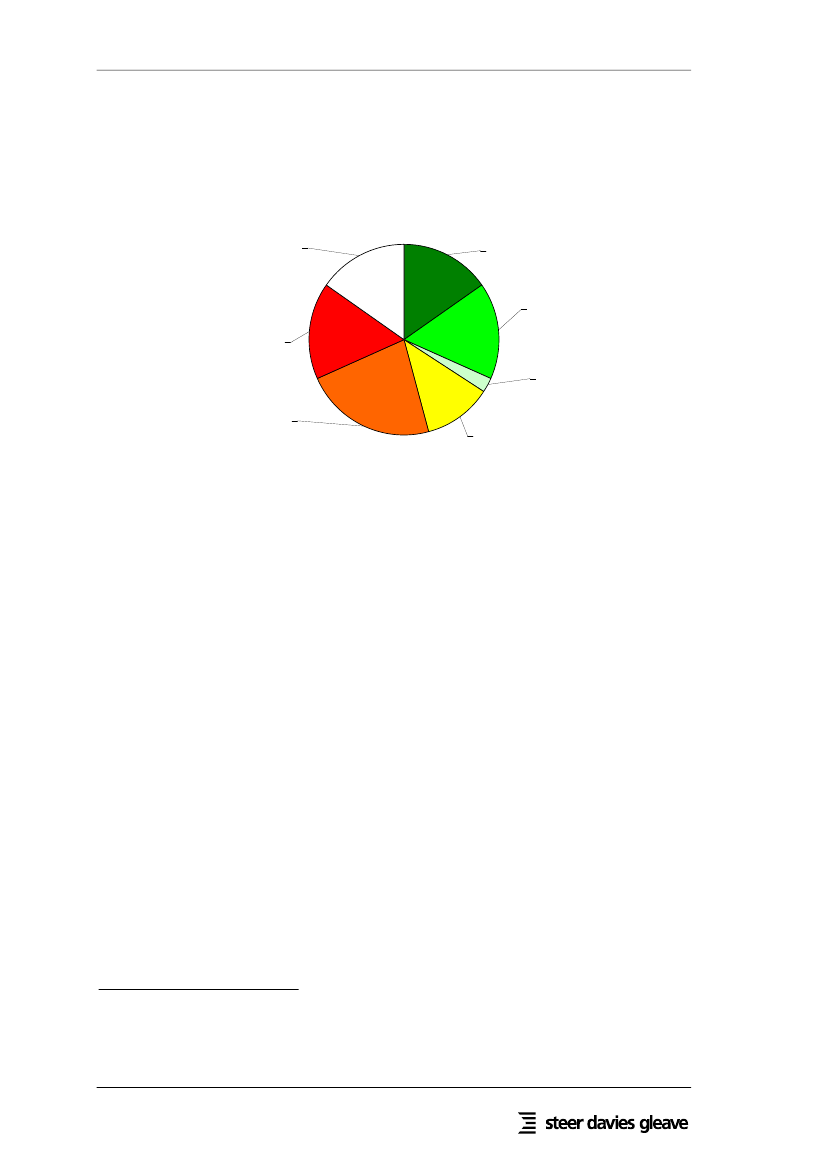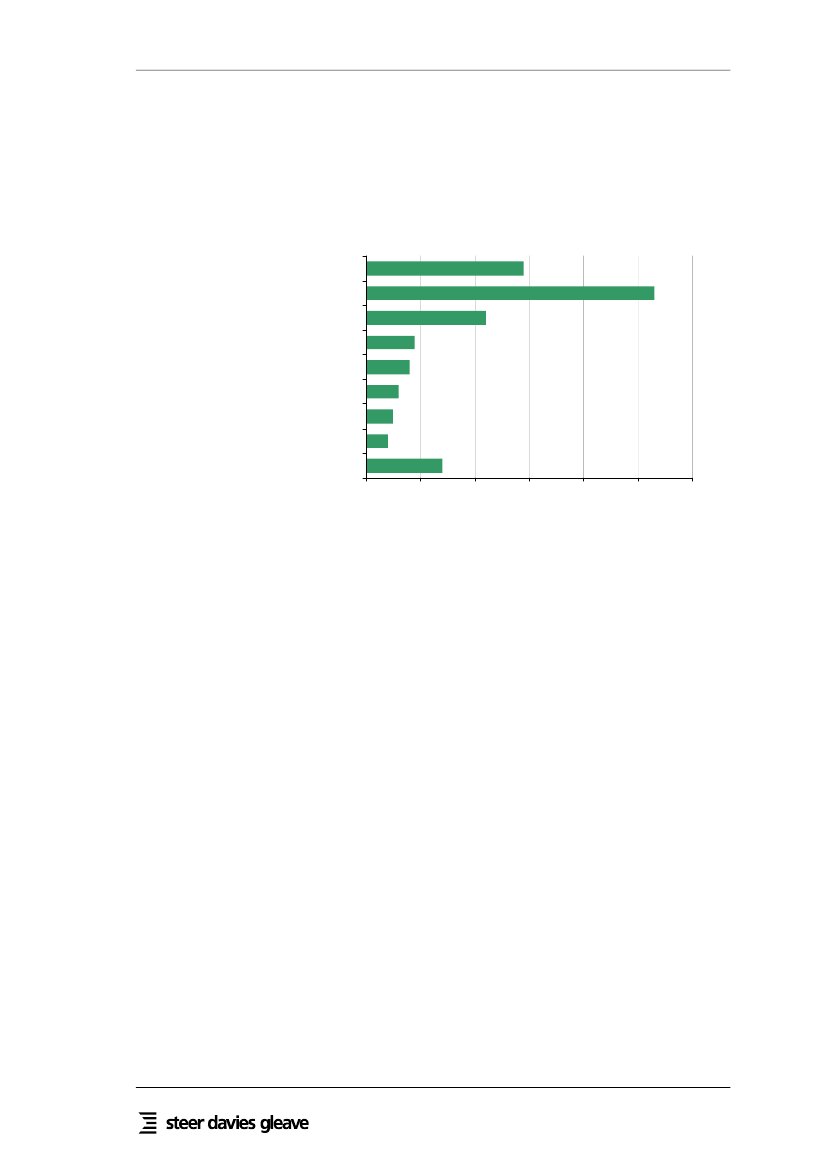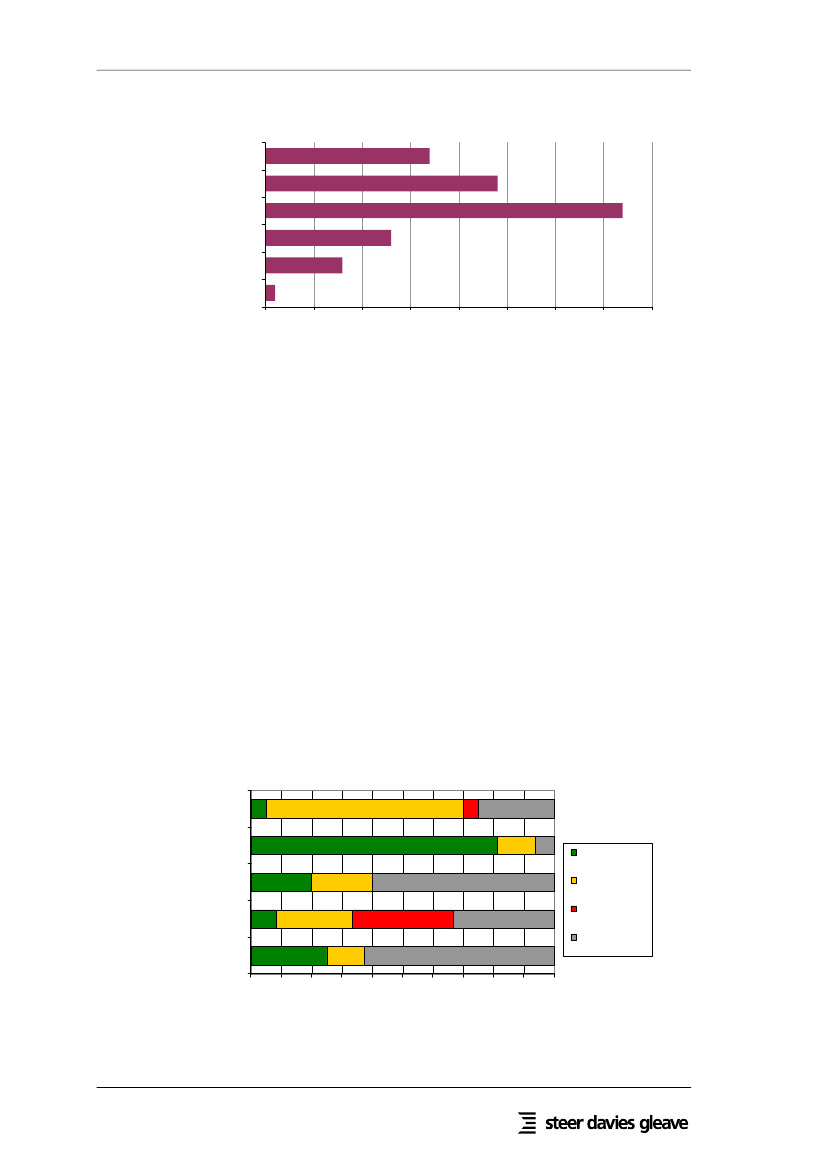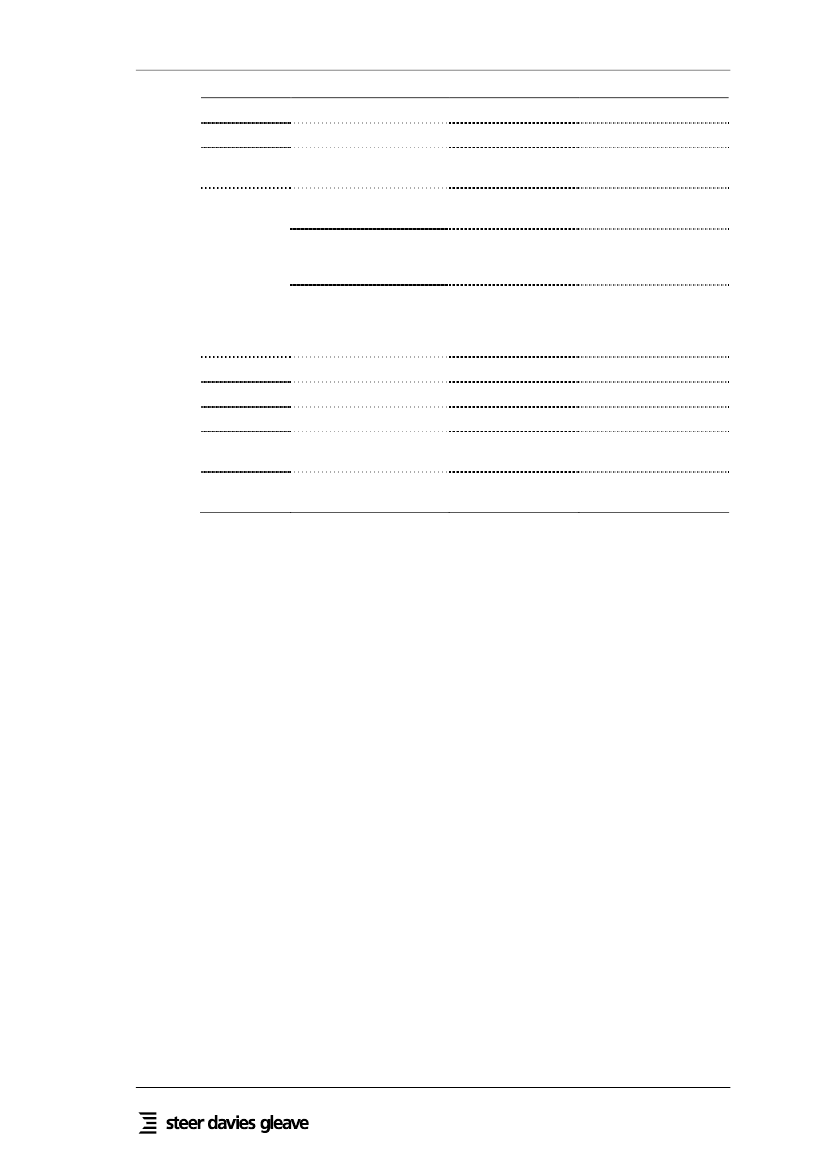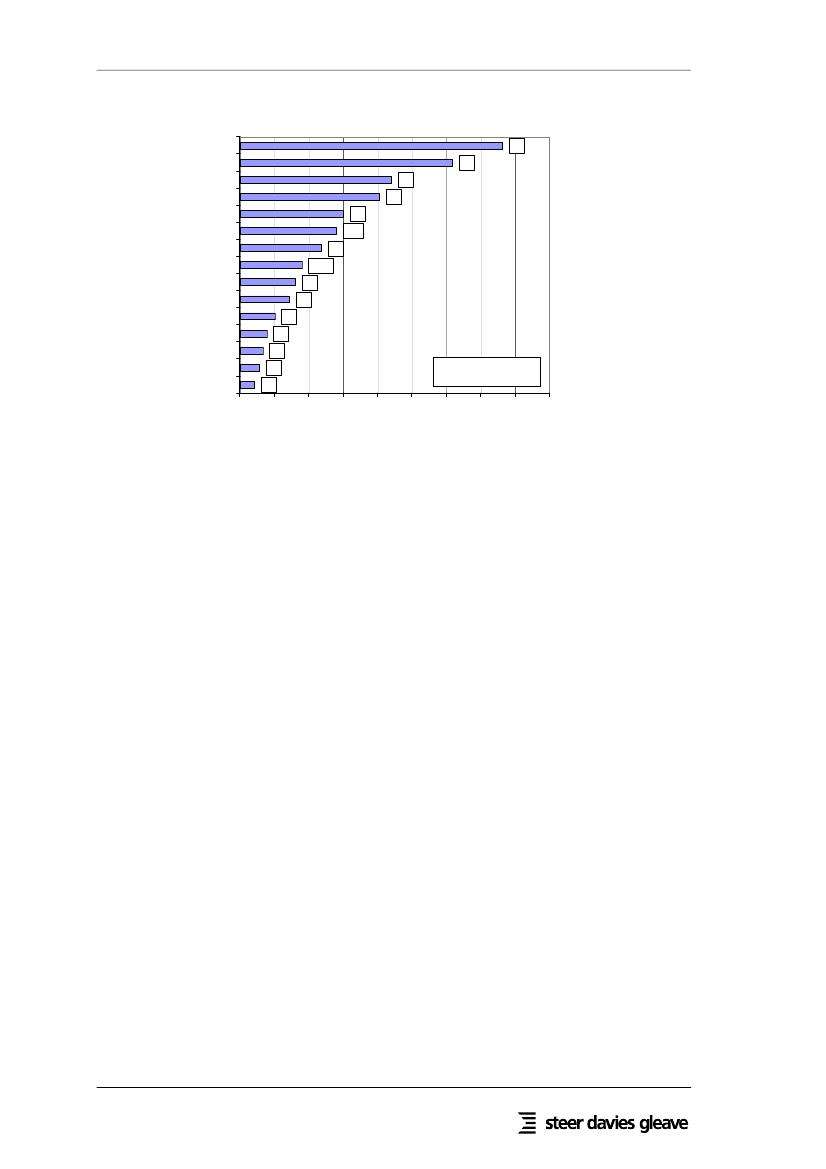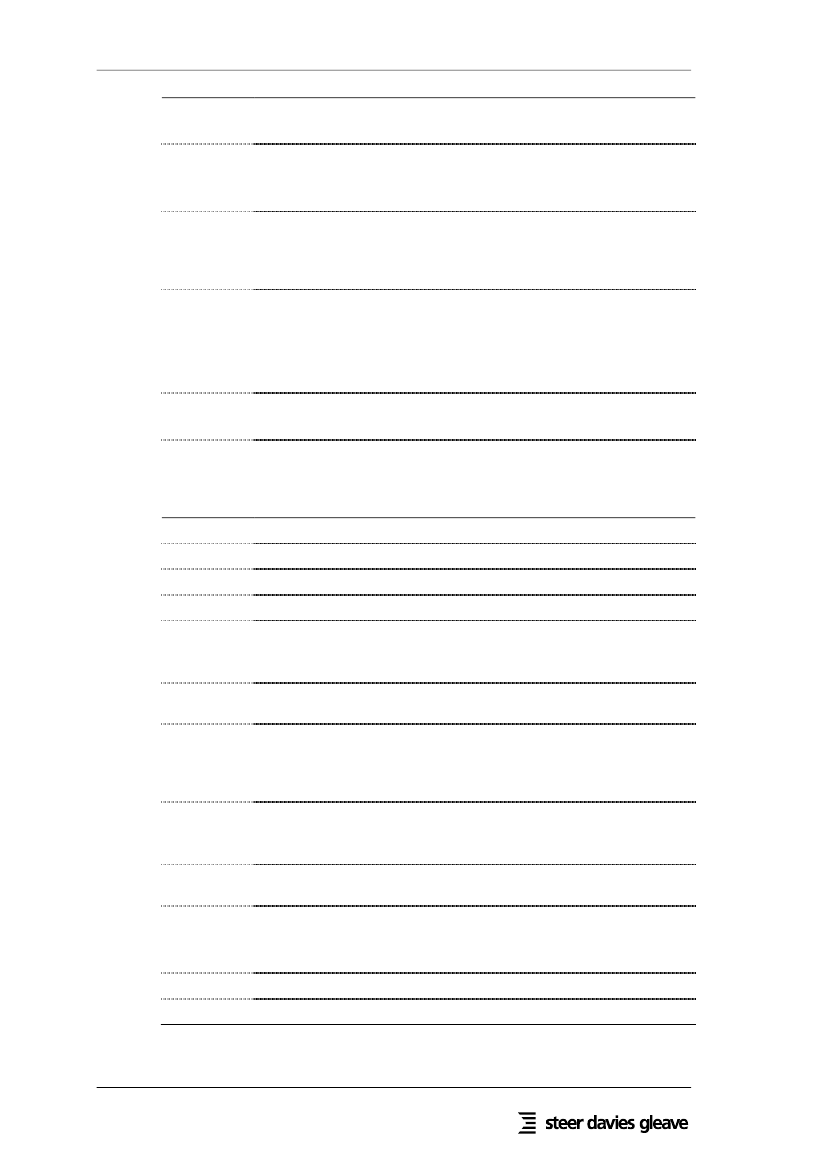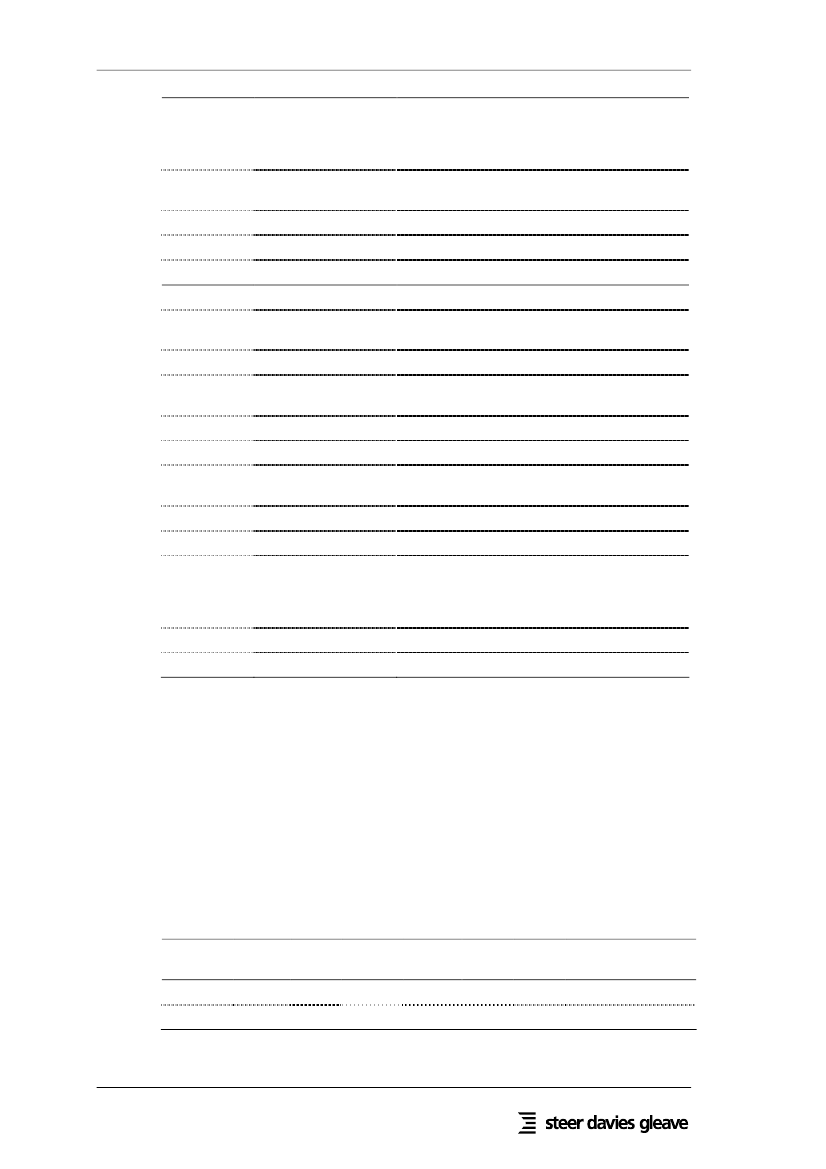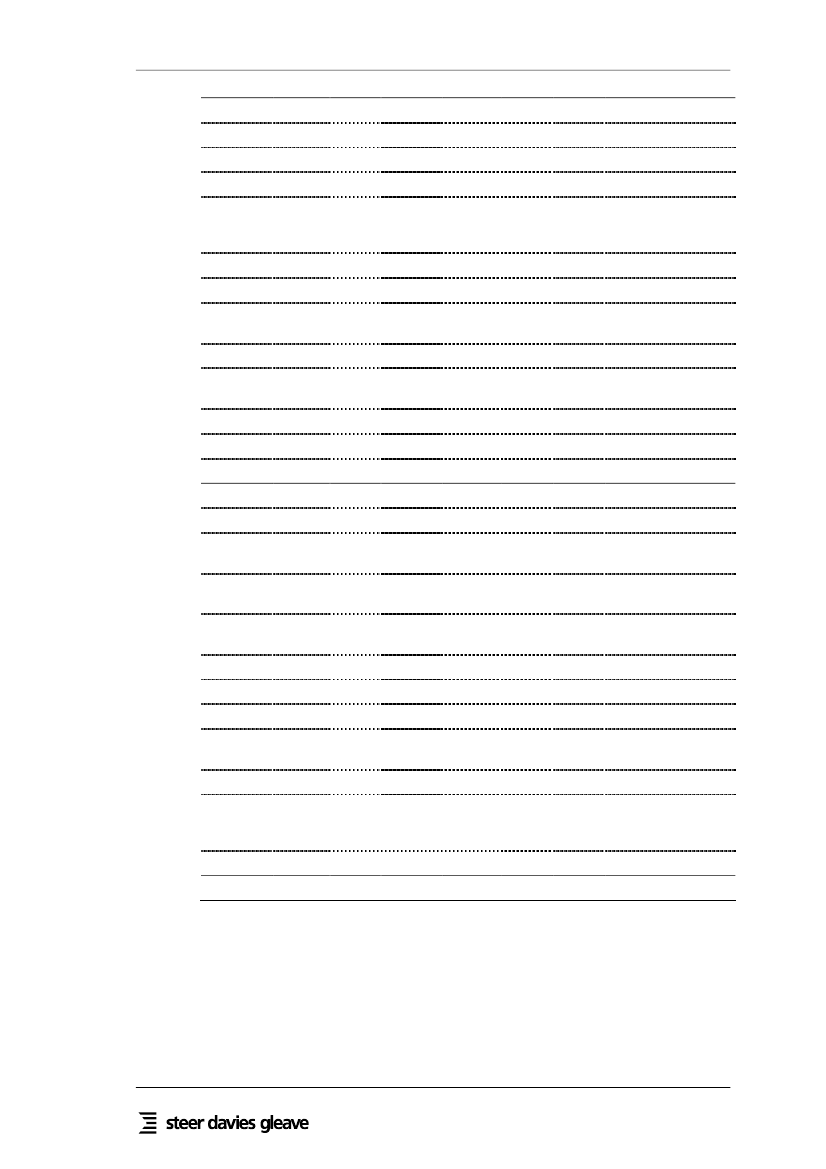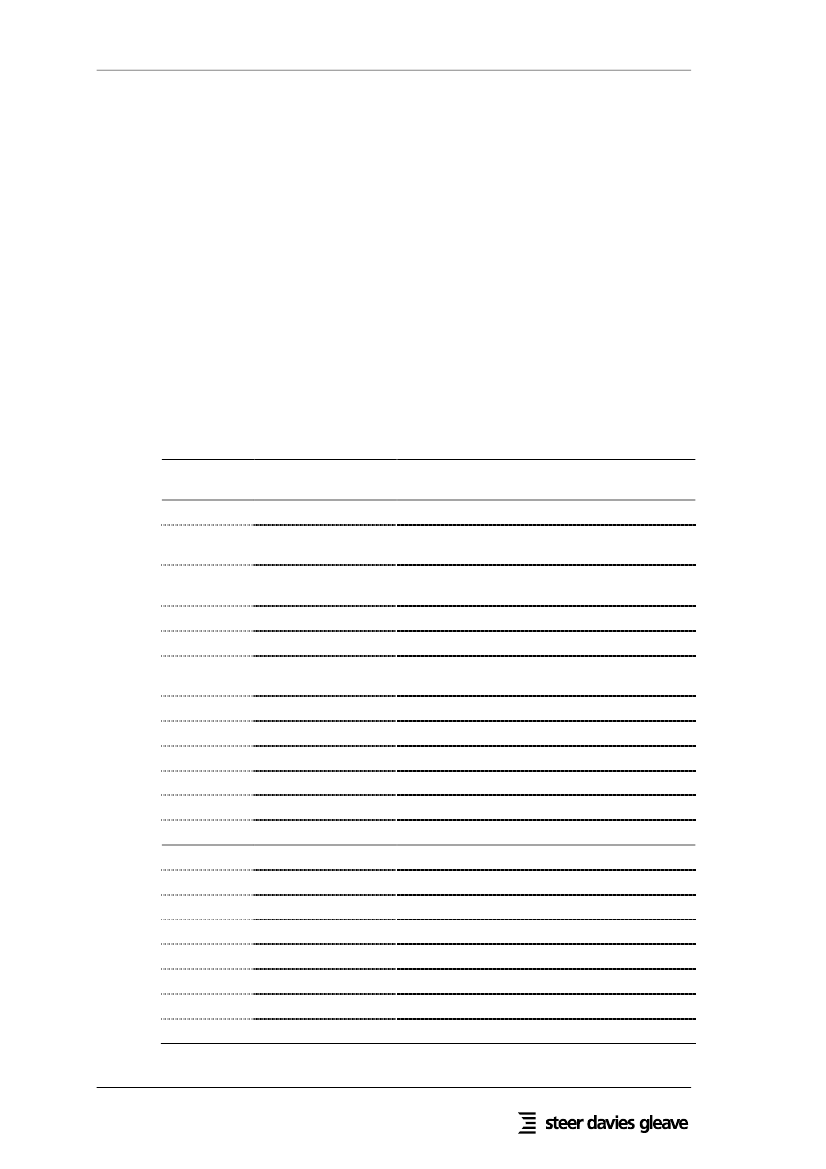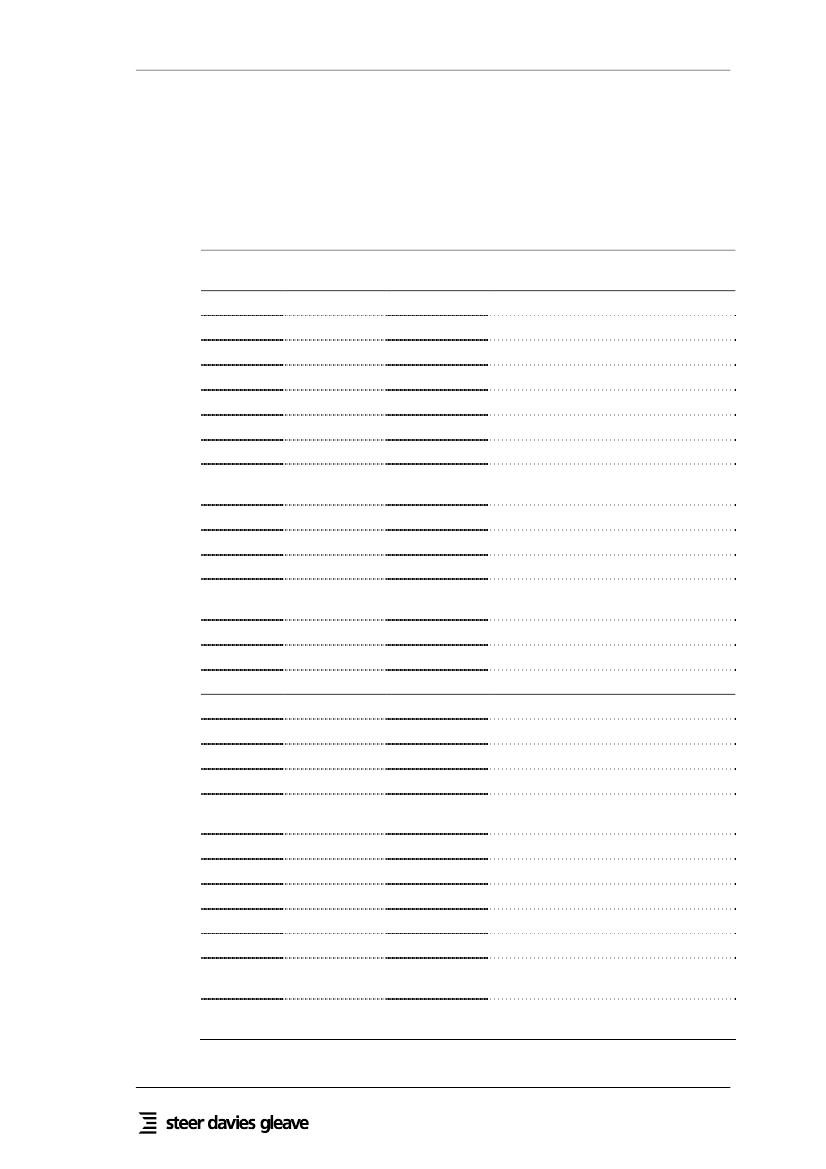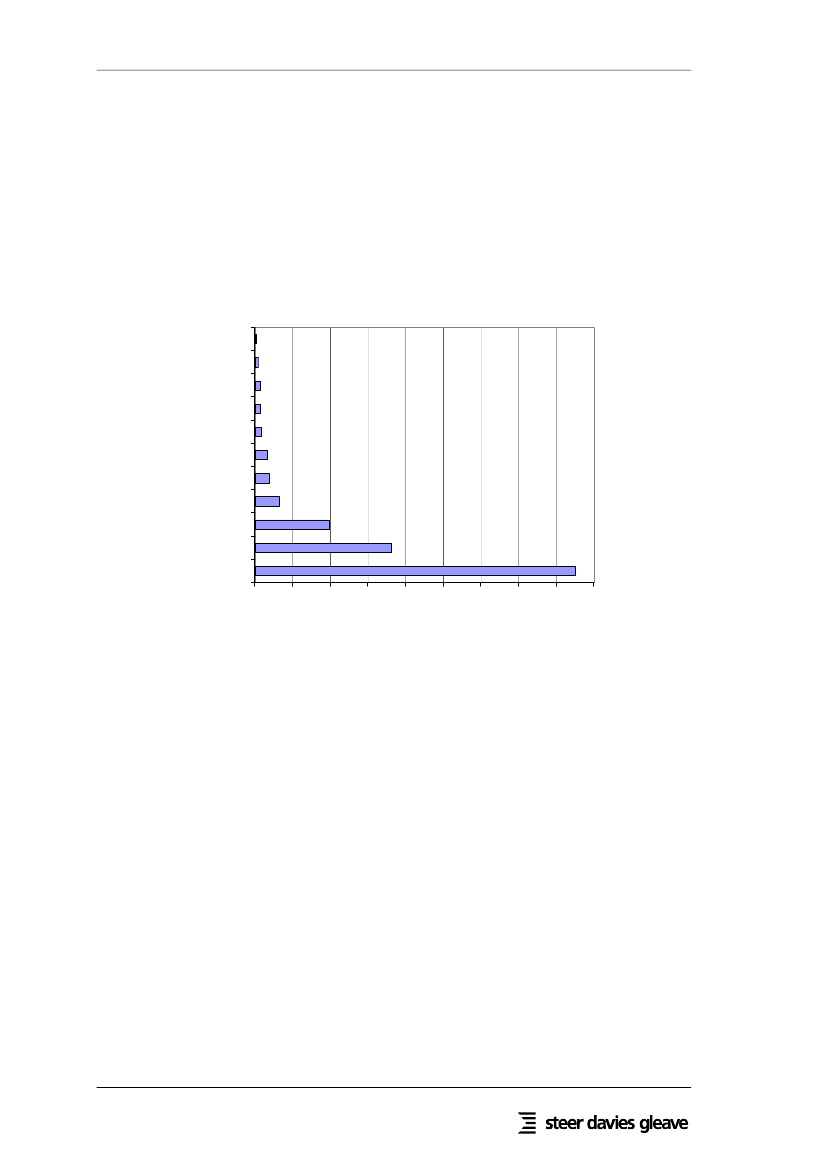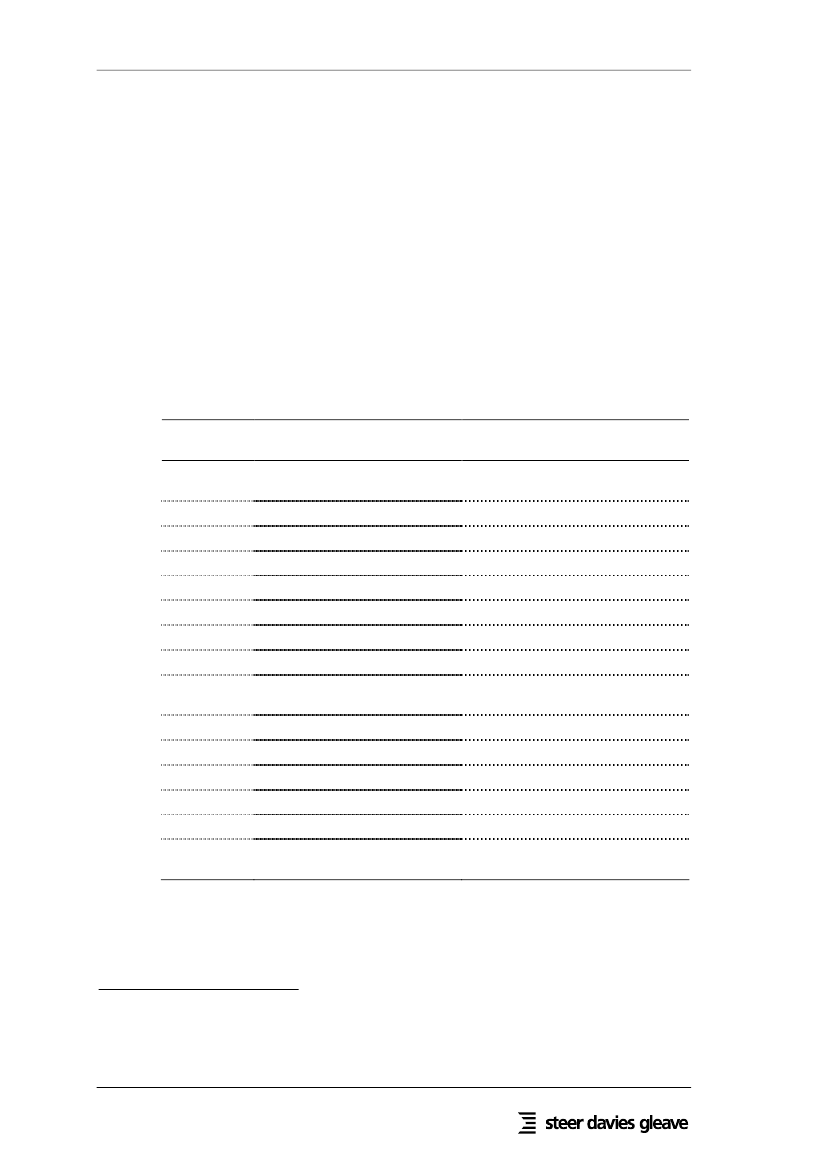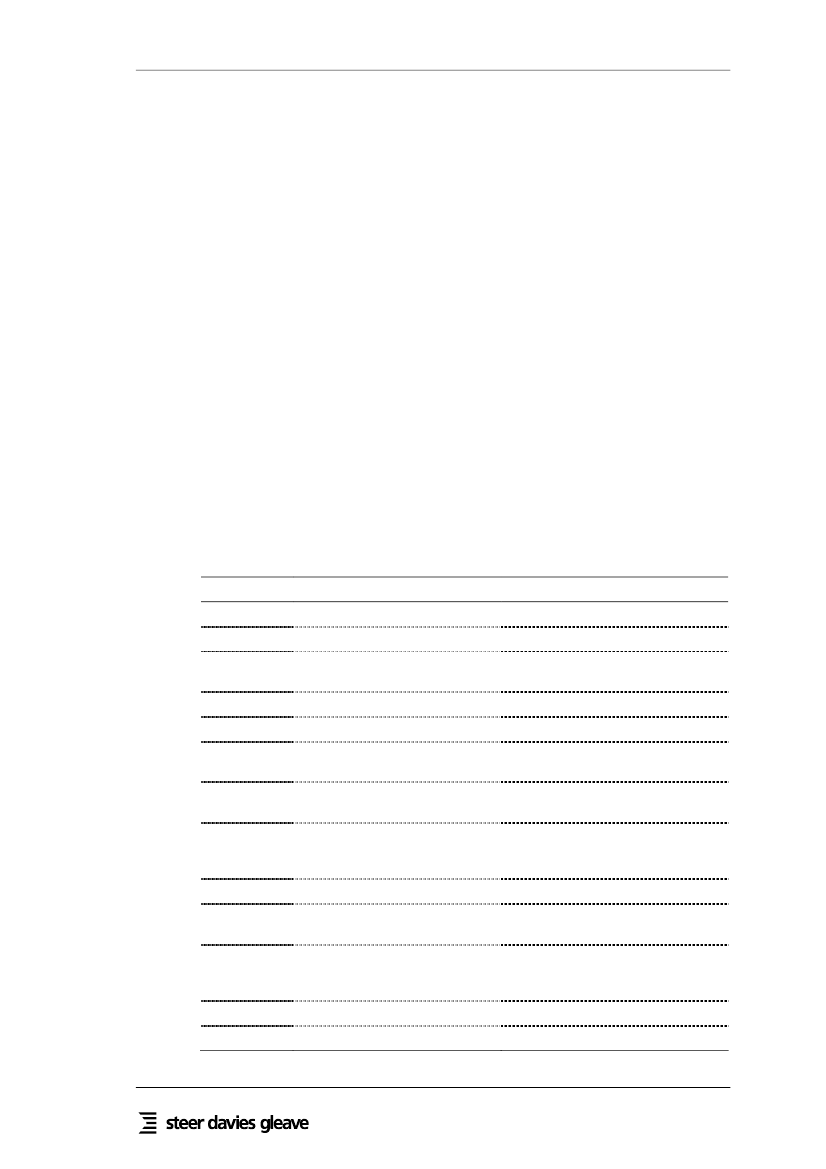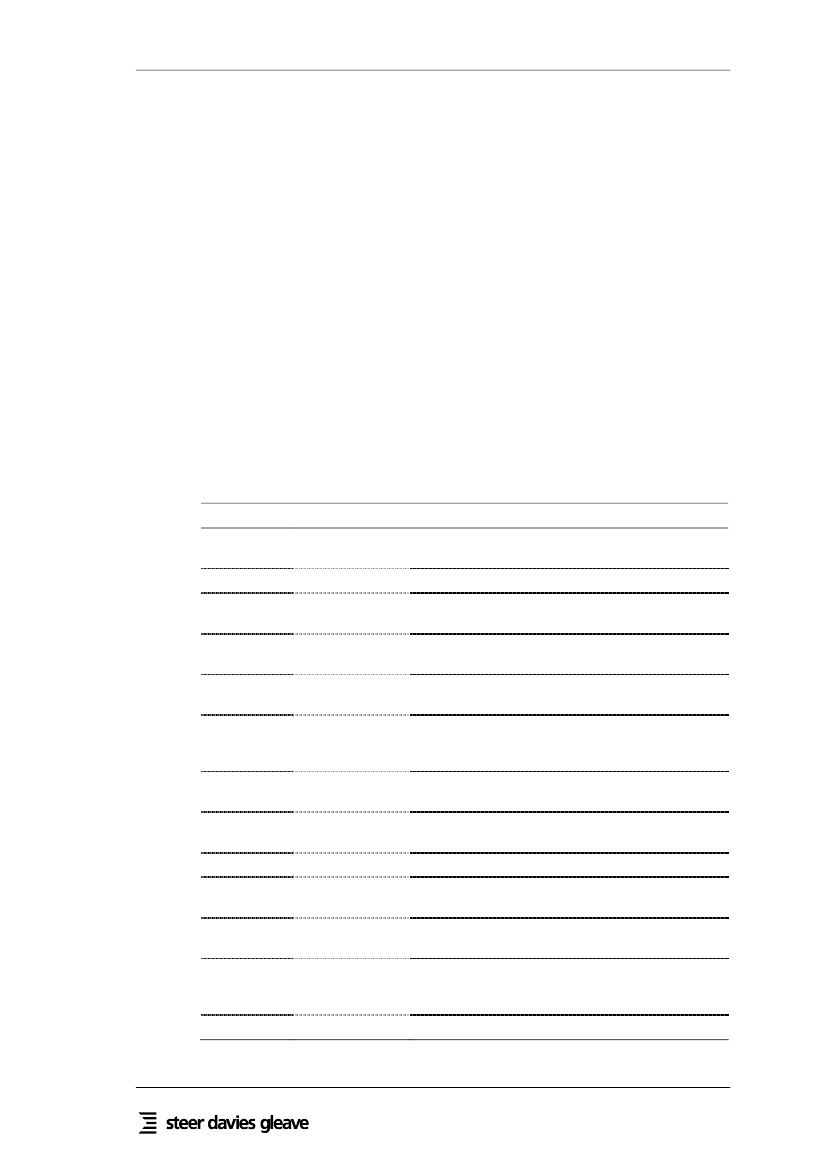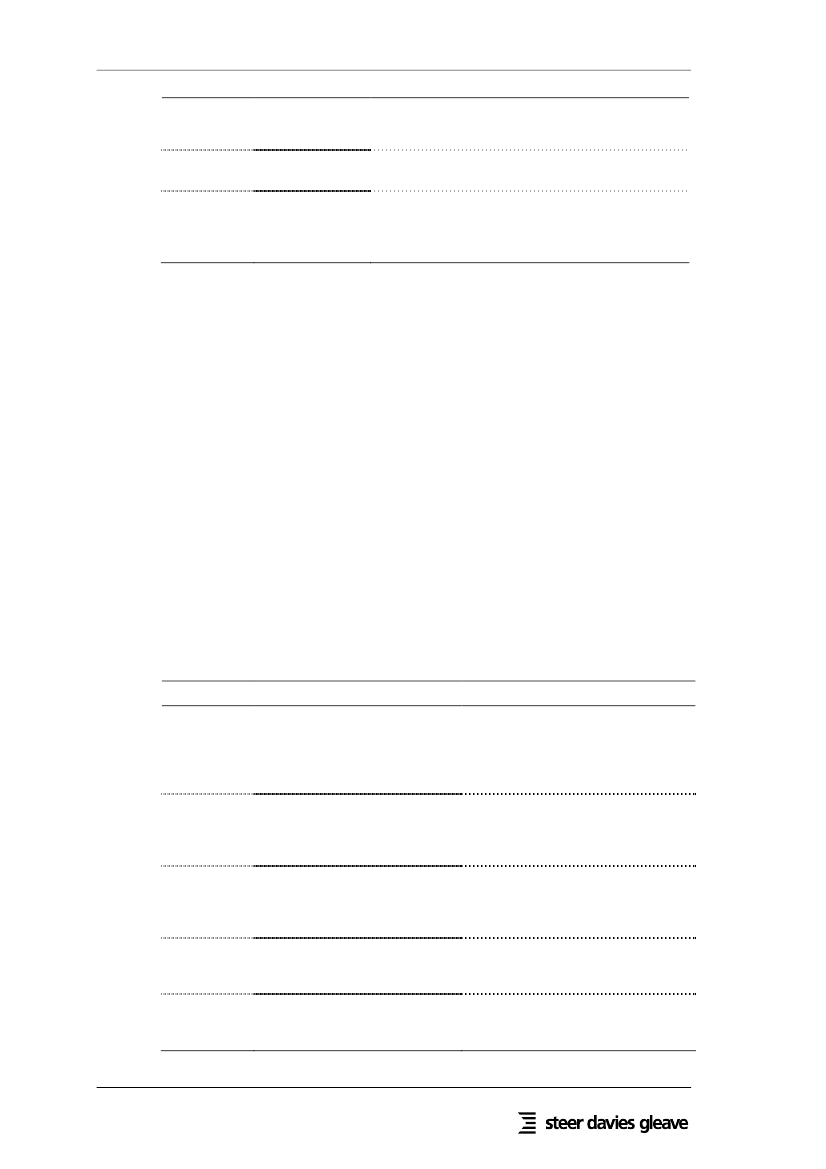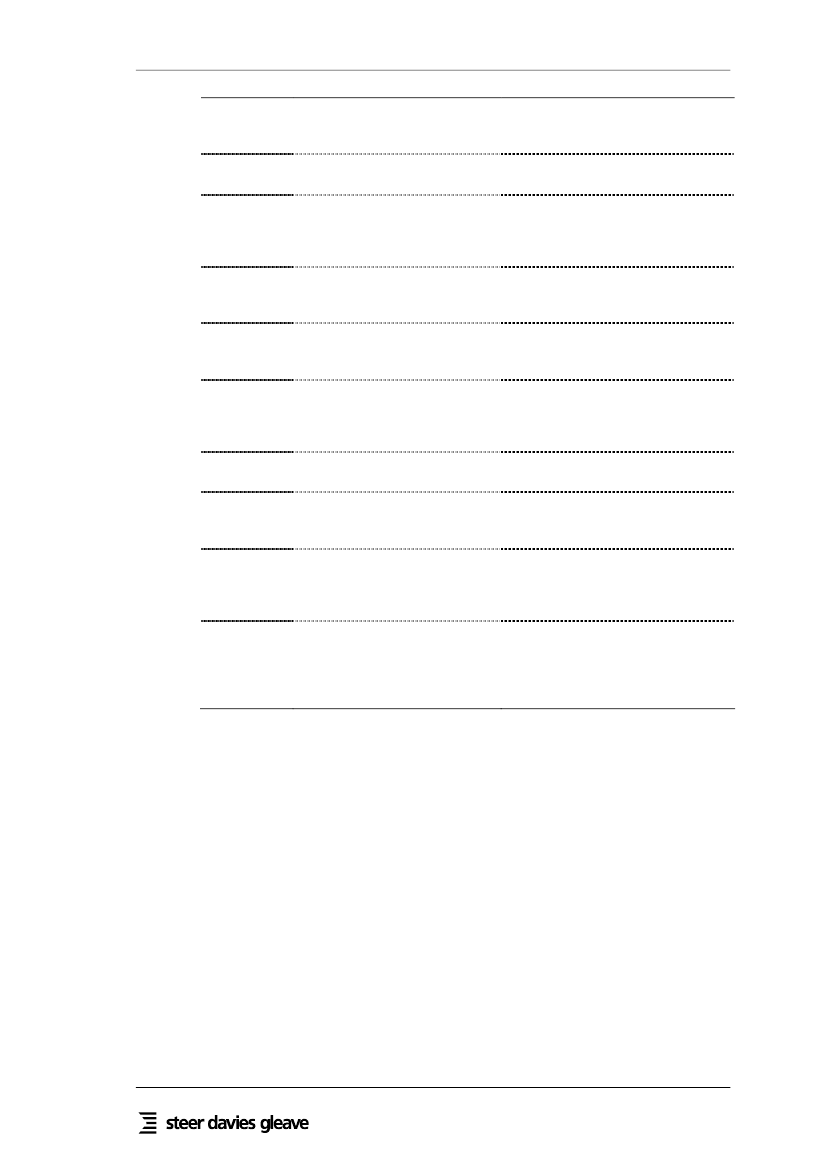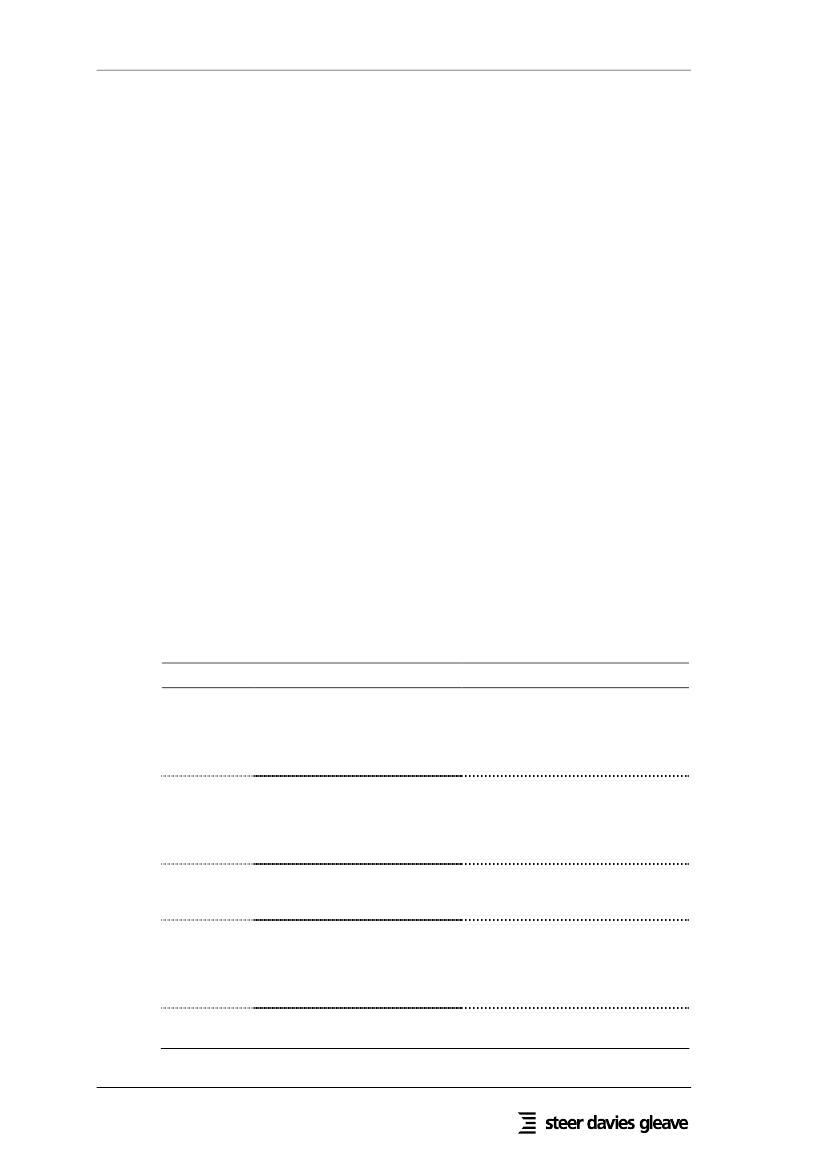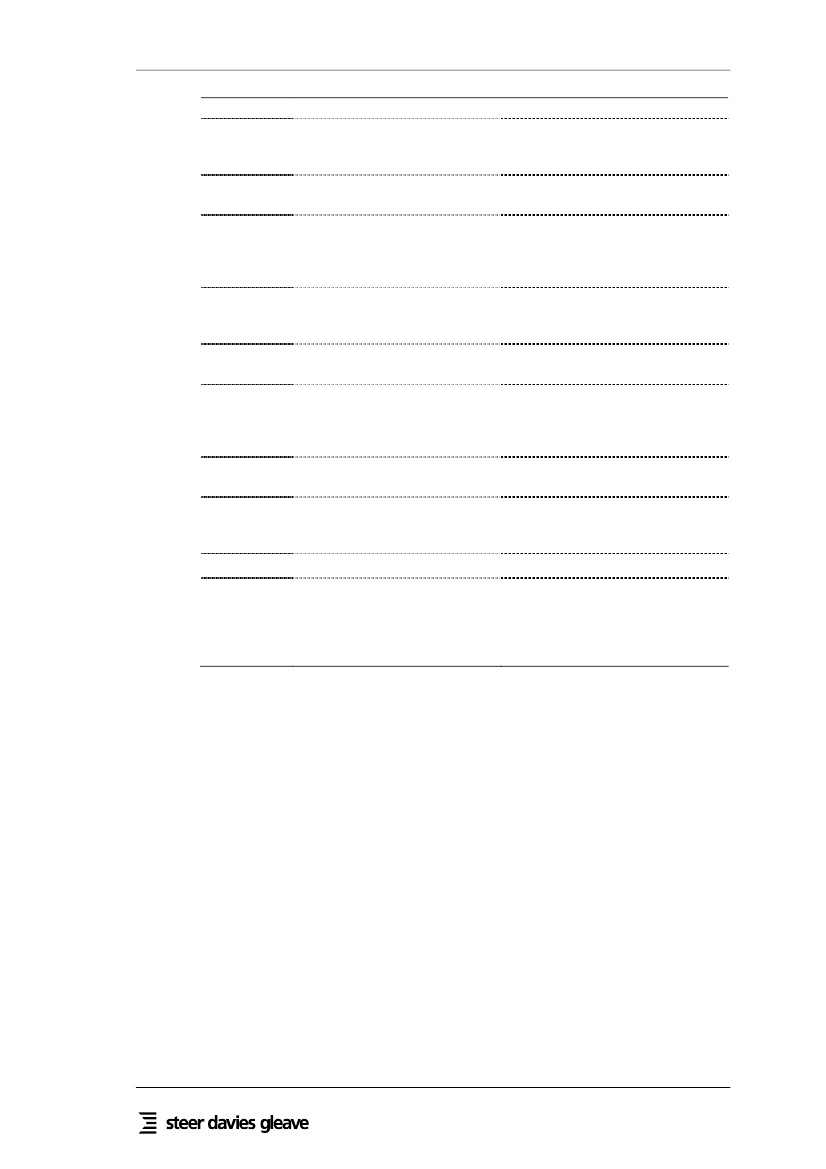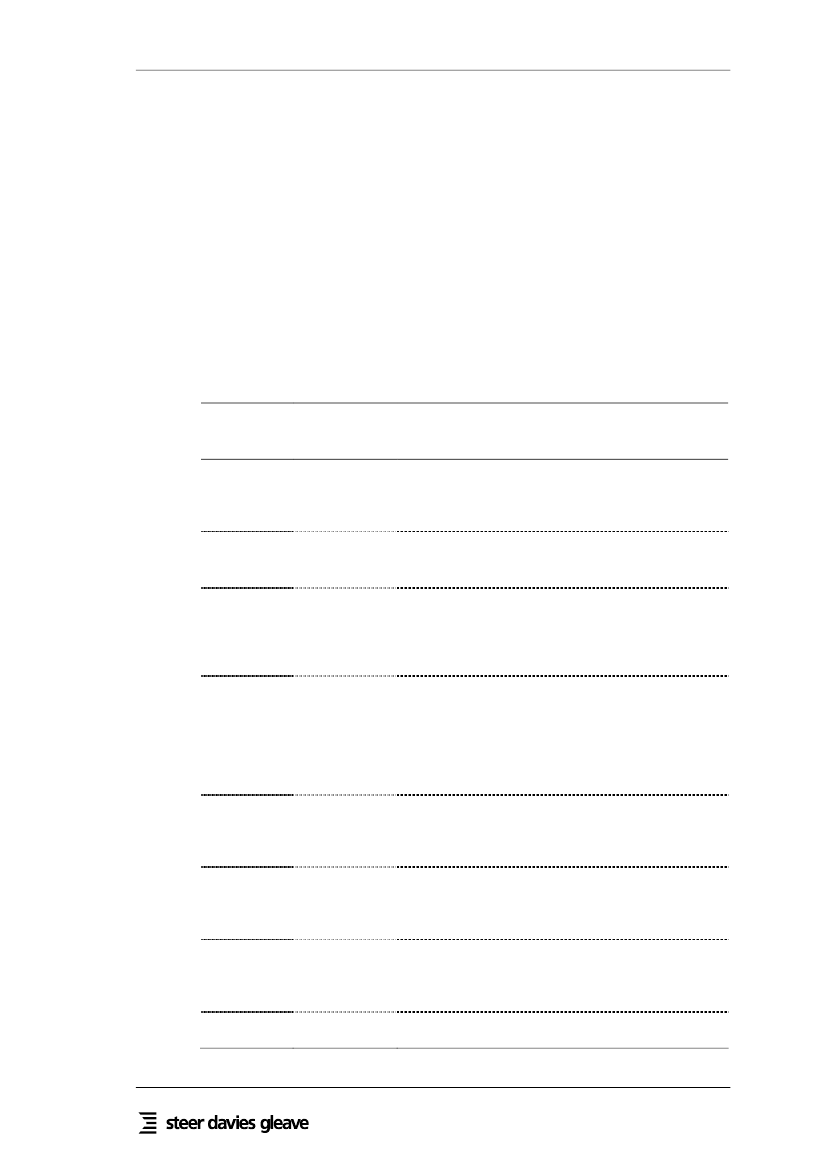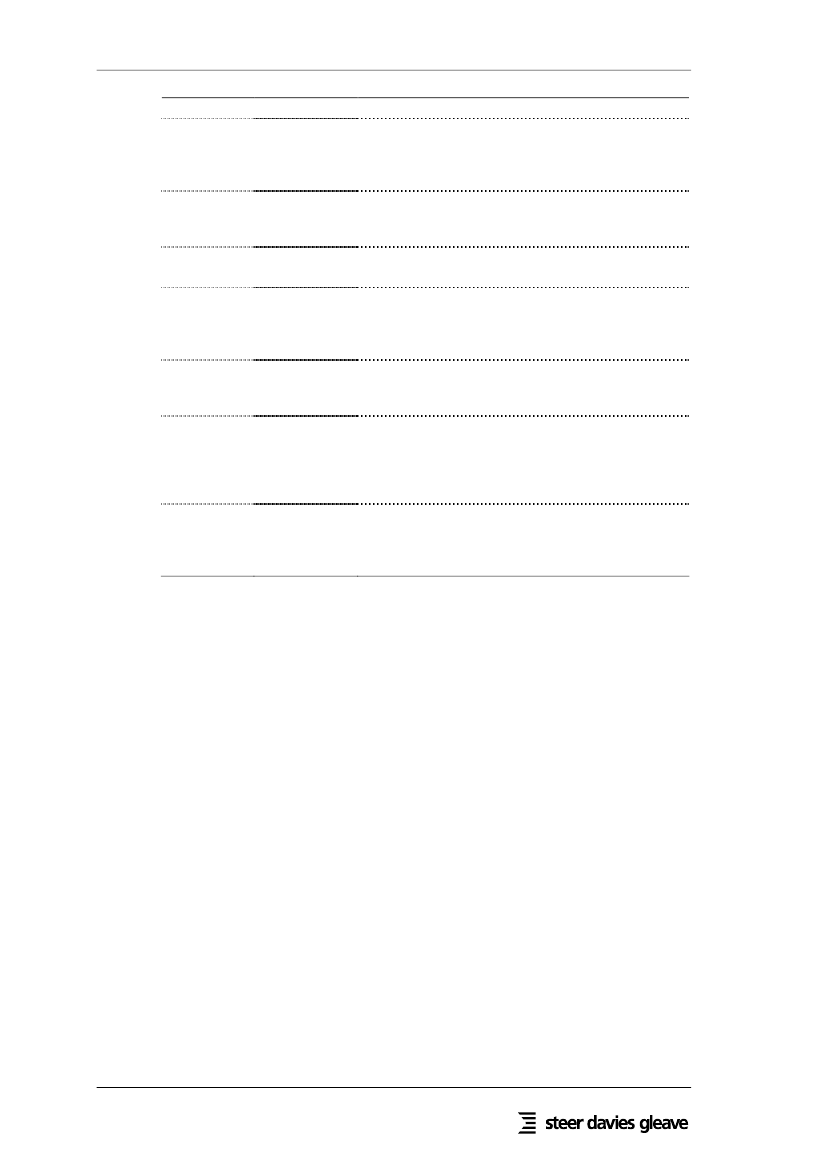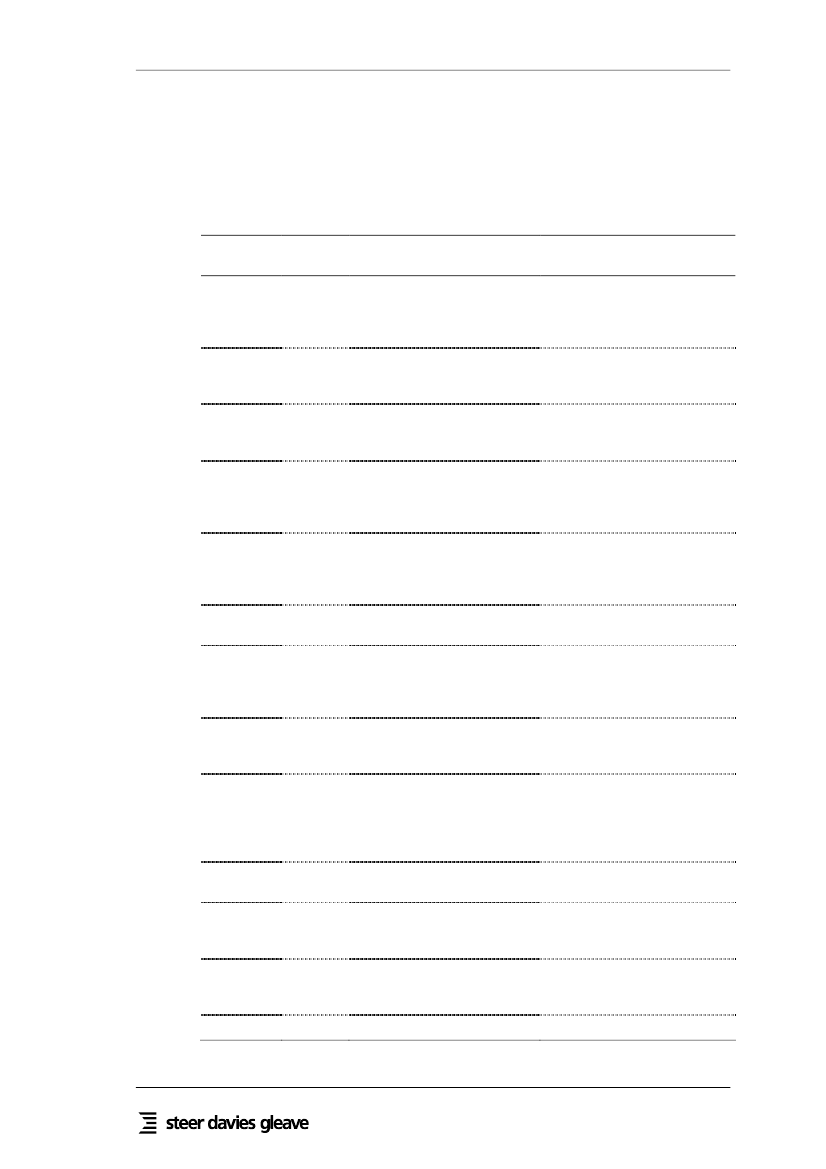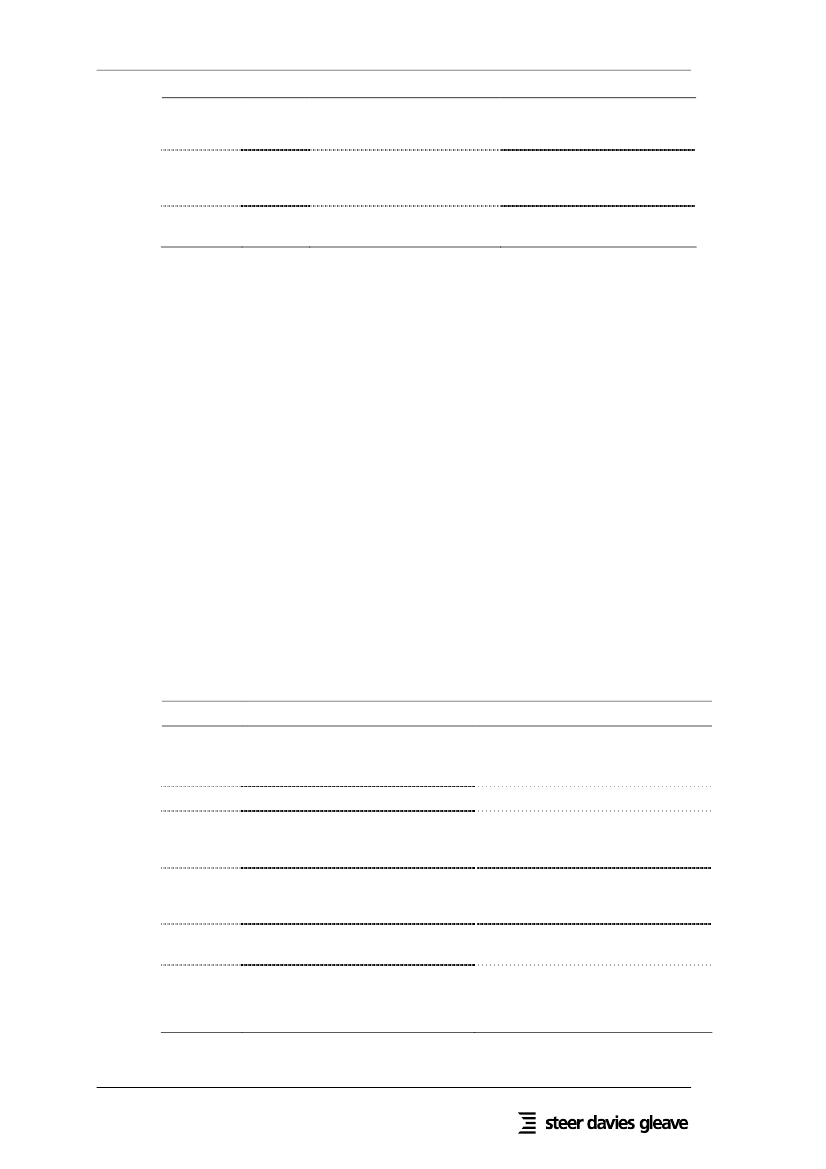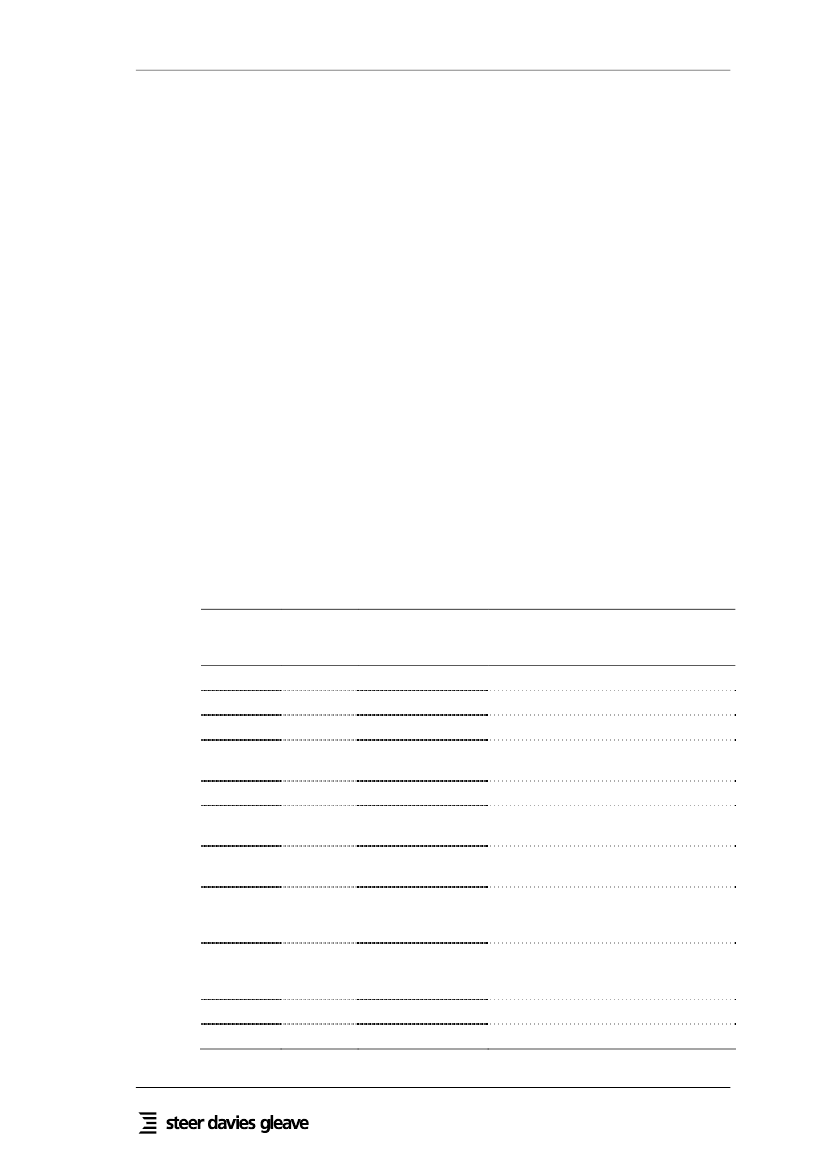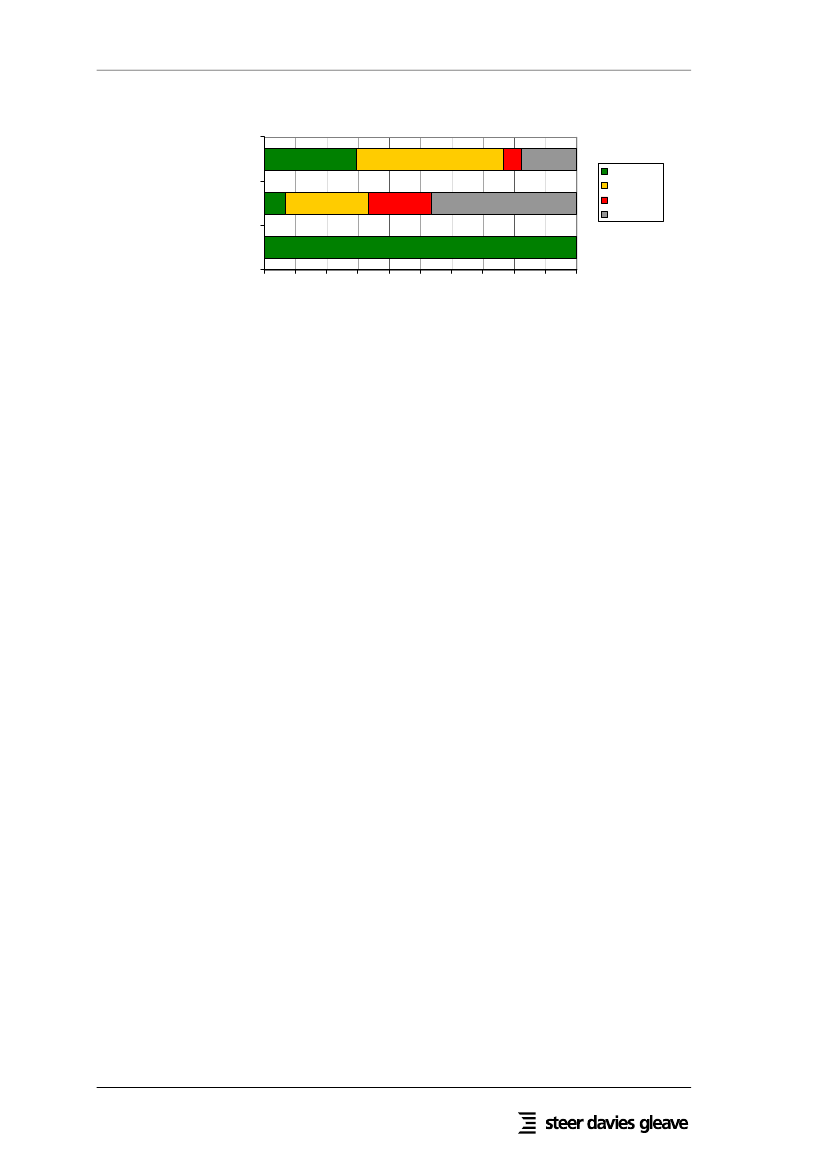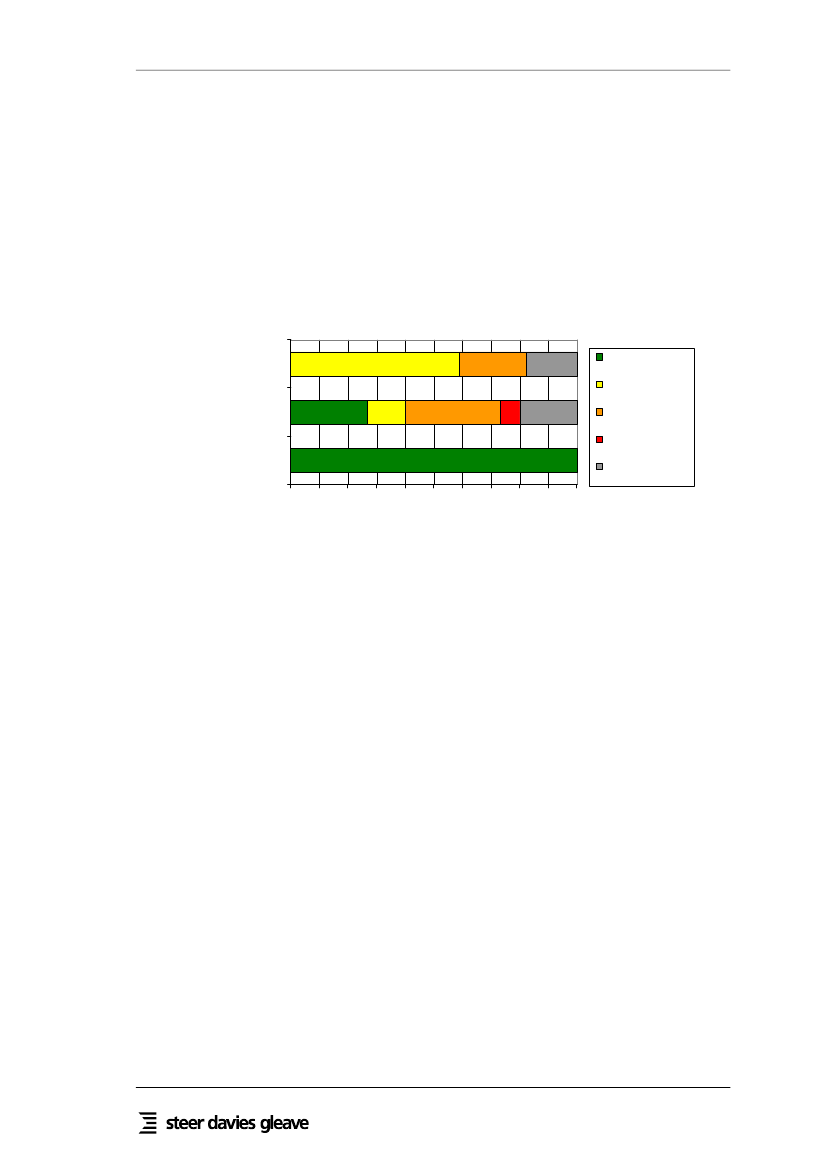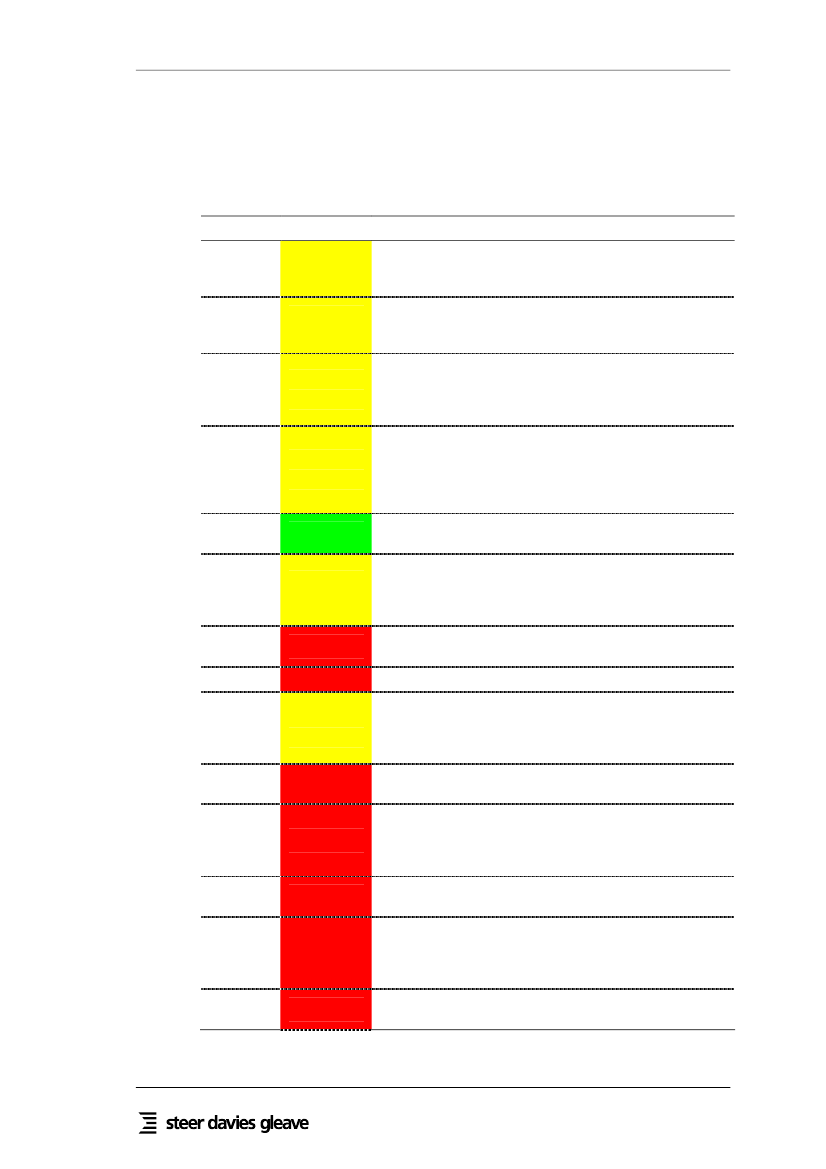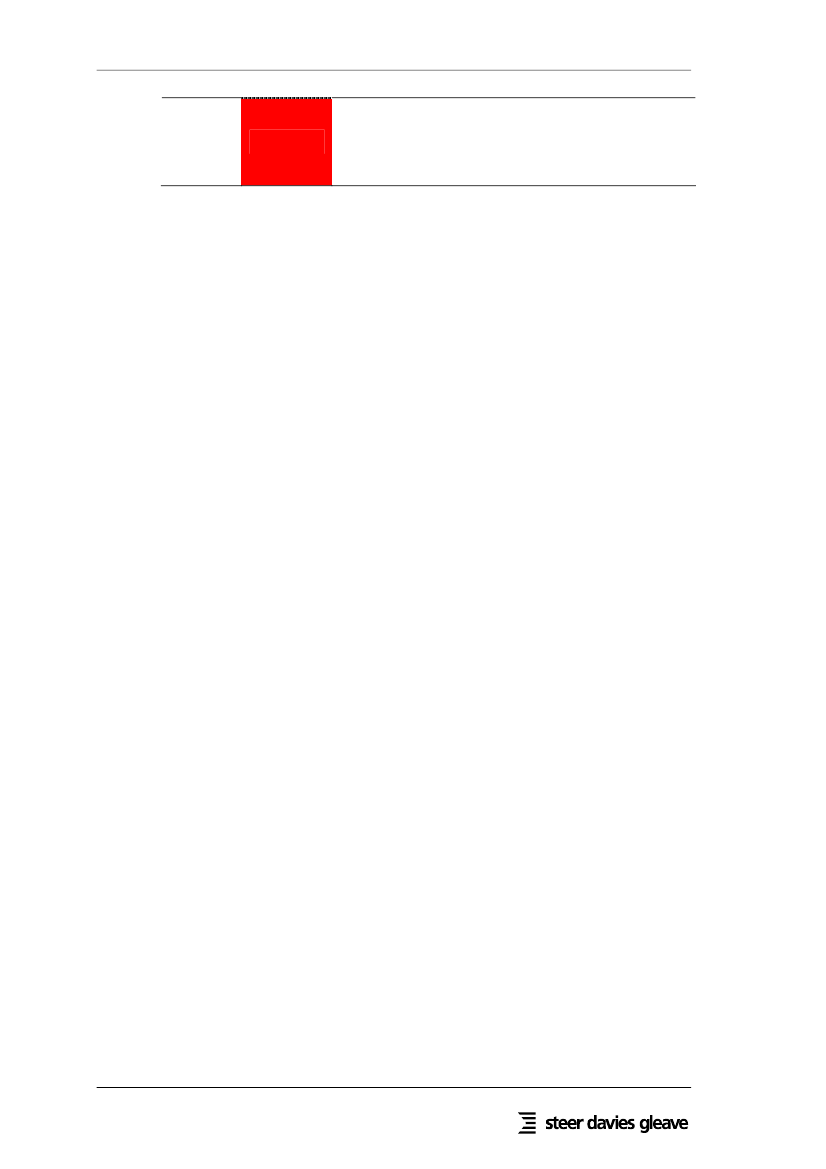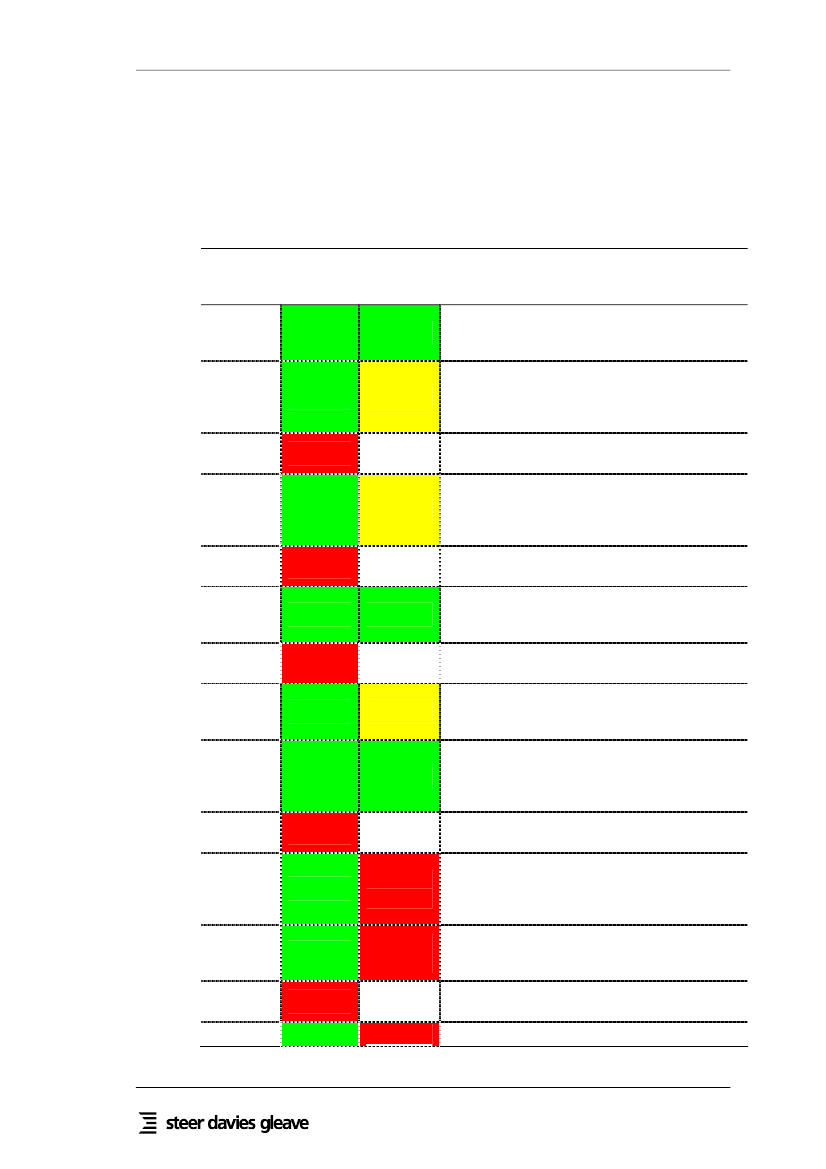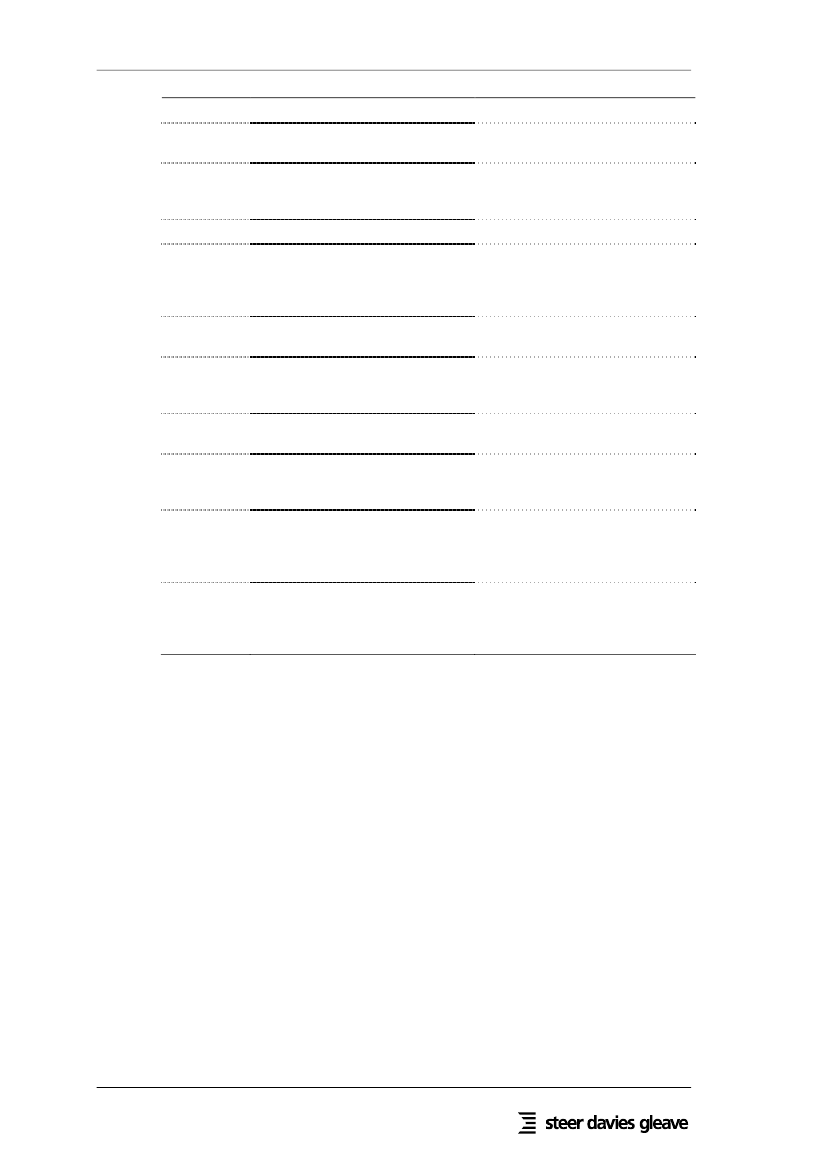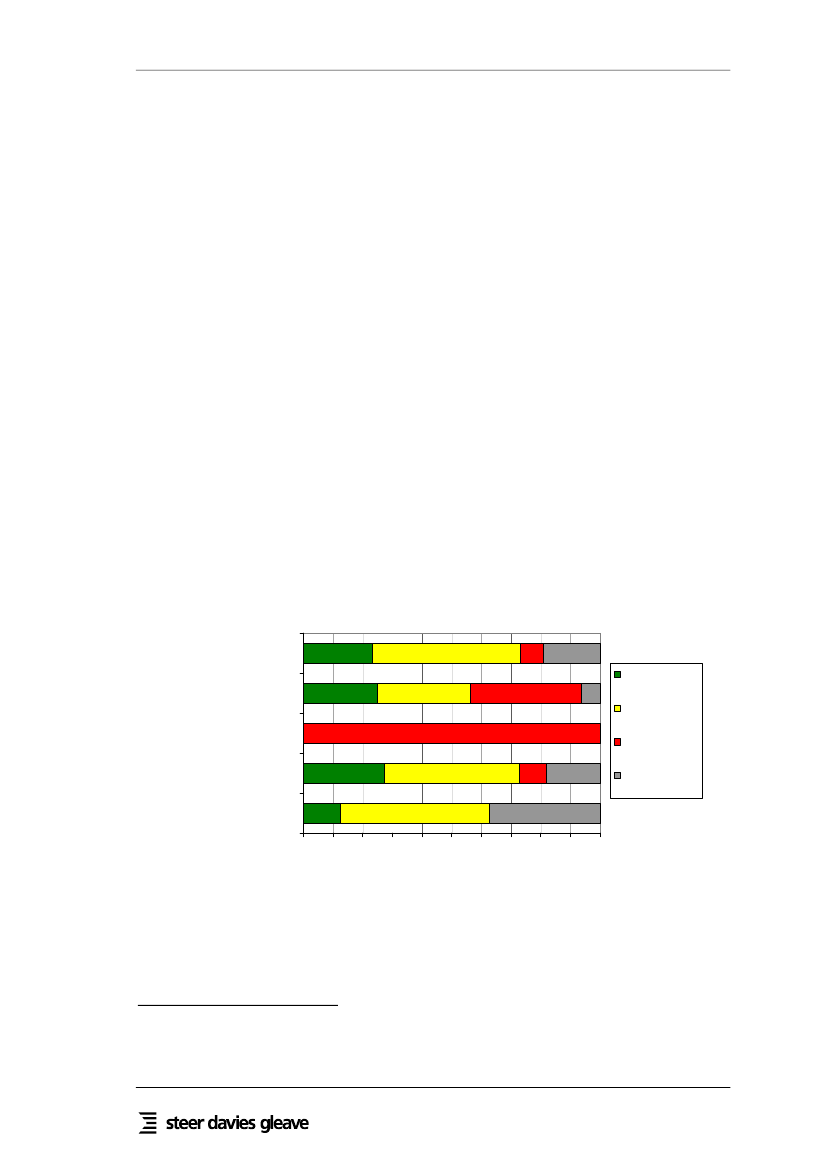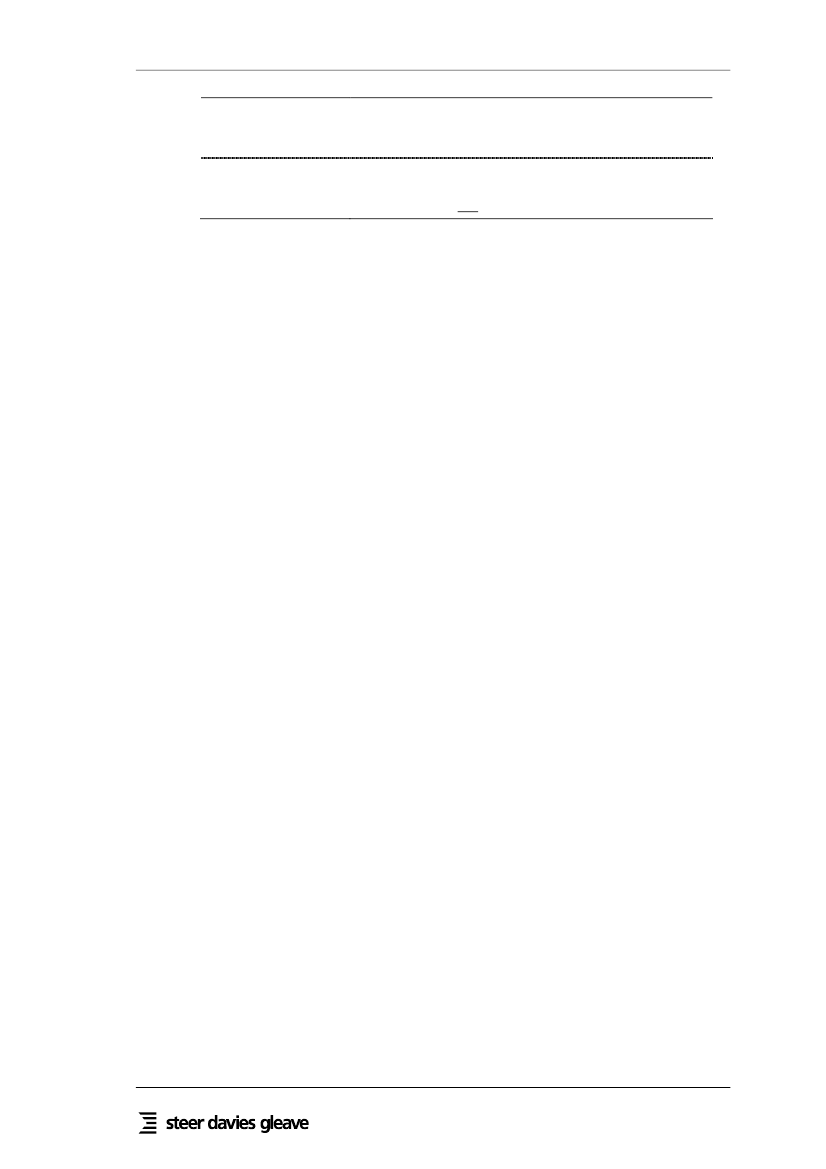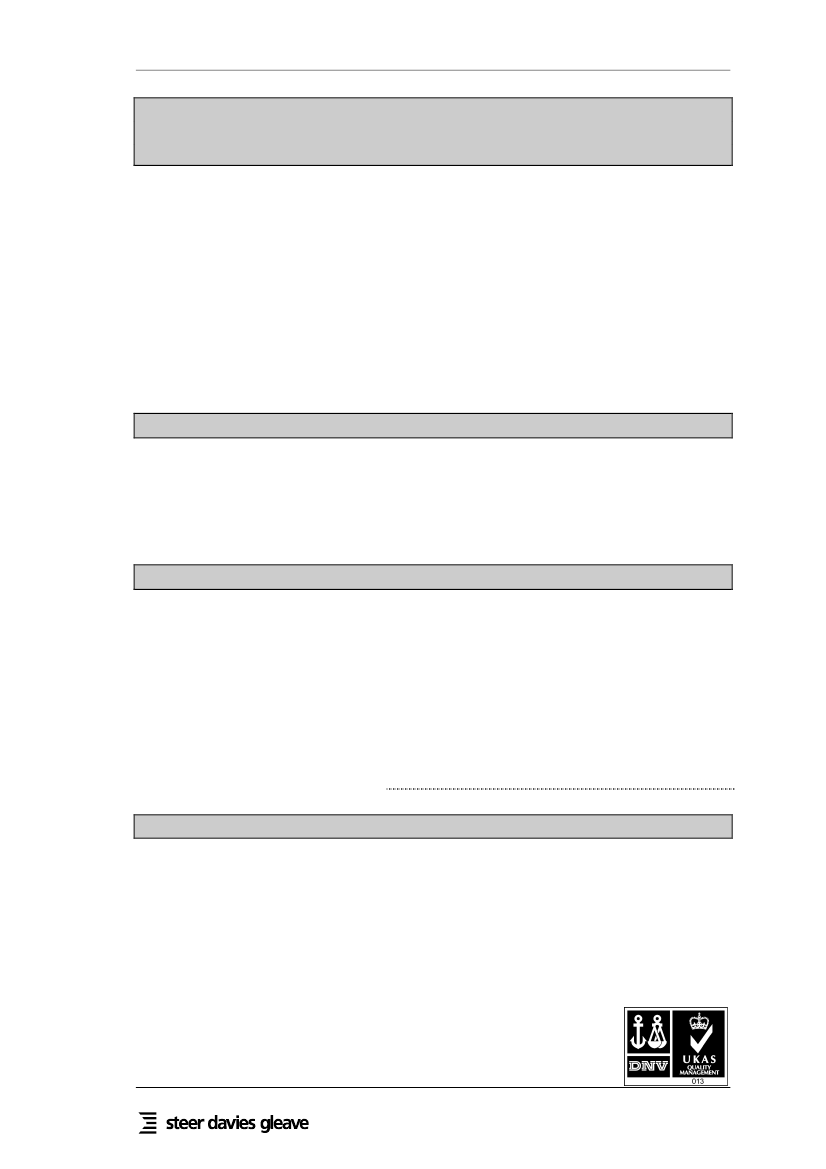Trafikudvalget 2009-10
TRU Alm.del
Offentligt
EVALUATION OF REGULATION261/2004Final reportMain reportFebruary 2010
Prepared for:
Prepared by:
European CommissionDirectorate-General Energy and TransportDM28 5/70BrusselsBelgium
Steer Davies Gleave28-32 Upper GroundLondonSE1 9PD+44 (0)20 7910 5000www.steerdaviesgleave.com
Final report
ContentsEXECUTIVE SUMMARYBackgroundFactual conclusionsRecommendations1.INTRODUCTIONBackgroundThe need for this studyThis reportStructure of this document2.RESEARCH METHODOLOGYIntroductionOverview of the approachSelection of case studiesDesk researchStakeholder inputs3.APPLICATION OF THE REGULATION BY AIRLINESIntroductionStatistical evidence for cancellations, delays and denied boardingComplaints to airlinesCost of complying with the RegulationEvidence for airline compliance with the RegulationStakeholder views on complianceConclusions4.ENFORCEMENT AND COMPLAINT HANDLING BY NEBSIntroductionOverview of the NEBsLegal basis for complaint handling and enforcementStatistics for complaint handling and enforcementThe complaint handling and enforcement processCo-operation between NEBs and with other organisationsOther activities undertaken by NEBsStakeholders views on complaint handling and enforcementConclusions
Page111377788101010101112171717252929343739393942465065676872
Contents
Final Report
5.
ALTERNATIVE PROCESSES FOR PASSENGERS TO CLAIMIntroductionAlternative dispute resolutionCivil court claimsCommercial claim servicesConclusions
777777788081838383849091919192949596989898102104
6.
STAKEHOLDER VIEWS ON POLICY ISSUESIntroductionWhether changes should be made to the RegulationThe content and drafting of the RegulationConclusions
7.
SUMMARY OF FACTUAL CONCLUSIONSIntroductionApplication of the Regulation by carriersComplaint handling and enforcement by NEBsAlternative means for passengers to obtain redressStakeholder views on the RegulationConclusions
8.
RECOMMENDATIONSOverviewMeasures to improve enforcementOther improvements which can be made without amending the RegulationChanges to the Regulation
FIGURESFigure 3.1Trends in delays and cancellations: AEA airlines (quarterly data;annual moving average)Trends in delays and cancellations: flights to / from UK airports(monthly data; annual moving average)Average minutes late vs traffic: flights to / from UK airports (monthlydata; annual moving average)Trends in delays and cancellations: ERA Airlines (monthly data;annual moving average, departures only)18
Figure 3.2
19
Figure 3.3
20
Figure 3.4
20
2
Final report
Figure 3.5
Causes of delay: AEA airlinesaverage)Causes of delay: ERA airlinesaverage)
(quarterly data; annual moving21(monthly data; annual moving2222
Figure 3.6
Figure 3.7Figure 3.8
Causes of Delay: Departures from French Airports (Annual Data)Delays and cancellations by airline, flights to / from UK airports, 2008(sorted by arrival / departure within 30 mins of schedule)Typical airline complaint handling process
2327323334344250707183
Figure 3.9
Figure 3.10 Compliance of Conditions of Carriage with Regulation 261/2004Figure 3.11 Punctuality survey results – Provision of compensationFigure 3.12 Punctuality survey results – satisfaction with handlingFigure 3.13 Stakeholder views of complianceFigure 4.1Figure 4.2Figure 4.3Figure 4.4Figure 6.1Number of complaints handled per year, per FTEComplaints received per sanction issued, 2008Stakeholders views on NEB-NEB/airline agreementsStakeholders views on Q&A documentStakeholders views: Whether the Regulation should be changed
TABLESTable 2.1Table 2.2Table 2.3Table 2.4Table 2.5Table 2.6Table 3.1Table 3.2Table 3.3Selection of case studiesStakeholder interviews: National Enforcement bodiesStakeholder interviews: AirlinesStakeholder interviews: Airline associationsStakeholder interviews: AirportsStakeholder interviews: Consumer associationsSummary of airline complaint proceduresAirline complaint response timescalesCompliance of airline ground handling manuals
Contents
Final Report
Table 4.1Table 4.2Table 4.3Table 4.4Table 4.5Table 4.6Table 4.7Table 4.8Table 4.9
Enforcement bodiesRelevant national legislationMaximum finesComplaints received in 2008 (except where stated)Outcome of complaints received in 2008, where availableSanctions imposed in 2008Languages in which complaints are handledTime taken to complete handle complaintsInvestigation of claims of extraordinary circumstances
Table 4.10 Responses issued to passengersTable 4.11 Policy on imposition of sanctionsTable 4.12 Issues with application of sanctions to carriers not based in the StateTable 4.13 Collection of sanctionsTable 4.14 Publication of informationTable 4.15 Inspections undertaken by NEBsTable 4.16 Conclusions: States’ compliance with Article 16Table 4.17 Conclusions: Nature and effectiveness of complaint handlingTable 5.1Table 8.1Small claims proceduresOther amendments for clarification and consistency
APPENDICESAACASE STUDIES (provided as separate document)
4
Final report
EXECUTIVE SUMMARYBackground
1.
Regulation 261/2004 introduced new rules on compensation and assistance for airpassengers in the event of denied boarding, cancellations, long delays and involuntarydowngrading. In 2006, the European Commission contracted Steer Davies Gleave toundertake an independent review of its operation and results. The study found thatthere had been a number of difficulties, arising in particular from ineffectiveenforcement in a number of Member States, and the fact that the wording of someparts of the Regulation left room for interpretation.In April 2007, the Commission issued a Communication to report on the Regulation,which concluded that a substantial improvement was required. It stated that therewould be a period of stability during which no legislative changes would be made, inorder to give Member States and air carriers the opportunity to improve theimplementation of the Regulation. In the meantime, it identified that further work wasrequired in a number of areas, including improved enforcement and clarification ofkey terms. The purpose of this study is to assess whether these measures have beensuccessful in ensuring that passengers’ rights are adequately protected, or whetherother measures now need to be taken.The research and interviews for this study were undertaken before the ruling of theEuropean Court of Justice in the caseSturgeon and Bock,relating to the distinctionbetween the treatment of cancellations and delays under the Regulation. Thisjudgement has significant implications for the issues evaluated in this study. It was notpossible to discuss this judgement with stakeholders within the timescale for thisstudy, but we have taken it into account in developing our recommendations.Factual conclusions
2.
3.
4.
This study has shown that the Commission and others have made significant efforts toaddress the problems with the operation of the Regulation identified at the time of our2006-7 study. Many National Enforcement Bodies (NEBs) also now undertakesignificantly more activity in relation to the Regulation than they did: all now handleindividual complaints1, and sanctions for non-compliance have been imposed in 14Member States.However, whilst these efforts have had some success, more has to be done to ensurethat passengers’ rights are properly protected. The following key problems remain:••the evidence available indicates that some carriers are still not consistentlycomplying with the requirements of the Regulation or are interpreting theRegulation in a way which minimises their obligations;as discussed in more detail below, in many Member States, enforcement is noteffective enough to provide carriers with an economic incentive to comply;
5.
1
Except Konsumentverket in Sweden, where complaints are handled by a non-NEB organisation.
1
Final Report
•••
in several Member States, there is no mechanism available by which individualpassengers can readily obtain redress from carriers;although rulings by the European Court of Justice (ECJ) have addressed some ofthe issues in the Regulation that were unclear, a number of issues have not beenaddressed andin some areas the rights granted by the Regulation can lead to differentunderstandings (for example relating to long delay and cancellation) or do notaddress all the problems that passengers may face (such as missed connectionsdue to delays).
6.
Ineffective enforcement continues to be a key problem and, in our view, most of theMember States reviewed for this study have not unambiguously complied with therequirement in Article 16 to introduce sanctions which are effective, proportionate anddissuasive. Although we have identified a number of improvements that have beenmade to the enforcement process, a number of significant issues remain, including:•••Two States have not unambiguously complied with the requirement in Article 16to introduce sanctions into national law.Even where sanctions have been introduced into national law, they are not alwaysapplied: in nearly half of the Member States, no sanction has ever been imposedon a carrier for non-compliance.In some States which have introduced sanctions into national law, thecircumstances in which sanctions can be imposed are extremely limited and meanthat sanctions cannot provide an economic incentive to comply with theRegulation in all cases.Some Member States have difficulties in either imposing sanctions on carriers notbased within the State, or cannot collect sanctions which are imposed. In someStates, this is because of an explicit limitation in national law, but more often thisis because of administrative requirements in national law which cannot be met ifthe carrier is not based within the State.In many Member States, the maximum sanctions which can be applied are toolow to provide carriers with an economic incentive to comply with theRegulation, taking into account that sanctions would only ever be imposed for asmall proportion of infringements. In some States the maximum level of sanctionis less than or equivalent to the costs that a carrier may avoid through non-compliance in some individual cases.In some States, there are other legal or administrative problems, which mean thatsanctions cannot be effective in providing an incentive to comply with theRegulation: for example, in Italy, whilst sanctions can be imposed the process tocollect them is slow.
•
•
•
7.
In addition, there are significant differences in the approach to enforcement indifferent Member States, which means that there is a risk that the single market for airtransport is being distorted.Several Member States are planning changes to national law and other improvementsto the enforcement process which should further improve the situation in the future.However, it is not clear that this will be sufficient to address the issues that we haveidentified.
8.
2
Final report
Recommendations
9.
We have made a number of recommendations, covering:•••improvements to the enforcement of the Regulation;other improvements to the operation of the Regulation which would not requireany legislative changes; andpossible changes to the requirements of the Regulation, if a decision is made torevise it.
Improvements to enforcement
10.
To date, virtually all enforcement activity has been in response to passengercomplaints to NEBs. In many Member States, significant resources are devoted tohandling complaints and in some cases mediating with carriers to achieve anacceptable resolution for the individual passenger. Whilst this is useful for thepassenger concerned, few passengers impacted by infringements complain to NEBs,and therefore in the vast majority of cases, infringement has no consequence for thecarrier other than that it avoids the costs associated with compliance.In our view the focus on complaints does not reflect the requirements of theRegulation, which gives passengers the right to complain to any NEB, but explicitlyplaces the onus on NEBs to take such measures that are necessary to ensure thatpassengers rights are respected. This could include effective handling of complaintsbut in itself this does not appear to be sufficient.In 2007, National Enforcement Bodies agreed an active approach to monitoringcompliance with the Regulation. However, little seemed to have been done in thissense. We suggest that the approach to enforcement should change, from a primarilyreactive approach focussed on responding to complaints, to a pro-active approachplacing the onus on carriers to demonstrate that they are complying, for example by:••••requiring carriers to provide evidence that they have complied with theRegulation;encourage Member States to verify, when monitoring carriers licensed in theirState, that they have set up user-friendly procedures for the prompt settlement ofdisputes under consumer protection Regulations;encourage Member States to require carriers to provide copies of the agreementswith airport managers or ground handlers which show the procedure to be appliedin the case of an incident;carrying out frequent unannounced inspections of carriers’ performance, in orderto track their responses to cases of delays, cancellations and denied boarding,including whether they issue the notices required by Article 14(2), as well as theircompliance with Article 14(1), the main scope of inspections at present;undertaking airport-based passenger surveys to monitor carriers’ performance;undertaking audits of carriers’ complaint handling processes to ensure that theresponses that carriers provide to passengers are accurate (for example, thatcompensation is paid when claimed by a passenger who has a right to it); andin addition to investigating whether carriers’ claims of extraordinarycircumstances are valid, require carriers to show that their decisions as to whether
11.
12.
•••
3
Final Report
compensation is payable for cancellations or long delays are consistent with theinterpretation set out by the ECJ in theWallentin-Hermanncase.13.Where inspections or investigation of complaints identify that carriers are notcomplying with the Regulation, fines need to be sufficient to provide the carrier withan economic incentive to comply with the Regulation in future and to deter othercarriers from not complying with it. If fines do not provide this incentive, it will be inthe commercial interest of carriers not to comply with the Regulation. Carriers that donot comply will have lower operating costs than carriers that do comply, and thereforethey will be able to offer lower fares, increase market share, and make greater profits.In many Member States, introducing fines that provide an incentive to comply withthe Regulation will require a change in national law, in order to:••increase the level of the maximum penalty that can be imposed so that it issufficient to provide an economic incentive in all cases; andremove restrictions on the imposition of sanctions which mean that they cannotfunction as an incentive, for example, difficulties in imposing sanctions onforeign carriers or in imposing sanctions where a carrier provides redress whenthe NEB intervenes.
14.
15.
We suggest that the Commission should ask every Member State to demonstrate thatthe level of fines defined in national law is sufficient to provide an economicincentive, in accordance with Article 16(3), taking into account the circumstancesunder which the State proposes to impose fines. This will vary between States inaccordance with variations in national law. For example, in certain States there aredifficulties in having civil penalties, which means enforcement must rely on criminalpenalties, which are inevitably harder to impose; in principle this is not a problem butthe level of the penalty when it is imposed must be correspondingly higher.A further option would be to amend Regulation 1008/2008, to make compliance withconsumer protection laws, including but not limited to this Regulation, a licensecondition. This would bring the EU into line with the US, where compliance witheconomic regulations, including those relating to passenger rights, is a licensecondition.Enforcement could be further improved through full implementation by all MemberStates of the NEB-NEB agreement, and by improving the data on delays andcancellations of individual flights available to NEBs, and ideally the public throughproduction of a Consumer Report similar to that produced by the US Department ofTransportation. We suggest that the European Commission should work with MemberStates, NEBs and Eurocontrol to achieve this.Other improvements to the operation of the Regulation
16.
17.
18.
Some other minor initiatives could be taken which would improve the operation of theRegulation. We suggest that the Commission should:•encourage Member States to procure a harmonised online common complaintsinterface to handle and direct complaints automatically, in place of the standardcomplaint form, and provide information on how to complain to carriers;
4
Final report
••
update the Question and Answer document to reflect recent case law; andcontinue with regular interaction and encouragement with NEBs, airlineassociations, and also the key airlines.
Changes to the Regulation
19.
The Commission may be able to further clarify the Regulation through issuing furtherguidance, supplementing or possibly replacing the Q&A document, and the ECJ islikely to consider further cases which may lead to further clarification of the rights andobligations that the Regulation creates. In addition, the Commission and MemberStates may be able to further improve the operation of the Regulation. Nonetheless, inthe interviews we undertook for this study, most stakeholders told us that theRegulation should be revised. These interviews were all conducted before the ruling ofthe Court of Justice in the caseSturgeon and Bock.As identified by the Court, theRegulation appears to provide different rights to passengers facing equivalentinconvenience due to delays and cancellations. The Court ruled, on the basis of theprinciple of equal treatment, that there is a right to compensation for delays longerthan three hours, except where the delays are caused by circumstances which aresufficient to offer an exemption from payment of compensation under Article 5(3)(“extraordinary circumstances which could not have been avoided even if allreasonable measures had been taken”).Whilst the ruling addresses one of the most important open questions in theRegulation, there are several others to which the same principle of equal treatmentcould be applied to justify revising the text. In our opinion, these issues can only beaddressed properly by revising the text of the Regulation so that the rights andobligations it creates are explicit and consistent with the principle of equal treatment.We also recommend that the Regulation should be revised to address the other areas ofthe text which are unclear.The most significant changes that we propose are:•Further to the Sturgeon judgement, passengers facing delays and cancellationsshould receive similar treatment. In particular, passengers should have equivalentright to benefits such as compensation, assistance and rerouting after the sameperiods, and should have equivalent rights if the delay or cancellation causesthem to miss connecting flights.Advance schedule changes, which are in effect delays notified in advance, shouldbe explicitly treated in the same way as cancellations notified in advance.The Commission should reflect on whether the circumstances under whichairlines should be required to pay compensation for cancellations and delaysshould be limited to cases not due to force majeure.The Article relating to downgrading should be revised to be consistent with theArticle on denied boarding, as both generally arise from overbooking.
20.
21.
•••22.
We also suggest a number of more minor changes, including that the total derogationfor helicopter services should be replaced with an option for Member States to givetotal or partial derogations to certain limited types of service (including helicopters butalso, for example, services with fixed wing aircraft taking off and landing on grass
5
Final Report
runways or the sea), and various other adjustments to address elements of theRegulation which are unclear.
6
Final report
1.
INTRODUCTIONBackground
1.1
Regulation 261/2004 introduced new rules on compensation and assistance for airpassengers in the event of denied boarding, cancellations, long delays and involuntarydowngrading. Depending on the circumstances, the Regulation requires air carriers to:••••provide passengers with assistance, such as hotel accommodation, refreshmentsand telephone calls;offer re-routing and refunds;pay compensation of up to €600 per passenger; andproactively inform passengers about their rights under the Regulation.
1.2
The Regulation also required Member States to set up National Enforcement Bodies(NEBs) with the ability to impose dissuasive sanctions, and specifies that passengershave the right to complain to any NEB.In 2006, the European Commission contracted Steer Davies Gleave to undertake anindependent review of the operation and results of the Regulation. The study, whichreported in 2007, found that there had been a number of difficulties, arising inparticular from ineffective enforcement in a number of Member States, and the factthat the drafting of some parts of the Regulation was unclear.In April 2007, the Commission issued a Communication2to report on the operationand results of the Regulation, as required by Article 17. This concluded that asubstantial improvement in the operation of the Regulation was required. It stated thatthere would be a period of stability during which no legislative changes would bemade, in order give Member States and air carriers the opportunity to improve theimplementation of the Regulation. In the meantime, it identified that further work wasrequired in a number of areas, including improved enforcement and clarification ofkey terms.The need for this study
1.3
1.4
1.5
The Communication issued in 2007 stated that if the efforts the Commission wasplanning to make to improve the operation of the Regulation did not produce asatisfactory result, it would have to consider amending the Regulation to ensure thatpassengers rights were fully respected.Since 2007, there have been a number of developments which should have helped toimprove the operation of the Regulation. These include:••measures taken by the Commission, for example to facilitate voluntaryagreements between NEBs and also between NEBs and airlines;rulings issued by the European Court of Justice, clarifying the interpretation of
1.6
2
COM final 168 (2007)
7
Final Report
•1.7
key Articles of the Regulation; andother legal developments, such as the entry into force of the Regulation onconsumer protection cooperation (Regulation 2006/2004).
The Commission intends to release a further Communication on the operation of theRegulation, and the extent to which this has been improved by the measures taken. Inorder to inform this Communication, it is necessary to undertake a new evaluation ofthe effectiveness of the enforcement of the Regulation and of the extent of compliancewith it. This will identify whether the measures taken since 2007 have succeeded inimproving the operation of the Regulation so that it now provides a high level ofprotection for passengers.This study has been undertaken by Steer Davies Gleave. We have been supported onresearch in Poland, Slovak Republic and Hungary by Helios Technology Limited. Theconclusions represent the views of Steer Davies Gleave alone.This report
1.8
1.9
This report is the Final Report for the study. It reflects comments received from theCommission on the First Findings Report, which set out the factual conclusions fromthe study.On the date that First Findings Report for this study was issued, the European Court ofJustice issued its ruling in the caseSturgeon and Bock3, relating to the distinctionbetween the treatment of cancellations and delays under the Regulation. Thisjudgement has significant implications for the issues evaluated in this study. It was notpossible to discuss this judgement with stakeholders within the timescale for thisstudy, but we have taken it into account in developing our recommendations.A limited amount of information has been redacted from the published version of thisreport.Structure of this document
1.10
1.11
1.12
The rest of this report is structured as follows:•••••••Section 2 summarises the methodology used for this study;Section 3 sets out how the Regulation is being applied by carriers;Section 4 describes enforcement and complaint handling by NEBs;Section 5 discusses alternative dispute resolution processes;Section 6 sets out stakeholder views on possible policy measures;Section 7 summarises the conclusions; andSection 8 sets out our recommendations.
1.13
Case studies have been undertaken of complaint handling, enforcement and alternativedispute resolution processes in 15 Member States. These are provided in appendix A,
3
Joined Cases C 402/07 and C 432/07
8
Final report
which, due to its size, is provided as a separate document.
9
Final Report
2.
RESEARCH METHODOLOGYIntroduction
2.1
This section provides a summary of the research methodology used. It describes:••••the overall approach used;the selection of case studies;the scope of the desk research that has been undertaken; andthe stakeholders that have participated in the study, and how they have providedinputs.
Overview of the approach
2.2
The Commission requested us to collect evidence to address a number of questions,most of which can be categorised as either relating to:••enforcement and complaint handling undertaken by National Enforcement Bodies(NEBs); andapplication of the Regulation by air carriers.
2.3
In order to address these questions, we developed a research methodology divided intotwo parts:••case study research; andcross-EU interviews and analysis.
2.4
The rationale for this division is that enforcement and complaint procedures arespecific to Member States and are therefore best evaluated through a case studyapproach. It was agreed to undertake case studies of complaint handling andenforcement in 15 Member States as part of this study. However, key airlines coverthe whole of the EU (for example, the Irish-registered carrier Ryanair operatesdomestic flights in the UK, France, Spain and Italy) and therefore questions relating tothe application of the Regulation by airline have been addressed through a cross-EUapproach. Information from both elements of the research has been used for theconclusions, and will be used as the basis for the development of recommendations.Both the case study and the cross-EU research use a mixture of stakeholder interviewsand desk research. However, as there is limited published information available whichaddresses the issues that were raised by the Commission, we have been primarilyreliant on stakeholder interviews.Selection of case studies
2.5
2.6
As noted above, it was agreed to undertake detailed case studies of complaint handlingand enforcement in 15 Member States as part of this study. This section summariseshow the case studies were selected. We have also collected some, more limited, dataon complaint handling and enforcement in the other 12 Member States in order to beable to present the position on complaint handling and enforcement across the EU.
10
Final report
2.7
We undertook case studies in the eight Member States with the largest aviationmarkets, measured in terms of air passenger numbers (UK, Spain, Germany, Italy,France, Greece, Netherlands and Ireland). The other seven case studies were selectedin order to ensure that the study covered:•••••Member States where the Commission was aware of particular difficulties withenforcement, or where particular difficulties were identified in the study weundertook for the Commission in 2006-7;at least one State in which enforcement was previously identified as ‘bestpractice’;Member States in which the nature of the NEB is unusual, for example, to includeStates where complaint handling and/or enforcement is undertaken by a consumerprotection authority rather than a civil aviation authority;a selection of new Member States; andStates covering a wide geographical scope and variation in sizes.
2.8
The selection of States is summarised below.TABLE 2.1StateDenmarkFranceGermanyGreeceHungaryIrelandItalyLatviaNetherlandsPolandPortugalSlovak RepublicSpainSwedenUKSELECTION OF CASE STUDIESRationale for selectionWide geographical spread; identified as example of best practiceLargest 8 States measured by passenger numbersLargest 8 States measured by passenger numbersLargest 8 States measured by passenger numbersNew Member State with large air transport market, and unusual structure for NEB(consumer authority)Largest 8 States measured by passenger numbersLargest 8 States measured by passenger numbersIssues previously identified with enforcement (low maximum fines)Largest 8 States measured by passenger numbersNew Member State with large air transport marketWide geographical spread; issues identified with enforcementNew Member State with large air transport market; particular issues due to airlineinsolvencyLargest 8 States measured by passenger numbersWide geographical spread; unusual structure for NEB (consumer authority/ADR)Largest 8 States measured by passenger numbers
Desk research
2.9
The following information has been collected and analysed through desk research:••information from airline websites on airline complaint procedures;data for delays and cancellations, from national authorities and from airlineassociations; and
11
Final Report
•2.10
data for NEB complaint procedures, from NEB websites.
We have also obtained and analysed a significant amount of supporting informationprovided by stakeholders:••NEBs have provided data on passenger complaints, sanctions imposed and thelegal basis for enforcement; andairlines have provided information on their policies and procedures relating to theRegulation, the number of complaints received, and on the cost of compliancewith the Regulation.
Stakeholder inputs
2.11
Relatively little information is publicly available relating to the issues that we havebeen asked to address, and therefore we have relied extensively on information andopinions provided by stakeholders. This section summarises the stakeholders whichhave contributed to the study, and how they have contributed. This is divided asfollows:•••••National Enforcement Bodies;airlines and airline representative associations;airport operators and their representative association;passenger/consumer representatives; andother relevant stakeholders, such as tour operators.
2.12
We would like to thank all of the stakeholders that contributed to the study.National Enforcement Bodies
2.13
We contacted the NEBs in all 27 Member States to obtain information on thecomplaint handling and enforcement processes in each Member State, and tounderstand their views on how airlines were complying with the Regulation andpossible changes to it. In the 15 Member States selected as case studies, we undertookdetailed face-to-face interviews with the NEBs, and reviewed the legislation,procedures and other relevant documents that applied. Several of these NEBs alsoprovided us with written submissions which we have used. In the other 12 MemberStates, we provided the NEB with a questionnaire which was followed up with atelephone interview where necessary. The NEBs are listed in Table 2.2.TABLE 2.2Member StateAustriaBelgiumBulgariaCyprusCzech RepublicSTAKEHOLDER INTERVIEWS: NATIONAL ENFORCEMENT BODIESOrganisationBundesministerium für Verkehr, Innovation undTechnologieSPF Mobilité et TransportsGeneral Directorate Civil AviationAdministration, Ministry of TransportDepartment of Civil AviationCivil Aviation AuthorityForm of input to studyWritten responseWritten responseWritten response and telephone interviewWritten response and telephone interviewWritten response and telephone interview
12
Final report
DenmarkEstonia
Statens Luftfartsvæsen (CAA Denmark)Tarbijakaitseamet (Consumer ProtectionBoard)Civil Aviation Authority
Face-to-face interviewWritten response and telephone interviewWritten response and telephone interviewPartial written responseWritten responseWritten response and face-to-face interviewFace-to-face interviewFace-to-face interviewWritten response and face-to-face interviewInput to HACP written responseWritten response and face-to-face interviewWritten response and face-to-face interviewFace-to-face interviewWritten response and telephone interviewWritten response and telephone interviewWritten response and telephone interviewWritten response and face-to-face interviewWritten response and face-to-face interviewWritten response and face-to-face interviewWritten response and telephone interviewFace-to-face interviewWritten response and telephone interviewWritten response and face-to-face interviewWritten submission and face-to-faceinterview (with both organisations)Written response and face-to-face interviewWritten response and face-to-face interview
Finland
Consumer Complaint BoardConsumer Ombudsman & Agency
FranceGermanyGreeceHungaryIrelandItalyLatviaLithuaniaLuxembourgMaltaNetherlandsPolandPortugalRomaniaSlovakiaSloveniaSpainSweden
Direction Générale de l'Aviation CivileLuftfahrt-Bundesamt (LBA)Hellenic Civil Aviation AuthorityHungarian Authority for Consumer ProtectionHungarian Civil Aviation AuthorityCommission for Aviation RegulationENACConsumer Rights Protection CentreCivil Aviation AdministrationDirection de la Consommation du Ministère del’Economie et du Commerce extérieurDepartment of Civil AviationCivil Aviation Authority Netherlands - FlightOperations InspectorateCivil Aviation OfficeINAC, Legal Regulations DepartmentNational Authority for Consumer ProtectionSlovenská obchodná inšpekcia (Slovak TradeInspectorate)ústredný inšpektorát (Central Inspectorate)Directorate of Civil AviationAgencia Estatal de Seguridad AéreaEnforcement: Swedish Consumer AgencyComplaints: National Board for ConsumerComplaintsEnforcement: UK CAAComplaints: UK Air Transport Users Council
UK
Airlines and airline associations
2.14
We consulted with airlines in order to obtain information on their application of theRegulation, and on the complaint handling and enforcement processes undertaken byNEBs. We sought to include in the study:•••One key airline with major operations in each case study State;At a minimum, the top 5 European airlines by passenger numbers (Air France-KLM, Lufthansa, British Airways, easyJet and Ryanair); andA mix of different airline types (legacy, low cost and charter), States of
13
Final Report
registration, and sizes.2.15Table 2.3 lists the airlines we approached; it also lists the type of carrier and where inthe case study States each carrier has a base. Some of the carriers we approacheddecided not to respond directly to us, but we did undertake interviews with twocarriers who approached us directly requesting to participate. Several legacy carriersresponded through their representative organisation, AEA, but were not able toprovide individual responses to us.TABLE 2.3AirlineAegean AirlinesAir France-KLMAir BalticAir BerlinAlitaliaBMIBritish AirwaysBrussels AirwayseasyJetIsle of ScillySkybusLufthansaNorwegianOlympic AirlinesRyanairSASTAP Air PortugalTUI groupWizz AirSTAKEHOLDER INTERVIEWS: AIRLINESType of carrierRegional carrierLarge legacy carrierRegional carrierLarge low cost carrierMedium sized legacy carrierMedium sized legacy carrierLarge legacy carrierSmaller legacy carrierLarge low cost carrierSmall regional carrierLarge legacy carrierSmaller low cost carrierLegacy carrierLarge low cost carrierMedium sized legacy carrierMedium sized legacy carrierVarious charter carriersSmaller low cost carrierBases in case study StatesGreeceFrance, NetherlandsLatviaGermanyItalyUKUK-France, Germany, Spain, Italy,UKUKGermany-GreeceGermany, Ireland, Italy,Portugal, Spain, Sweden, UKDenmark, SwedenPortugalUK, Germany, FranceHungaryType of participationFace-to-face interviewTelephone interview andinput through AEAFace-to-face interviewWritten responseInput through AEA onlyWritten responseInput through AEA onlyWritten responseFace-to-face interviewFace-to-face interviewInput through AEA onlyFace-to-face interviewDid not respondFace-to-face interviewFace-to-face interviewFace-to-face interviewFace-to-face interviewFace-to-face interview
2.16
We also consulted with the five main associations representing airlines operatingwithin the EU, listed in Table 2.4 below.TABLE 2.4OrganisationIATAELFAAIACAAEASTAKEHOLDER INTERVIEWS: AIRLINE ASSOCIATIONSFull nameInternational Air Transport Association*European Low Fares Airline AssociationInternational Air Carrier AssociationAssociation of European Airlines*RepresentsAll ‘legacy’ airlinesEuropean low cost airlinesLeisure (charter) airlinesEuropean legacy airlines
14
Final report
ERA
European Regional Airlines Association
European regional airlines
* A joint meeting was held with IATA and AEA
Airport operators and associations
2.17
We also approached one airport in each of the case study States, usually the mainairport. The rationale for approaching the airport operator was that at certain airports,airport employees, particularly terminal managers, are in a good position to make anindependent assessment of whether and how airlines operating to the airport arecomplying with the Regulation.However, many of the airports we approached were not willing to respond orconsidered that they did not have any contribution to make; the airports that didcontribute are listed in Table 2.5.TABLE 2.5StateDenmarkFranceGermanyGreeceHungaryIrelandItalyLatviaNetherlandsPolandPortugalSlovakiaSpainSwedenUKSTAKEHOLDER INTERVIEWS: AIRPORTSAirportKøbenhavns LufthavneAéroports de ParisBerlin AirportsAthens International AirportBudapest Ferihegy InternationalDublin Airport AuthorityAeroporti di RomaRiga International AirportSchiphol GroupPolish Airports State EnterpriseANA Aeroportos de PortugalAirport BratislavaAENALFV (Stockholm)BAA (London Heathrow)Type of participationWritten responseNot able to obtain a responseNot willing to provide responseWritten responseNot able to obtain a responseWritten responseNot able to obtain a responseNot able to obtain a responseNot able to obtain a responseWritten responseWritten responseFace-to-face interviewWritten responseNot able to obtain a responseFace-to-face interview
2.18
Passenger and consumer representatives
2.19
We also sought to involve one passenger or consumer association in each of the casestudy States plus Belgium, and we also had a written response from the EuropeanPassenger Federation (EPF). Not all of the consumer organisations that we contactedwere able to respond.TABLE 2.6StateEUDenmarkSTAKEHOLDER INTERVIEWS: CONSUMER ASSOCIATIONSAssociation nameEuropean Passenger FederationForbrugerrådet – FR (Danish Consumer Council)Type of participationWritten responseWritten response
15
Final Report
FranceGermany
UFC - Que ChoisirVZBV - Verbraucherzentrale BundesverbandSchlichtungsstelle Mobilitat
Telephone interviewWritten response and telephoneinterviewWritten response and telephoneinterviewTelephone interviewWritten responseDid not respondTelephone interviewWritten responseWritten responseDid not respondWritten responseFace-to-face interviewWritten responseFace-to-face interviewFace-to-face interviewFace-to-face interview
GreeceHungaryIrelandItalyLatviaNetherlandsPolandPortugalSlovakiaSpainSwedenUKBelgium
Centre for the Protection of ConsumersOFE (consumer protection association)Consumers Association of IrelandAssoutenti4ECC LatviaAssociation of TravellersPolish National Consumer AssociationAssocia§ão Portuguesa para a Defesa doConsumidorAssociation of Slovak ConsumersFACUASwedish Consumers AssociationWhich?Test Achats
Other organisations
2.20
The following other organisations have provided input to the study:•••EUClaim, a commercial organisation which handles passenger claims againstairlines under the Regulation;ECTAA, the European Travel Agents and Tour Operators Association; andTUI Group Plc, one of the two largest holiday operators in the EU, which repliedboth on its own behalf and on behalf of the airlines it owns.
4
In addition the report draws on published statements by other consumer organisations, but they have not directlyparticipated in the study.
16
Final report
3.
APPLICATION OF THE REGULATION BY AIRLINESIntroduction
3.1
This chapter examines the evidence we have collected on how airlines have appliedthe Regulation. It discusses:•••••the frequency with which incidents covered by the Regulation occur;procedures put into place for handling complaints;the cost of complying with the Regulation;evidence regarding the extent to which airlines are complying with theRegulation, provided by airlines and other organisations; andstakeholder views on how and whether airlines are complying.
Statistical evidence for cancellations, delays and denied boarding
3.2
In principle, the introduction of the Regulation might have been expected to reduce thelevel of airline-caused delay and cancellations, by providing carriers with additionalincentive to ensure reliable operations. In addition, there was a risk that it might haveincentivised airlines to reclassify cancellations as long delays, because carriers’obligations in the event of long delays are less onerous. Our 2006-7 study for theCommission found no evidence of any such impact, but noted that it was relativelyearly to make this assessment. Therefore, we have updated the analysis of the leveland causes of delays and cancellations.Our analysis draws on data published by the UK Civil Aviation Authority (CAA), theFrench Civil Aviation Authority (DGAC), the Association of European Airlines(AEA) and the European Regional Airlines Association (ERA). We have alsoreviewed a number of other data sources including Eurocontrol eCODA data, but thiswas not useful for the analysis that we needed to undertake. The scope of the analysisthat can be undertaken is, in any case, restricted by the fact that, in many parts ofEurope, there is no published source of data on flight delays and cancellations.Level of delays and cancellations
3.3
3.4
The sources evaluated for this study indicate that the Regulation has had no impact onthe frequency and severity of delays, or on the number of cancellations. In addition,there is no evidence for carriers’ reclassifying cancellations as long delays. However,it is possible that carriers may use a different approach to categorisation for statisticalpurposes to that used when determining their obligations under the Regulation, andtherefore it is not possible to derive a definitive conclusion from this analysis.Figure 3.1 shows trends in delays and cancellations from data provided by AEA. Thisis based on data from AEA members, which are network airlines operating a mix oflong-haul and short distance services. The data suggests that the Regulation has nothad a significant impact on the percentage of flights delayed or cancelled, or theaverage delay minutes recorded for arrivals or departures. Unfortunately the AEA datadoes not provide any information on the number of long delays, so it cannot be used toestimate in how many cases carriers have an obligation to provide assistance to
3.5
17
Final Report
passengers. The data shows around 1.4% of AEA airline flights are cancelled.FIGURE 3.1TRENDS IN DELAYS AND CANCELLATIONS: AEA AIRLINES(QUARTERLY DATA; ANNUAL MOVING AVERAGE)45Regulation 261/200435%44
40%
30%
43Average delay minutes
25%% of Flights
42
20%
41
15%
40
10%% Departures over 15 mins% Departures cancelled% Arrivals over 15 minsAverage delay mins (departures)Average delay mins (arrivals)2000 Q12001 Q12002 Q12003 Q12004 Q12005 Q12006 Q12007 Q12008 Q1
39
5%
38
0%
37
Source: SDG analysis of AEA data
3.6
The data suggests that, in the year following the implementation of the Regulation,delays increased, peaking in the third quarter of 2006. There has been no significantchange in the proportion of flights cancelled and there is no evidence to suggest thatairlines have re-classified cancellations as long delays.Figure 3.2 (below) shows UK CAA data for delays and cancellations at 10 major UKairports. This shows similar trends to the AEA data but has the advantage ofseparately identifying long delays, and also being more up-to-date. The data shows asignificant decline in long delays since mid 2008, when traffic volumes started to fall.This result is consistent with the opinion of stakeholders that the decline in air trafficcaused by the economic situation has reduced the incidence of long delays andcancellations. In particular, there is no evidence of a re-classification of cancellationsas long delays since the introduction of the Regulation.
3.7
18
Final report
FIGURE 3.2
TRENDS IN DELAYS AND CANCELLATIONS: FLIGHTS TO / FROM UKAIRPORTS (MONTHLY DATA; ANNUAL MOVING AVERAGE)21
7%1-3 hour delays3-6 hour delaysOver 6 hour delaysPossible cancellationsAverage minutes late
Regulation 261/2004
6%
18
5%
15Average minutes late
% of Flights
4%
12
3%
9
2%
6
1%
3
0%Jan 2000Jan 2001Jan 2002Jan 2003Jan 2004Jan 2005Jan 2006Jan 2007Jan 2008Jan 2009
0
Source: SDG analysis of UK CAA data
3.8
CAA separately identifies delays of different lengths, although unfortunately it doesnot identify delays over 2 hours, which would be valuable in assessing for whatproportion of flights obligations are created by the Regulation; it indicates 4.3% offlights are delayed by 1-3 hours and around 0.7% are delayed over 3 hours. The dataincludes a ‘planned flights unmatched’ category, which represents planned flights forwhich an air transport movement has not been found. This unmatched category is usedhere as a proxy for possible cancellations, but the actual level of cancellations is likelyto be lower, as flights can fail to be matched for a number of reasons other than thecancellation of the flight.5For consistency with the AEA data, delayed flights aremeasured as a proportion of actual rather than scheduled flights.Figure 3.3 compares flight delays to the number of flights operated at the airports inthe sample, and clearly shows the link between recent declines in traffic volume andlower delays.
3.9
5
The possible reasons given by CAA for a flight not matching are: diversion to another airport, cancellation, theflight was a short-haul flight which operated more than an hour earlier than scheduled, the actual flight tookplace in the following month, or an incorrectly reported item of data caused the flight not to match.
19
Final Report
FIGURE 3.3
AVERAGE MINUTES LATE VS TRAFFIC: FLIGHTS TO / FROM UKAIRPORTS (MONTHLY DATA; ANNUAL MOVING AVERAGE)20
145,000
140,000
19
Flights matched per month
135,000
18Average minutes late
130,000
17
125,000
16
120,000
15
115,000Flights matchedAverage minutes late110,000Jan 2000
14
13Jan 2001Jan 2002Jan 2003Jan 2004Jan 2005Jan 2006Jan 2007Jan 2008Jan 2009
Source: SDG analysis of UK CAA data
3.10
Figure 3.4 shows data provided by the European Regions Airline Association (ERA)for its members, which are generally smaller short-haul operators. The ERA datashows that, for these carriers, there has actually been some increase in the proportionof long delays since the Regulation took effect. The data shows that approximately2.0% of ERA airline flights are cancelled and around 3.4% delayed over 1 hour.FIGURE 3.4TRENDS IN DELAYS AND CANCELLATIONS: ERA AIRLINES (MONTHLYDATA; ANNUAL MOVING AVERAGE, DEPARTURES ONLY)
4.0%% over 60 mins late% cancelledRegulation 261/2004
3.5%
3.0%
% of Departures
2.5%
2.0%
1.5%
1.0%
0.5%
0.0%Jan 2002Jan 2003Jan 2004Jan 2005Jan 2006Jan 2007Jan 2008Jan 2009
Source: SDG analysis of ERA data
20
Final report
Causes of delays and cancellations
3.11
We have also analysed data for the causes of delays and cancellations, in order to:••identify whether the overall trends in delays and cancellations are impactedby factors which airlines cannot directly control, such as air trafficmanagement constraints; andassess the proportion of cases in which airlines could be exempt frompaying compensation for cancellations under Article 5(3) of the Regulation.
3.12
DGAC, AEA and ERA provide data on the causes of delays, although none provideany data on the causes of cancellations. It would be reasonable to assume that flightswould be cancelled for similar reasons although this would not always be the case.Overall, the data indicates that airlines are responsible for around 40% of delays, andthere has been no consistent change in this since the introduction of the Regulation.Figure 3.5 shows causes of delay for AEA departures delayed by more than 15minutes. Again, this data has been smoothed to eliminate seasonality, specifically ahigher rate of weather-related causes in the first and fourth quarters of every year. Thedata shows that airlines may be considered responsible for an average of 43% ofprimary delays (and presumably the same proportion of reactionary delays), and therehas been not been a significant change in this since the Regulation took effect.FIGURE 3.5CAUSES OF DELAY: AEA AIRLINES(QUARTERLY DATA; ANNUAL MOVING AVERAGE)Maintenance / Equipment FailureWeatherReactionary (late arrival)
3.13
Load & Aircraft Handling; Flight OpsAirport & Air Traffic Control100%
80%
% delays by cause
60%
40%
20%
Regulation 261/20040%2002 Q12003 Q12004 Q12005 Q12006 Q12007 Q12008 Q1
Source: SDG analysis of AEA data
3.14
However, ERA data (for delays of 60 minutes or more), shown in Figure 3.6, doessuggest a slight decrease in airline-related delays following the implementation of theRegulation. The ERA data indicates that, at the implementation of the Regulation inFebruary 2005, airlines were responsible for around 46% of primary delays (thisexcludes the reactionary and ‘other’ categories). The moving average reduces toaround 40% by late 2006, and increases again from August 2007 onwards.
21
Final Report
FIGURE 3.6
CAUSES OF DELAY: ERA AIRLINES(MONTHLY DATA; ANNUAL MOVING AVERAGE)OpsAircraft / TechnicalReactionaryOtherATCWeatherPax
100%Regulation 261/200490%80%70%60%50%40%30%20%10%0%Jan 2003Jan 2004Jan 2005Jan 2006Jan 2007WeatherPassengers20062007
Source: SDG analysis of ERA data
3.15
DGAC, the French civil aviation authority, publishes data on the causes of delay fordepartures from 15 French airports. The data is published on an annual basis, and isshown in Figure 3.7. The data indicates that airlines are responsible for 36-44% ofprimary delays, with a slight increase in this proportion since the introduction of theRegulation. The main change visible is that there has been a gradual reduction in theproportion of delay attributed to air traffic management in France since 2000.FIGURE 3.7CAUSES OF DELAY: DEPARTURES FROM FRENCH AIRPORTS(ANNUAL DATA)Airlines100%Regulation 261/200490%80%70%60%50%40%30%20%10%0%2000200120022003200420052008Reactionary & MiscellaneousAirports & safety servicesATFM
Source: SDG analysis of DGAC data
22
Final report
Delays and cancellations by airline
3.16
We have also undertaken analysis of the proportion of flights delayed by airline, inorder to identify whether there are significant differences between different types ofcarrier (low cost, charter etc) which may lead to some having greater obligations thanothers under the Regulation. The analysis is limited to the airlines selected forinclusion in the study sample.Although many of the sources reviewed for the study present airline-specific data,CAA data has been the most useful, being available for all of 2008, and coveringalmost all of the case study airlines. A limitation is that it is only based on flights toand from UK airports, which for some airlines may only form a small proportion oftheir overall operations; however this also means that the flights in the sample are allwithin a relatively similar operating environment.Figure 3.8 shows CAA data for arrivals and departures at UK airports. As statedpreviously, ‘planned flights unmatched’ is used as a proxy for cancellations, but actualcancellations are likely to be somewhat lower.FIGURE 3.8DELAYS AND CANCELLATIONS BY AIRLINE, FLIGHTS TO / FROM UKAIRPORTS, 2008(SORTED BY ARRIVAL / DEPARTURE WITHIN 30 MINS OF SCHEDULE)
3.17
3.18
100%95%90%85%% of Flights80%75%70%65%60%0-15 mins55%50%aysinesrsAitCrBhoalticiceAirwaysFiairaltItAirAirwaysinesceliaKLMhwesSASansyJeBMyanrantugitaWizzAirwAirlIbOlymeriapicaEasAirl
16-30 mins
31-60 mins
1-3 hours
3-6 hours
Over 6 hours
Possible cancellations
Al
Lufth
els
out
Ai
ish
Por
rF
R
uss
Brit
Ai
Br
Source: SDG analysis of UK CAA data
3.19
The analysis shows significant variation in the proportion of different carriers’ flightswhich are delayed. However, there is no consistent evidence of a trend for one type ofoperator to be more punctual than another. The two charter airlines in the sample hadlevels of punctuality that, overall, were not significantly worse than other carriers, butthey did have a higher proportion of very long delays (over 3 hours), and almost noflights which may have been cancelled. This is consistent with information providedby the carriers, which is that they do not generally cancel flights.
Th
om
son
rS
Air
23
Final Report
Analysis of information provided by airlines
3.20
In addition to the publicly available data discussed above, from each airline wecontacted we requested airline-specific data on punctuality and reliability. All airlinescontacted either were not able to extract such data, or regarded it as too sensitive torelease. As a result we were unable to compare public data against airline sources.Two airlines were willing to provide us with figures for the proportion of passengerssubject to denied boarding:••one low cost airline provided these figures, but the numbers were negligible, asthe airline does not usually overbook; andone legacy carrier provided these figures, which were very low compared to thenumbers impacted by delays and cancellations.
3.21
Conclusions
3.22
The data sources do not allow unambiguous conclusions to be drawn about theproportion of flights for which there are obligations created by the Regulation.However, the data available indicates that 1-2% of flights are cancelled and 2-3% aredelayed by over 2 hours, implying that in total there are obligations created by theRegulation for around 4% of flights. It is possible that cancelled flights might have abelow-average number of passengers, particularly where flights are cancelled forcommercial reasons, and therefore this does not necessarily imply that there areobligations created for 4% of passenger journeys.The sources evaluated for this study indicate that the Regulation has had no impact onthe occurrence of long delays and cancellations:•••There is no evidence of any impact on the frequency and severity of delays, or onthe number of cancellations.There is no evidence (on the basis of the data we have seen) for carriers’reclassifying cancellations as long delays.There is no evidence that the proportion of delays for which airlines areresponsible has changed from the historical average of 40%.
3.23
3.24
In addition, analysis of punctuality data by airline shows no clear relationship betweenbusiness model and on-time performance.However, it should be noted that the scope of the analysis that can be undertaken isrestricted by the fact that, in many parts of Europe, there is no published source of dataon flight delays and cancellations. Some cross-European data is available fromEurocontrol, but this only provides delays over 1 hour, and is very limited compared(for example) to what is publicly available in the USA. If equivalently detailed wasmade publicly available in Europe, we would be able to analyse the issue in greaterdepth. This additional level of detail would also be useful to NEBs. AlthoughEurocontrol has data on individual flights this does not appear to be available toNEBs. If the data were published at the level of detail available in the US, NEBswould be able to make a number of checks on airlines’ claims, for example checkingwhether delays and cancellations occurred as stated, and investigating the load factors
3.25
24
Final report
of cancelled flights to check for likely commercial cancellations.Complaints to airlines
3.26
Through interviews with airlines and analysis of airline websites, we have sought tounderstand the approaches airlines take to receiving and responding to passengercomplaints. This section discusses the differences observed between the airlinesstudied.Information published by airlines on their complaints procedures
3.27
To understand what barriers, if any, prevent passengers from making a complaintunder the Regulation, we reviewed the websites of the airlines in the study’s samplelist. This review identified:••••whether it was readily possible to obtain information on how to complain;through which channels the airline could be contacted regarding complaints(email, post, telephone etc);any restrictions the carrier placed on complaints (for example, relating to thelanguage in which complaints can be submitted); andany information provided on how quickly the airline would respond.
3.28
A summary of our findings for each airline is presented in Table 3.1. Note that theairlines selected for inclusion in this section are based on our initial list of airlines, anddiffer from those we were ultimately able to contact.TABLE 3.1ComplaintsprocedureDelay-specificcomplaint contactdetailsComplaintcontact detailsComplaintcontact detailsComplaintcontact details
SUMMARY OF AIRLINE COMPLAINT PROCEDURESPhonenumberYes -generalYes -generalYes -generalNoSpeed ofresponseEmail on day ofcomplaint, claimup to 4 weeksNone statedNone statedNone stated
AirlineSNBrusselsAirlinesAir FranceCondorFlugdienstLufthansa
Online contactOnline form -complaint-specificOnline form -complaint-specificEmail address -complaint-specificEmail address -complaint-specific
Postal addressYes - general
Any restrictions?None stated
Yes - complaint-specificNoYes - complaint-specific
None statedGerman and EnglishonlyComplaints allowedin any language,responses from achoice of 14None statedEmails restricted tochoice of 9languagesMail/fax only, inEnglish onlyNone stated
OlympicAirwaysWizz Air
General contactdetailsGeneral contactdetails
Yes -generalYes -general,PremiumrateNoYes -complaint-specificNo
Email address -generalOnline form -complaint-specific
Yes - generalYes - general
None statedUp to 30 days forresponse
RyanairAlitalia
Complaintcontact detailsComplaintcontact detailsGeneral contact
NoNo
Yes - complaint-specificYes - complaint-specificYes - complaint-
Up to 7 days forresponseNone stated
AirBaltic
No
None stated
None stated
25
Final Report
Airline
Complaintsproceduredetails
Phonenumber
Online contact
Postal addressspecific
Any restrictions?
Speed ofresponse
KLM
Complaintcontact detailsGeneral contactdetailsComplaintcontact detailsComplaintcontact detailsGeneral contactdetailsComplaintcontact detailsComplaintcontact detailsComplaintcontact details -difficult to findComplaintcontact details -difficult to find
Yes -complaint-specificYes -generalNo
Online form -complaint-specificNoOnline form -complaint-specificOnline form -complaint-specificEmail address -complaint-specificOnline form -complaint-specificOnline form -complaint-specificOnline form -complaint-specific
Yes - complaint-specificYes - generalYes - general
None stated
None stated
TAPPortugalIberia
None statedAccept complaints inalmost alllanguages*English, Danish,Swedish orNorwegian onlyNone statedNone stated
None statedAverage responsetime is 7 days*Up to 14 days forresponseNone statedNone stated
SAS
No
Yes - complaint-specificYes - generalYes - complaint-specificYes - complaint-specificNo
AirSouthwestBritishAirwaysBMI
Yes -generalYes -complaint-specificYes -complaint-specificYes -general
None stated
None stated
easyJet
Restricted toEnglish, French,Italian, Spanish,German and PolishNone stated
None stated
Thomsonfly
Yes -general
No
Yes - complaint-specific
None stated
*This information was provided by the airline at interview, and was not available on the website.
3.29
Of the 18 airlines in the sample list, 12 provided contact details which werespecifically for complaints (often labelled as customer relations). Only one carrierprovided contact details specifically for complaints regarding delays and cancellations.The reminder provided general contact details.Most (13) of the carriers reviewed provided a phone number, however it is difficult toinfer from this how easy it would be for a passenger to make a complaint as only fourof these numbers were specifically for complaints. Most of the phone numbers werecharged at national rates (€0.06-€0.14/minute). This level of charge is common amongcustomer service telephone lines across different sectors, however it could be off-putting to a complaining passenger if they have to make multiple lengthy calls. WizzAir charges a premium rate (£0.65/€0.76 per minute) to call customer services inEnglish, and offers fifteen local numbers all but one of which is premium rate.12 out of the 18 airlines provided an online contact direct to customer relations. Threequarters of these contacts were in the form of an online form rather than an emailaddress, however, which would be slightly less convenient. Five of the airlines in thesample list did not provide any form of online contact. All but two of the airlinesprovided a postal address, and ten provided an address specifically for handlingcomplaints. Ryanair only accepts complaints via mail or fax.Although a lack of contact details is an immediate barrier to a passenger obtaining
3.30
3.31
3.32
26
Final report
redress, additional restrictions can also be made by the airlines requirements on theform of the complaint. A number of airlines only accept complaints in a small numberof languages: English only in the case of Ryanair, German or English only for CondorFlugdienst, and a choice of English or three Scandinavian languages for SAS. Most(12 out of 18) airlines in the sample do not state any restrictions on languages in whichcomplaints may be received.3.33Most of the airlines in the sample do not give expected timescales for handlingcomplaints. Of the four that do, the length of time varies considerably: Ryanair statesit will provide a substantive written response within 7 days, while Wizz Air allows upto 30 days to respond. Any timescales given can only reflect the length of time for theairline’s first response, as from the evidence given by NEBs we understand thatreaching resolution of complaint may involve multiple responses from an airline, andtherefore take much longer.Airline processes for handling complaints
3.34
From each airline we contacted, we requested details of the procedures they used tohandle complaints from passengers. This enabled us to identify good practice, andprovides the counterpart to the NEB investigation procedures described below.Although the procedures varied by airline, we identified some areas of commonality.Figure 3.9 shows a typical complaint handling procedure.FIGURE 3.9TYPICAL AIRLINE COMPLAINT HANDLING PROCESS
Receive complaint (via letter, email, fax,written form, phone call, internet form,during flight)Register complaint in complaintsdatabase
When compliant gets to front of queue,assign complaint to handler
Assess complaint
Retrieve technical data if necessary
If complex case, consider escalationto supervisor or legal team
Send summary response to passenger:this may include compensation, orexplanation of reason not to givecompensation
If passenger not satisfied,process may repeat
3.35
Three of the carriers we interviewed stated that they contract out at least part of thecompliant handling process. This outsourcing was implemented through severaldifferent approaches:•One carrier informed us that the first stage of complaint handling is contractedout, and that if more detailed or complex information is required then thecomplaint is handled by the airline’s own customer relations team. The legaldepartment is called on where the complaint raises legal issues.A second carrier contracts out more of the process, and stated that complaints are
•
27
Final Report
•3.36
only rarely escalated to the carrier’s head office or legal team. The carrierinformed us that this had no effect on the way in which the complaints werehandled, as the contractor is given precise instructions and there is a team withinhead office managing the contract.The third carrier contracted out customer relations to third party call centres, butwhich work under the direction of a supervisor from the airline.
One carrier informed us that it uses artificial intelligence software to speed up theprocess and reduce staff time required: simple customer contacts (such as queriesabout the luggage allowance) are filtered out and responded to automatically, whilethose that require individual attention are marked for agents to handle.Airline stated response times to passengers were in general much shorter than thosereported by NEBs and consumer organisations. Table 3.2 shows the timescales forresponses to passengers stated by airlines.TABLE 3.2AIRLINE COMPLAINT RESPONSE TIMESCALESNumber of airlines4131
3.37
Upper limit of stated timescale for responseWithin a weekWithin two weeksWithin one monthWithin two months
3.38
Due to the wide geographical coverage of some airlines, many stated that they couldhandle complaints in multiple languages:••Some legacy carriers were often able to handle complaints in many languages,stating that they were able to handle complaints in the language of every countryin which they had a sales office.Other carriers take the opposite approach, and will receive complaints only in onelanguage. However, one informed us that although this was its public policy, itwould in fact respond to complaints in other languages when it has the capability.
3.39
The response to the passenger may also be informed by commercial considerations: anairline informed us that, for frequent business travellers, it may provide servicesbeyond that required by the Regulation, whereas a single-trip economy passengerwould receive the minimum possible. This is consistent with views provided byanother airline, which stated that it did not believe that it had a commercial incentiveto provide a higher standard of customer service than the minimum required by law.Number of complaints received
3.40
Although airlines were unwilling to provide information on their on-timeperformances, some were willing to share data on the number of complaints receivedthat related to the Regulation. On the basis of the very limited information provided tous, and assuming that the carriers providing information were representative of other
28
Final report
carriers, there were around 1.0 million complaints to EU carriers in 2008, of whicharound 30% related to the issues covered by the Regulation; this compares toapproximately 550 million journeys on flights from or within the EU6andapproximately 22 million on flights which are either delayed over 2 hours orcancelled, on the basis of the estimates described in paragraph 3.24 above. Thecombined NEBs received approximately 28,000 complaints in total over a similarperiod; it is clear that NEBs only receive a small fraction of potential complaints.3.41Of the airlines that were unable to provide this information, some stated commercialsensitivity, but others informed us that did not have the figures. One major low costcarrier told us that they treat complaints as ‘customer contacts’, and do not distinguishthem from other queries (such as queries regarding baggage allowance).Cost of complying with the Regulation
3.42
We also requested information from carriers on the cost of compliance with theRegulation. Not all of the costs attributed to handling delays and cancellations can bedirectly attributed to the Regulation, as many carriers already provided someassistance to passengers under these circumstances. Not all airlines were prepared toprovide costs, but those that did gave a reasonably consistent picture: five airlinesreported that costs were in the range of 0.1%-0.5% of turnover. However, a smallregional airline operating services which are particularly likely to be impacted by poorweather estimated 10%. The airlines did not provide consistent information and sothese figures are not directly comparable, but they are a guide to the likely level ofcost incurred.Most airlines had a common approach to handling the provision of assistance, makingarrangements through either their staff or ground handling agents. However, onemajor airline had entirely contracted out provision of assistance to a third party. Thereasons given by the airline were to reduce costs (the contractor is able to get bulkdiscounts on hotel rates) and reduce reliance on ground handlers, who may not havesufficient staff, contacts or capability to arrange accommodation in the event of amajor incident. In the event of an incident occurring, the carrier’s operational controlcentre contacts the contractor who is then responsible for arranging assistance on thecarrier’s behalf.Evidence for airline compliance with the RegulationGround handling manuals
3.43
3.44
At each meeting with airlines, we emphasised that part of the aim of the study was togather concrete evidence regarding the implementation of the Regulation, and that anymaterials which they could provide in support of statements they made would bevaluable. A number of airlines responded with confidential documents which we havebeen able to assess against the requirements in the Regulation. It should be noted thatwe would expect some self-selection bias and therefore the conclusions drawn here
6
Source: Energy and Transport in Figures (2007)
29
Final Report
may not be reflected in other carriers.3.45We asked each airline for a copy of the section of its ground-handling manual whichreferred to responses to delays, cancellations and denied boarding. These set out theactions that airlines require their agents to take in response to delay incidents,describing the measures that are put into place for passengers. While the manualsprovide evidence of an airline’s intention to comply (or not to comply) with theRegulation, the experiences of NEBs and consumer organisations suggest that theymay not always be adhered to in practice. We were also advised by an airlineassociation that we should not rely fully on instructions given to ground handlers, asdifferent airlines would handle incidents in different ways: for example, theoperational control centre might make individual arrangements or give individualinstructions in each case.Only one third of the airlines that participated in the study were willing to provide thisinformation. Where a document was provided, we checked it for compliance with theRegulation (Table 3.3). Of the six excerpts from ground handling manuals wereceived, we found that two were broadly compliant, although in one case this isdependent on interpretation of the Regulation (it stated that passengers should only bererouted via other carriers’ flights under exceptional circumstances).Three had serious or multiple non-compliances:•••One carrier did not offer compensation for cancellations.A second stated that compensation was not payable for denied boarding whichhad been caused by extraordinary circumstances, and failed to offer passengersthe option of reimbursing their ticket instead of re-routingOne instructed its handlers to give passengers a list of local hotels and refundtheir costs, rather than organising the accommodation for them (‘self-reliance’). Italso specified very low values for the vouchers to be given for care.
3.46
3.47
3.48
In addition, one had minor non-compliances in its ground handling manual, including:stating that passengers travelling using frequent flyer miles were not to be paid deniedboarding compensation; and only referring to denied boarding due to over sale (whichcould exclude denied boarding due to technical problems causing a reduction inaircraft capacity).TABLE 3.3COMPLIANCE OF AIRLINE GROUND HANDLING MANUALSNumber of airlinesParticipated in studyProvided ground handling manualManual is broadly compliantManual has minor non-compliancesManual has serious / multiple non-compliances166213
Notices required under Article 14(2)
3.49
A number of airlines provided us with a copy of the information notices that they are
30
Final report
required under Article 14(2). With one exception, the notices we were provided withwere compliant, although in some cases this depends on the interpretation of theRegulation. To the extent that there is a lack of clarity in the Regulation, airlines mayattempt to use disputed terms to their advantage. For example:•Some of the airlines state in their information notices that it will paycompensation for all cancellations “within the airline’s control” or use similarterms, rather than not pay compensation for cancellations due to “extraordinarycircumstances which could not have been avoided even if all reasonable measureshad been taken”. While superficially similar, this is likely to exclude a higherproportion of cases than the criteria defined in the ECJ ruling inWallentin-Hermann.Several stated that they would only provide re-routing via their own flights.Again, whether this is compliant depends on interpretation of the Regulation.
•3.50
The one information notice which was not compliant stated that the carrier would notprovide assistance in the case of delays which were not its responsibility.Most of the information notices we were provided with did not provide contact detailsfor the carriers’ customer services departments, and therefore if the carrier did notcomply with the obligations stated in the notice it would not be immediately clear tothe passenger how to pursue any claim, short of complaining to the NEB (and mostNEBs would not accept a complaint if the passenger had not sought to complain to thecarrier first). In addition, one of the notices did not specify what the amounts ofcompensation payable were, even though it did specify the distance bands.In addition, one airline provided training materials they used with their staff. Thisdocument was fully compliant with the Regulation.Airline terms and conditions
3.51
3.52
3.53
An area of evidence which could be looked at to establish the level of airlinecompliance is airlines’ terms and conditions. These would set out the airlines’theoretical commitments to the passenger, although NEBs and consumer organisationshave informed us that they are not always adhered to in practice.The compliance of airlines terms and conditions with this Regulation (amongst others)was the subject of a study we undertook for the Commission in 2008, which reviewedthe Conditions of Carriage of 85 carriers operating in the EU. Since this wasundertaken relatively recently, we have not sought to replicate this work, but wesummarise the relevant conclusions. It is however likely that some carriers will havechanged their Conditions of Carriage since this study was undertaken, and thereforethat the compliance of the Conditions with the Regulation could now have improved.The research found that 39% of carriers’ Conditions were significantly non-compliantwith the Regulation and a further 12% were misleading with regard to carriers’obligations, in that they implied that the carrier would have fewer legal obligationsthan it actually would. This arose largely from how the carriers had adapted IATA’srecommended practice on Conditions of Carriage (RP1724), which predates theRegulation and as a result is not consistent with it. 15% described the carriersobligations in detail and broadly accurately, 17% had a general statement that in the
3.54
3.55
31
Final Report
event of denied boarding, delay or cancellation, the carrier would comply with theRegulation, and 2% had a general statement that the carrier would comply withapplicable law.FIGURE 3.10COMPLIANCE OF CONDITIONS OF CARRIAGE WITH REGULATION261/2004
No reference15%
Compliant -detailed15%Compliant -comply withRegulation17%Compliant -comply withapplicable law2%Compliant butmisleading12%
Extensive/severenon-compliance16%
Significant non-compliance23%
Source: Steer Davies Gleave study for European Commission on Conditions of Carriage and Preferential Tariff Schemes, 2008.
Other airline evidence
3.56
Several airlines provided us with additional evidence that they had complied with theRegulation.7This included:•••Invoices showing costs incurred re-routing passengers via other airlines.An incident report sheet from an airline, giving details of the incident that hadoccurred, what was provided to passengers, and a list of passenger signaturesattesting that each had received what the airline stated was provided.One airline informed us that they only a very low proportion of complaints led tocourt cases, and that this was evidence of compliance. This rate might also beaffected by passengers’ perceptions of the court process.
Evidence from other organisations
3.57
As part of investigating compliance with the Regulation, NEBs and otherorganisations have undertaken their own analysis.Some NEBs investigate all cases where the airline claims extraordinary circumstances.Only one NEB (the Hungarian CAA) was able to provide us with detailed results ofthis investigation: the claim of extraordinary circumstances was upheld by the CAAin only 37% of cases.The UK consumer organisation Which? undertook a survey of its members over 12
3.58
3.59
7
Note that this section discusses evidence of compliance in multiple cases, rather than individual cases; for adiscussion of evidence provided in support of particular claims (e.g. technical logs) please see section 4.
32
Final report
months from 2007 to 2008, asking them whether they had experienced delay. Thesurvey shows 6% of passengers experiencing an incident which would be covered bythe Regulation, based on a sample size of 29,845 respondents. The survey asked thosepassengers who had suffered a delay of over 2 hours or a cancellation whatcompensation or assistance was provided (Figure 3.11 below).FIGURE 3.11PUNCTUALITY SURVEY RESULTS – PROVISION OF COMPENSATION
Nothing offeredMeals and refreshmentsHotel accommodationA document (e.g. leaflet)Free phone calls/emails/faxesAirline/airport vouchersEarlier/later/alternate flightFinancial compensationOther0%10%9%8%6%5%4%14%20%22%
29%53%
30%
40%
50%
60%
Source: Which?
3.60
Under Article 14(2), all of these passengers should have received an informationnotice and the majority (those on all cancelled flights, all delayed flights of less than1,500km, and some delayed flights of over 1,500km) should have receivedrefreshments and telephone calls. However, 29% were given nothing; only 9% wereprovided with a document explaining their rights, only 53% received refreshments,and only 8% were offered phone calls or emails. This implies that carriers committeda minor infringement of the Regulation in at least 92% of cases, and that there was amore significant breach of the Regulation (failure to provide refreshments) in 30-40%of cases, the exact figure being uncertain without knowing the proportion of delayedpassengers using flights of over 1,500km and the exact length of the delays.In addition, Which? asked their members about how satisfied they were with thehandling of delay (Figure 1.14). This showed that 41% of delayed respondents (out of9,822) were satisfied with how the delay had been handled. This includes passengerswho were delayed for lengths of time too short to be covered by the Regulation.
3.61
33
Final Report
FIGURE 3.12
PUNCTUALITY SURVEY RESULTS – SATISFACTION WITH HANDLING
Very satisfiedFairly satisifiedNeither / norFairly dissatisfiedVery dissatisfiedDon't know0%1%5%10%15%8%13%
17%24%37%
20%
25%
30%
35%
40%
Source: Which?
3.62
A third stakeholder which provided information on compliance was EUclaim. Itcollects detailed data on flights, such as scheduled and operated flight times. Itbelieves it can identify incidences where there are discrepancies between its data andthe statement an airline has made to a passenger – for example, that a carrier hasclaimed that an aircraft had technical problems whilst it was actually operating anadditional chartered flight. However, EUClaim’s statistics also show that the largemajority of initial claims it receives from passengers are not valid, indicating thatpassengers may have exaggerated expectations of their rights under the Regulation.Stakeholder views on compliance
3.63
We asked all stakeholders about the extent to which they considered airlines werecomplying with the Regulations. Views varied considerably, depending on whether ornot the organisation was an airline. Figure 3.13 summarises the views expressed byeach type of stakeholder. Over 80% of airlines thought that they were generallycompliant with the Regulation, compared to less than 10% of NEBs and consumerorganisations. 36% of consumer organisations we spoke to identified significant orwidespread failures to comply with the Regulation.FIGURE 3.13STAKEHOLDER VIEWS OF COMPLIANCE
NEBs
Airlines
GenerallycompliantSome issuesSignificant non-complianceNo opinion
Airline associations
Consumer associations
Airports
0%
10%
20%
30%
40%
50%
60%
70%
80%
90%
100%
% of responses
34
Final report
3.64
The following section discusses the views of different groups of stakeholders.Airlines
3.65
Most airlines viewed their own actions as compliant with the Regulation: out ofsixteen airlines contacted, thirteen described approaches which were broadlycompliant, and two were partially compliant. However, in many cases airlines’ viewsthat they were compliant with the Regulation depended on their interpretation of it:••Two carriers admitted that compensation for cancellations would only be paid ona passenger’s specific request.A tour operator informed us that all non-operated flights were long delays (evenif the delay was several days in length): even if the “delayed” flight used adifferent flight number, it would not be considered a cancellation, because itspassengers would be using the same tickets. This would also apply if passengerson two smaller flights were regrouped onto one larger plane.An airline association informed us that its members were compliant with itsinterpretation of the clause on re-routing, namely that re-routing does not have tobe via other carriers.
•
3.66
However, a number of carriers stated that someothercarriers were infringing theRegulation; this view was particularly expressed towards low cost carriers. One legacycarrier suggested that enforcement did not focus sufficiently on low cost carriersbecause of the difficulties involved – for example because their head offices might beoutside the country.Several airlines noted situations where compliance was difficult: at small airportswhere the ground handling company is not prepared to arrange hotel accommodation,and following a major incident. It can also be difficult for an airline to provideevidence that it has complied, for example if a passenger who lives close to the airportleaves before assistance can be provided.We also interviewed all of the major airline associations. Most did not express anopinion on whether or how carriers’ were complying with the Regulation, but twoinformed us that there were areas where they disputed the Commission’s interpretationof what was required. One association stated that some its member carriers found therequirement to provide information notices difficult to comply with.Tour operator and travel agent association (ECTAA)
3.67
3.68
3.69
ECTAA (the association of European Travel Agents) noted that re-routing via othercarriers is often refused, and that a number of carriers do not offer the choice of re-routing in the case of cancellations announced more than two weeks prior to departure,either denying all obligations or offering refunding, but not the choice of re-routing.This is not satisfactory for passengers and tour operators, in particular when theycannot find alternative transport at comparable conditions during high season and havebooked other travel arrangements which they will have to cancel or modify at theirexpense. ECTAA members had seen problems with payment of compensation:carriers failing to pay, only paying as a result of formal complaints, and only payingvia a voucher for future flights on the airline.
35
Final Report
3.70
ECTAA reported problems as occurring most often with low cost and non-EUcarriers.NEBs
3.71
Most NEBs believed that there were some issues with airline compliance, andidentified a number of frequently occurring problems:•‘Self-reliance’:By this we mean the carrier reimbursing the passengers costs ofcare, if subsequently claimed, rather than providing the care itself. Many NEBsviewed this as a problem, and several informed us that some carriers were doingthis extensively. This was especially prevalent on low cost carriers, where the useof third party ground handling agents could make it more difficult for passengersto obtain care. Sometimes costs are only reimbursed after investigation andinstruction by the NEB. Conversely, one NEB reported that when requested toreimburse costs, carriers usually paid, and one NEB said that it was surprised bythe extent to which some carriers were willing to accept passengers’ claims forexpenses.Re-routing only on their own flights:Many NEBs reported that some carrierswill only re-route passengers via their own flights, and will not consider usingother carriers. This is particularly reported for low cost carriers, who argue thattheir business model (particularly the use of secondary airports) may hinderrerouting via other carriers.Re-routing not offered at all, only reimbursement:One NEB informed us thatit had had a number of recent complaints that airlines were not offering re-routingwhen cancelling flights in advance, and only refunding the ticket price. Thiscould result in significant cost to the passenger.Failure to provide information:Violations of Article 14 were very commonlyreported by NEBs. Compliance with Article 14(1) was generally good, but thatwith Article 14(2) was seen as weaker.Unjustified claims of extraordinary circumstances:This was reported by anumber of NEBs. The Hungarian CAA found that such claims were justified inonly 37% of cases.Classifying cancellations as long delays:A number of NEBs reported that thisapproach is commonly used by some carriers to minimise their responsibilitiesunder the Regulation.Inadequate assistance provided:Some carriers offer refreshments which are notsufficient to meet the criteria in Article 9(1)(a). For example, one carrier offers avoucher for all delays of 2-5 hours which, at certain European airports, wouldonly be sufficient to cover the cost of a small bottle of water8.
•
•
••••
Consumer organisations
3.72
Only one consumer organisation believed that airlines were mostly complying withthe Regulation, while two believed compliance was only partial. Three of theconsumer organisations believed that airlines were not consistently infringing the
8
For example at Amsterdam Schiphol airport the minimum price we could find in airside shops for a small bottle ofwater, typically priced at around €1 outside, is €3.50. In contrast at some other airports there is competitionbetween airside retailers resulting in much lower prices.
36
Final report
Regulation, citing failures to spontaneously pay passengers compensation forcancellations, and in some cases failing to provide compensation when asked.Airports
3.73
Most airports surveyed did not express an opinion on airline compliance with theRegulation. Two did express (slightly conflicting) views:•A terminal manager for BAA, the main UK airport operator, stated that airlinecompliance at his airport (London Heathrow) had significantly improved and that,for example, the airport had not recently been required to care for any groups ofstranded passengers.AENA, the Spanish airport operator, stated that airlines operating at its airportswere consistently failing to provide meals, refreshments and telephonecalls/emails as required by Article 9, and that there was widespread failure toinform passengers of their rights as required by Article 14(2).
•
Conclusions
3.74
There is no evidence that the introduction of the Regulation has had any impact on thelevel of delays or cancellations. It is not possible to draw conclusions about trends indenied boarding as little information is released by carriers. Overall it is difficult todraw conclusions about carriers’ performance of carriers, as very little information isreleased, and the information released by different carriers is not consistent. AlthoughEurocontrol has detailed data on flight delays, it only releases this data at a highlyaggregated level, which makes it impossible to assess the performance of individualcarriers.It is also difficult to obtain clear evidence on whether airlines are applying theRegulation properly, as few airlines are willing to share this information; as a result, itis necessary to rely largely on stakeholders’ opinions and other limited, largelyanecdotal evidence. Although some stakeholders considered that airline compliancewith the Regulation has improved, most evidence that is available indicates that someairlines are not consistently complying with the Regulation:•Most carriers were not willing to provide the parts of their ground handlingmanuals, which should indicate their policy on handling of delays, cancellationsand denied boarding. Of those that were provided, half were significantly non-compliant.The survey undertaken by Which? indicates that airlines commit a minor,technical infringement of the Regulation in over 90% of cases in which they haveobligations under it, and commit a significant infringement in 30-40% of cases.Most stakeholders, other than airlines, consider that carriers are not consistentlycomplying with the Regulation.
3.75
••3.76
There is also some evidence that consumers misunderstand their rights under theRegulation and may believe airlines are non-compliant as a result. However, evenexcluding the views of consumer associations, most evidence indicates that airlines arenot universally complying.The data indicates that only a very small proportion of passengers complain to either
3.77
37
Final Report
airlines or NEBs. As discussed in paragraph 3.40 above, the Regulation createsobligations for carriers relating to about 4% of flights (which, if delayed/cancelledflights have equivalent numbers of passengers to other flights, equates to 22 millionpassengers per year); but only around 0.05% of passengers complain to carriers, and0.005% complain to NEBs. This implies that there is one complaint to an NEB forapproximately every 800 passengers on flights for which the Regulation createsobligations.
38
Final report
4.
ENFORCEMENT AND COMPLAINT HANDLING BY NEBSIntroduction
4.1
This section summarises the complaint handling and enforcement process undertakenby National Enforcement Bodies (NEBs). We set out the following information:•••••we provide an overview of the NEBs, describing the type of organisations theyare and the resources they have available;we set out the legal basis for complaint handling and enforcement;we summarise statistics for the number of complaints received, the nature of thecomplaints, and the outcomes, and for sanctions that have been issued;we describe in detail the process for complaint handling and enforcement in eachState, and outline a number of common issues and difficulties; andwe provide an overview of other activities undertaken by NEBs in relation to theRegulation, such as inspections undertaken at airports.
4.2
Most of the information within this section is provided for the NEBs in all MemberStates. The detailed information relating to the complaint handling and enforcementprocess has been collected for the case study States only. Further detail on complainthandling and enforcement in the 15 case study States is provided in Appendix A.In most cases, this document is based on detailed information provided by all relevantstakeholders. However, in the case of Portugal, we have a number of outstandingquestions to the NEB, INAC, to which we have not been able to obtain unambiguousresponses. In particular, the information we have been provided with relating to thecircumstances under which sanctions may be imposed appears to be contradictory. Wehave sought to clarify this issue but without success within the timescale for the study.Overview of the NEBs
4.3
4.4
Most of the NEBs are Civil Aviation Authorities. In the States where the NEB is not aCAA, it is generally a statutory consumer authority. In some Member States, anotherorganisation undertakes part or all of the complaint handling and enforcementfunction. In Belgium, whilst there are two NEBs, both are part of the samegovernment ministry (the Federal Public Service for Mobility and Transport). InFinland, there are three complaint handling/enforcement bodies. In Sweden, there is aseparate body responsible for complaint handling but it is not designated as an NEB.Table 4.1 lists the NEBs, the nature of the organisation, and where there is more thanone NEB in a State, the role of each organisation. The table is divided into case studyand non-case study States.TABLE 4.1StateDenmarkFranceGermanyENFORCEMENT BODIESEnforcement BodyStatens Luftfartsvæsen (SLV)Direction Générale de l'AviationCivile (DGAC)Luftfahrts-Bundesamt (LBA)Nature of organisationCAACAACAARole---
4.5
39
Final Report
Greece
Hellenic Civil Aviation Authority(HCAA)Hungarian Authority forConsumer Protection (HACP)
CAAConsumer protectionauthority
-Complaint handling andenforcementSupervision of airlines,assistance to HACP whererequired e.g. evaluation ofextraordinary circumstances---
HungaryNational Transport AuthorityDirectorate for AviationCommission for AviationRegulationEnte Nazionale AviazioneCivile (ENAC)Consumer Rights ProtectionCentreTransport and WaterManagement Inspectorate(IVW)Civil Aviation Office (CAO)Commission on Passengers’RightsNational Institute for CivilAviation (INAC)Slovak Trade InspectorateAgencia Estatal de SeguridadAérea (AESA)Konsumentverket (KV)SwedenAllmännareklamationsnämndens (ARN)9Air Transport Users CouncilUKUK Civil Aviation AuthorityAustriaFederal Ministry of Transport,Innovation and TechnologyDirectorate-General AirTransportExternal Communications CellBulgariaDirectorate General, CivilAviation Administration11Alternative disputeresolution bodyAir passengerrepresentative agencyCAACAACAAPublic authorityCAACAA
IrelandItalyLatvia
Independent economicregulatorCAAConsumer protectionauthorityCAA
Netherlands
-
Poland
CAA
-
PortugalSlovak RepublicSpain
CAAConsumer protectionauthorityCAAConsumer protectionauthority
---EnforcementComplaints handling, disputeresolutionComplaints handlingEnforcement-Enforcement and sanctionsComplaints handling-
Belgium10
9
Not designated as an NEBBoth NEBs in Belgium are part of the same organisation (the Federal Public Service for Mobility and Transport)Assisted with complaints handling by the Commission of Trade and Consumers Protection, which is an agency ofthe Ministry of Economics, but this is not classified as an NEB. Initial complaints go to the NEB.
1011
40
Final report
CyprusCzech RepublicEstonia
Department of Civil AviationCAA – Legal departmentConsumer Protection BoardConsumer Ombudsman &AgencyConsumer Disputes Board
CAACAAConsumer protectionauthorityConsumer protectionauthorityAlternative disputeresolution body
---Enforcement of collectiveconsumer interestComplaint handling/disputeresolution (leisure travellersonly)Enforcement, handling ofcomplaints by businesspassengers, support toConsumers Dispute Board-----
Finland
Finnish Civil Aviation Authority
CAA
LithuaniaLuxembourgMaltaRomaniaSlovenia
Civil Aviation AdministrationDirectorate of Civil AviationDepartment of Civil AviationNational Authority forConsumer Protection (NACP)Directorate of Civil AviationAviation Inspectorate
CAACAACAAConsumer protectionauthorityCAA
Resources available to NEBs
4.6
A key issue identified in our 2006-7 study into the operation and results of theRegulation was that many NEBs did not have sufficient resources available to handleall of the complaints that they received. In some States, the NEB considers that theynow have sufficient resources, but lack of resources is still a problem in several NEBs.In particular, the NEBs for France, Italy, Spain and Portugal stated that they did nothave sufficient resources to handle the complaints that they received within thetimescales set out in the NEB-NEB agreement.There continue to be significant differences in the number of staff handling complaintsand working on enforcement in the different NEBs. In Portugal there is one FTE forevery 763 complaints received per year, whereas in Hungary there is one FTE forevery 42 complaints (Figure 4.1 below).
4.7
41
Final Report
FIGURE 4.1PortugalFranceGermanyUKGreeceSpainIrelandItalyPolandLatviaNetherlandsSlovak RepublicDenmarkSwedenHungary0
NUMBER OF COMPLAINTS HANDLED PER YEAR, PER FTE2.05.59.07.41.519.51.826.8*9.50.35.00.52.52.53.0
Figures in boxes aretotal number of FTEs200300400500600700800900
100
Complaints per FTE
* Estimate, based on assumption that airport-based staff spend 25% of time dealing with issues related to the Regulation
4.8
A further problem is that, in order to investigate and rule on claims of extraordinarycircumstances by carriers, it is necessary for NEBs to have access to staff withtechnical/operational expertise. Whilst this is available in most NEBs, it is notavailable in all:••••Sweden:Complaints are handled by an alternative dispute resolution system.This does not have access to technical or operational experts.UK:The AUC, which handles complaints, does not have access to technicalexpertise, although the CAA does investigate a small proportion of cases, and itdoes have this expertise.Ireland:The NEB is CAR, an economic regulatory authority. It can draw onexpertise within the Irish Aviation Authority (the CAA) but this is not a statutoryfunction of the IAA and therefore is provided on a goodwill basis.Portugal:Complaints are handled by INAC, the CAA, but the part of INACwhich handles complaints does not have access to specialist technical expertise.
4.9
This problem is particularly significant for the NEBs that are not civil aviationauthorities. However, this does not apply to all such NEBs: in Hungary complaints arehandled by a general consumer authority, the Hungarian Authority for ConsumerProtection, but the CAA is used where required for investigations, particularly ofclaims of extraordinary circumstances.Legal basis for complaint handling and enforcementOverview of relevant legislation
4.10
All of the case study States have complied with the obligation set out in Article 16 tointroduce sanctions into national law, with the exception of Sweden and Spain:•Spain:Enforcement relies on a law which predates the Regulation and hence
42
Final report
•
does not refer explicitly to it, but requires carriers to “undertake their functionsand carry out the activities for which they are responsible with respect topassengers’ rights, without discriminating on the basis of place of birth, race,gender, religion, opinion or any other personal or social condition”. It is unclearwhether this is a sufficient legal basis for the imposition of sanctions and,although the NEB is using it to impose sanctions, these are being challenged bycarriers.Sweden:Sanctions have been introduced into national law but only forinfringement of Article 14. No other penalties can be imposed. Where an airlinedoes not comply with a requirement to pay compensation to a passenger thatcomplains, the only penalty is that the name of the airline is published on a list ina magazine.
4.11
In several Member States, enforcement is dependent on more than one law – forexample, the law defining how the NEB must operate and the procedure for imposingsanctions may differ from the law introducing sanctions. Table 4.2 below summarisesthe relevant legislation in the case study States. More detailed information is providedin the case studies in appendix A.TABLE 4.2StateDenmarkFrance•••Germany•••GreeceRELEVANT NATIONAL LEGISLATIONSummary of relevant legislationAir Navigation Act, Articles 31(a) and 149(11): defines sanctionsArticle 330-20 of the Civil Aviation Code, as amended by Decree 2007-863 of 14 May2007: gives the Minister of Civil Aviation the power to impose sanctionsAir Traffic Licensing Regulation (Luftverkehrszulassungsordnung): defines LBA as theNEB and that breaches of the Regulation are considered an offence.Air Traffic Law (Luftverkehrsgesetz): defines that breach of EU Regulations relating to airtraffic is an offence, and defines the fines applyingLaw on Administrative Offences (Gesetz über Ordnungswidrigkeiten): defines theadministrative process that must be followed in order to impose sanctions.Decisions of Minister and Transport Communications: D1/D/44137/2978/8-11-2004(designates the NEB), D1/D/13770/980/14-4-05 and D1/D/1333/148/16-1-07 (sets outpenalties), and D3/52598/7561/18-12-95 and D3/B/47159/9521/15-11-2001 (penaltiesfor non-monetary violations)Government Decree 25/1999, as amended by Government Decree 33/2005 to reflect theRegulation: legal basis for enforcement by HACPArticle 47/C of the Act CLV of 1997: legal basis for imposition of sanctions by HACP:Section 45(a) of the Aviation Regulation Act 2001 as inserted by the Aviation Act 2006:basis for enforcement and sanctions:Legislative Decree 69/2006 of 27 January 2006: defines process to be followed byENAC and fines that can be imposedAdministrations Violations CodeResolution to set up the Transport and Water Management Inspectorate(Instellingsbesluit Inspectie Verkeer en Waterstaat), Article 2, paragraph 1, item d: setsup the NEBCivil Aviation Act (Wet luchtvaart), Article 11.15, section b, item 1: defines circumstanceunder which sanctions may be imposedGeneral Administrative Law Act (Algemene wet bestuursrecht), chapter 4 (process toimpose sanctions) and chapter 5 (level of fines).
•Hungary•IrelandItalyLatvia••••
Netherlands
••
43
Final Report
Poland
••••••
Aviation Act (Articles 205a, 205b, 209a, 209b): requires fines to be imposedAdministrative Procedure Code: defines procedures to be followedJoint Order 357/2006: designates NEBDecree Law 209/2005: defines level of fines which can be imposed for each infringementDecree Law 10/2004: defines standard scale of finesAct No 128/2002 (State Inspections Act): defines powers of NEB to conduct inspections,impose preventative measures, and impose sanctionsAct No 250/2007 on Consumer Protection: provides legal framework for NEB’sconsumer protection activitiesAviation Security Law (Law 21/2003): basis for enforcement and sanctionsRoyal Decree 28/2009: defines inspection regimeLaw on Public Administrations and Administrative Procedures (Law 30/1992): definesoperation procedures for the NEBRegulation on Procedures for the Imposition of Sanctions (Royal Decree 1398/1993)Swedish Aviation Act, Chapter 9, Section 11: designates the NEBMarketing Practices Act: allows sanctions to be imposed (relating to Article 14 only)Civil Aviation (Denied Boarding, Compensation and Assistance) Regulations, StatutoryInstrument number 975 (2005): defines penalties and designates NEBs.Enterprise Act 2002: defines civil powers for NEB, including to apply for an injunction(‘stop now order’) and power to seek binding undertakingsAustrian Civil Aviation LawArticles 32 and 45-51 of Law of 27 June 1937Civil Aviation Act, Art. 16bLaw 213(Ι)/2002 (Civil Aviation Law)The Civil Aviation Act (number 49/1997): introduced sanctionsThe Administrative Code (number 500/2004): administrative process to imposesanctionsAviation Act of Estonia, Article 584 - Compensation and assistance to passengers in theevent of denied boarding, cancellation or long delay of flightsFinnish Aviation Act (1242/2005) - Section 153 (Conditional fines and conditional ordersof execution)Consumer Protection Act (Chapter 2 Section 20 and Chapter 3 Section 4): basis forenforcement by consumer authorityParagraph 2 of Article 70 of the Act of Aviation No. VIII-2066 (O.J. 2000, No. 94-2918;2005, No. 31-971): designates CAA as NEBCode of Administrative Violations: defines penaltiesLaw of 23 April 2008 in relation to the identification and sanction of violations ofconsumer rights , Article 9Legal Notice 63 of 2005, as amended by Legal Notices 13 and 411 of 2007.Legal Notice 297 of 2005, as amended by Legal Notice 411 of 2007.Legal Notice 205 of 2007, as amended by Legal Notice 411 of 2007Government Decision no. 1912/2006: designates NEB and introduces sanctionsGeneral Offences Act
Portugal
Slovak Republic
•••
Spain
••
Sweden
•••
UK
•••••••••
AustriaBelgiumBulgariaCyprus
Czech Republic
Estonia
Finland
••
Lithuania•Luxembourg••Malta••RomaniaSlovenia••
44
Final report
Sanctions allowed in national law
4.12
There are significant differences between the States in the maximum sanctions thatcan be imposed under national law for infringements of the Regulation (Table 4.3).The highest defined maximum sanctions are in Hungary (over €7 million) but inNetherlands, Sweden, Finland and Denmark unlimited fines can be imposed, and inCyprus the maximum fine is 10% of the turnover of the carrier.However, in many States, sanctions are low, and in some States maximum sanctionsare close to or below the costs that a carrier may in some circumstances avoid throughnon-compliance with the Regulation. In these States, the sanctions regime cannot beconsidered to comply with the requirement in Article 16(3) for dissuasive sanctions tobe introduced by Member States, because even if a sanction was imposed for everyinfringement of the Regulation, the regime of sanctions would not provide aneconomic incentive to comply with the Regulation in every case.Maximum sanctions are particularly low (less than €1,000) in Estonia, Latvia,Lithuania, Poland and Romania. Of these States, in Latvia and Poland, sanctions canbe imposed per passenger that complains, and therefore in theory the total sanctioncould be higher if multiple passengers complained about an incident. However, inEstonia, Lithuania and Romania, sanctions would be applied per offence, not perpassenger, and therefore if a carrier infringed the Regulation with regard to everypassenger on an aircraft, the maximum sanction could be far less than the cost avoidedby the carrier.TABLE 4.3StateDenmarkFranceMAXIMUM FINESMaximum sanction (€)Unlimited7,500Explanation/notesIn addition up to 4 months imprisonmentMaximum sanction ‘per failing’, which is not defined. Hasbeen imposed on a per-passenger basis to give a highertotal sanction. Can be doubled if repeated within a year.Additional fines can be imposed to recover the economicadvantage that the carrier has obtained from infringementMaximum depends on nature of infringementMinimum sanction €54. In addition penalty of up to €3,636for failure to co-operate as required with an investigationMaximum €5,000 if the case is heard in a District CourtMaximum depends on Article infringed and reduced by twothirds if paid within 60 days. Minimum fines of €1,000-10,000.Fine can be applied per passenger that complains. Inaddition fines of up to €14,300 can be imposed for failure toprovide information requested by NEBLaw states that sanction should be in reasonable proportionto the amount of loss and to the severity of the violationMaximum depends on Article infringed. Fines are cumulativeper Article and per passenger that complains, so maximumcould be a multiple of this. Minimum fines €47-235.
4.13
4.14
GermanyGreeceHungaryIrelandItaly
25,000500-3,0007,272,727150,0005,000-50,000
Latvia
999
Netherlands
Unlimited but proportionate
Poland
589-1,131
45
Final Report
Portugal
3,000-250,000
The maximum and minimum fines depend on theinfringement (‘light’, ‘serious’ or ‘very serious’), the size of thecompany, and whether the infringement was intentional ornegligent. Minimum fine €350-4,500.Depending on how infringement is identified, and whether itis repeatedFor most infringements maximum would be €4,500Covers Article 14 only
Slovak RepublicSpainSwedenUKAustriaBelgiumBulgariaCyprusCzech RepublicEstoniaFinlandLithuaniaLuxembourg
3,319-66,0004,500,000Unlimited but proportionate5,75022,0004,000,0005,0008,543 or 10% of air carrier’sannual turnover200,000640Unlimited86950,000
In addition up to 2 years imprisonment if a criminalprosecutionPer passenger that complains
Per offence not per passengerUnlimited if imposed by Finnish Consumer Agency underConsumer Protection ActMinimum sanction €289. Per case, not per passenger.Minimum sanction €251. Per case not per passenger.Applies per complaint. If a group of passengers submits onecomplaint only one sanction can be imposed, but if multiplepassengers complain separately, multiple sanctions can beimposed.Per offence, not per passengerPer offence, not per passenger.
Malta
2,329
RomaniaSlovenia
60033,333
Statistics for complaint handling and enforcementComplaints received
4.15
Most, but not all, NEBs were able to provide a breakdown of the complaints that theyreceived in 2008. In total around 28,000 complaints were received by the NEBsalthough this is approximate as a few NEBs could not provide precise figures, either atall, or for the year 2008. Of the complaints for which the topic was known, 57%related to cancellations, 33% to delays and 10% to denied boarding. Less than 1%related to downgrading. Although the UK is the largest aviation market in Europe, thelargest number of complaints to an NEB was in Spain.TABLE 4.4StateDenmarkFranceCOMPLAINTS RECEIVED IN 2008 (EXCEPT WHERE STATED)Cancel-lations106Delay42Deniedboarding16Down-grading0Other1Total1653,400ApproximateNotes
No breakdown available
46
Final report
GermanyGreeceHungaryIrelandItalyLatviaNetherlandsPolandPortugalSlovakRepublicSpainSwedenUKAustriaBelgiumBulgariaCyprusCzechRepublicEstoniaFinlandLithuaniaLuxembourgMaltaRomaniaSloveniaTotal
2,399195933042,20525287816373372,285
1,151
414
4
0256017598005021,15320
3,9684511274134,811435071,5381,526395,449142ApproximateExcludes complaints reforeign carriersNot all of the 'other' arecomplaintsFailure to provideassistance or informationclassified as 'Other'Figures for 2009 YTD
No full breakdown available30701,68111156142002,3204203226647800843025100001
No breakdown available2,05350013868340053254020130001000
3,0031,00021183Figures are approximateFigures for 2009 YTDFigures are for 1/5/2008-1/5/2009.Breakdown coversclosed complaints only
No breakdown available237517106311892350346151985811069010200000162010000347
115142241275926153701827,772
Breakdown approximateComplaints for whichNEB competent only
No breakdown available
Other includescomplaints not related toRegulation
No breakdown available but ‘almost all’ cancellations12,1366,8762,076286,656
Total approximate
Outcome of complaints
4.16
Unfortunately, many NEBs do not have exact figures for the outcome of complaints,and where there are figures, the approach to categorisation used by NEBs differs andtherefore the figures are not comparable. Where possible on the basis of data provided,we have estimated both:
47
Final Report
••4.17
the proportion of complaints submitted during 2008 which have been resolved;(where disaggregation is available, we consider as resolved cases which could notbe processed, for example because the carrier was insolvent); andof those complaints which were resolved, the proportion which were resolvedeither partly or fully in favour of the passenger.
A significant proportion of the complaints submitted during 2008 still had not beenresolved at the time the research for our study was undertaken in summer 2009 (Table4.4). The proportion was particularly high in Italy where only 60% of complaints wereresolved: we were informed that the main reasons complaints were not resolved werethat the complaint had not been processed by the NEB (due to lack of resources), or noreply had been received from the carrier.The analysis also shows significant variations in the proportion of resolved complaintswhich were upheld, ranging from 6% in Slovenia to 92% in Austria. This conclusionis consistent with comments from both NEBs and airlines that different NEBs wouldrule in different ways on the same complaint.TABLE 4.5StateDenmarkGermanyGreeceHungaryIrelandItalyLatviaNetherlandsSlovak RepublicSpainSwedenUKAustriaBulgariaCyprusCzech RepublicEstoniaLuxembourgMaltaSloveniaOUTCOME OF COMPLAINTS RECEIVED IN 2008, WHERE AVAILABLEProportion of submittedcomplaints resolved87%n/an/a100%63%60%72%83%n/a90%n/a90%100%77%84%11%92%33%53%100%Proportion of resolved complaints fully or partially infavour of passenger34%The vast majority did not lead to sanctions, implying complainteither not significant or not provenThe majority of complaints were resolved in favour ofconsumer, but no figures available20%67%The vast majority of complaints did not lead to sanctions,implying not valid41%29%72%n/a74%32%90%31%92%n/a42%n/a38%6%
4.18
48
Final report
Sanctions applied
4.19
12 Member States imposed sanctions in 2008, and in total around 320 sanctions wereimposed. One further State (Netherlands) has imposed sanctions for the first time in2009 and one (Lithuania) had imposed sanctions before 2008 but did not do so duringthe year. In total 14 States have imposed sanctions to date (Table 4.6).TABLE 4.6StateDenmarkFranceGermanyGreeceHungaryIrelandItalyLatviaNetherlandsPolandPortugalSlovakRepublicSpainSwedenUKAustriaBelgiumBulgariaCyprusCzechRepublicEstoniaFinlandLithuaniaLuxembourgMaltaRomaniaSloveniaSANCTIONS IMPOSED IN 2008Sanctionsimposed in 20080420716012230105n/a1415000000000000111Sanctionsimposed to date04n/an/a34045210325010n/a30000000000100n/an/aExplanation/notes-Fines ranged from €800 to €22,500--Maximum fine issued was €5,515-Figures to date refer to 2006-8 onlyAll fines appealed to administrative court, whichhas 2-3 year waiting listDetails of penalties imposed confidential--Sanction only imposed on Slovakian carriersMost fines €4,500 but one €135,000------------A further 4 sanctions have been levied in 2009 todateSanction was a warning with payment ofprocedural costs. Exact value not known.
49
Final Report
4.20
Of the sanctions issued in 2008, 68% were issued in Italy or Poland. There aresignificant differences in the rate at which NEBs impose sanctions, compared to thenumber of complaints (Figure 4.2 below). In Slovakia, there was 1 sanction issued forevery 3 complaints received, whereas in Spain and France there were 363 and 850(respectively) complaints for every sanction issued. Portugal was not able to giveprecise figures for the number of sanctions imposed. In the other 14 Member States,no sanctions were issued in 2008 despite a total of 5,914 complaints being received bythe relevant NEBs. Of the States in which no sanctions were issued, the largestnumber of complaints received was in the UK.FIGURE 4.2COMPLAINTS RECEIVED PER SANCTION ISSUED, 2008
Slovak RepublicHungaryLatviaPolandSloveniaRomaniaItalyGreeceGermanySpainFrance0100200300400500600700800900
Complaints received per sanction issued
Source: NEB data, SDG analysis
The complaint handling and enforcement processOverview of the process
4.21
The complaint handling process is broadly similar in each NEB:•••••complaints are recorded in a database system;most undertake an initial filter of the complaints, to remove those that are notrelated to the Regulation or where there is noprima faciecase of an infringement;with few exceptions, complaints relating to flights departing from other States areforwarded to the NEB of the State which is competent to handle the complaint;airlines are contacted to request information and/or justification for their actions;in particular, most request evidence of extraordinary circumstances if these mayapply; anda decision is made on the complaint.
4.22
The complaint handling process is very different from this in Sweden (see box below).Otherwise, the main differences between the processes in different Member States arein the following areas, which are discussed in more detail below:
50
Final report
•••••
the extent of any investigation of extraordinary circumstances;the nature of the ruling or decision issued to the passenger, in particular whetherthe carrier is instructed to pay compensation if this is appropriate;under what circumstances the investigation of the complaint may lead tosanctions;the process by which sanctions may be imposed and collected; andthe extent to which information on the process is published.
The complaint handling process in SwedenThe NEBs in most of the 15 case study States follow a broadly similar approach tocomplaint handling. The main exception to this is Sweden, where complaints arehandled by an alternative dispute resolution body, Allmänna reklamationsnämndens(ARN). ARN is not designated as an NEB, and does not consider that it should followthe NEB-NEB agreement, but no other organisation is designated in Sweden to handlecomplaints except with regard to Article 14 and therefore ARN is the only authority towhich passengers can complain.ARN gathers evidence and then makes a decision in each case, through a formalwritten decision. Its recommendations are not binding but overall in the travel sector85% are complied with (no more precise figures were available relating to complaintsunder the Regulation). Where the company does not comply with a recommendationits name is published on a list in a magazine, but there is no other sanction.The dispute is usually settled at a meeting with the department under which the matterfalls. The chairperson is formally a judge. ARN has no technical/operationalexpertise12and therefore cannot analyse cases of extraordinary circumstances. Itdecides these on the basis of the information submitted and does challenge claims.Several airlines operating in Sweden told us that they believed ARN did not havesufficient technical competence to decide these cases.ARN will accept any complaint with sufficient connection to Sweden. It decides whatmeets this criterion on a case-by-case basis – contributing factors are whether theincident occurred in Sweden, the place of registration of the carrier, and the place ofresidence/citizenship of the passenger. It has informed us that it would handle allcomplaints relating to incidents occurring in Sweden.ARN will only accept and respond to claims which are in Swedish, have a minimumvalue of 1000 SEK (€96) per passenger, and which are submitted within 6 months of acarrier’s first rejection of a complaint.Languages in which complaints can be handled
4.23
Language issues were cited as a key problem by NEBs, consumer organisations andairlines. Many of the examples of correspondence from NEBs to consumers that we
12
ARN does not agree with this interpretation – it considers that the members of the meeting at which cases aresettled, who are nominated by various consumer, travel and airline organizations, have specialist knowledgeabout matters relating to the Regulation and therefore that it has sufficient technical expertise.
51
Final Report
have been provided with in the course of the study were drafted in relatively complexlegal language, which is likely to be challenging for non-native speakers tounderstand.4.24Most NEBs are able to handle and reply to complaints written in the national languageand English, but in many cases NEBs were not able to handle complaints in otherCommunity languages. Not all NEBs meet even this standard:••4.25the NEB for France will handle complaints written in French, English or Spanishbut only replies to passengers in French; andARN, which, although not designated as an NEB, handles individual passengercomplaints in Sweden, will only handle complaints written in Swedish.
In addition the UK NEB only replies in English. The languages in which NEBs canreceive complaints, and respond to passengers, are shown below.TABLE 4.7StateDenmarkFranceGermanyGreeceHungaryIrelandItalyLatviaNetherlandsPolandPortugalSlovak RepublicSpainSwedenUKLANGUAGES IN WHICH COMPLAINTS ARE HANDLEDLanguages in which complaints maybe writtenDanish, other Scandinavian languages,English; sometimes also GermanFrench, English, SpanishGerman, EnglishGreek, EnglishHungarian, English, German, SpanishEnglish, SpanishItalian, English, French, SpanishLatvian, EnglishDutch, English; sometimes also Frenchand GermanPolish, English, German, FrenchPortuguese, Spanish, English and FrenchSlovak, Czech, EnglishSpanish, EnglishComplaints to ARN: Swedish only13All major languages (professionallytranslated into English)Languages in which the NEB will reply tothe passengerDanish, other Scandinavian languages,English; sometimes also GermanFrench onlyGerman, EnglishGreek, EnglishHungarian, EnglishEnglish, SpanishItalian, English, French, SpanishLatvian, EnglishDutch, English; sometimes also French andGermanPolish, informal translation to English providedPortuguese, Spanish, English and FrenchSlovak, Czech, EnglishSpanish, EnglishComplaints to ARN: Swedish onlyEnglish only
4.26
Communications with airlines are often in the national language only. Several aircarriers cited this as causing them difficulties, as they would not have staff whichspeak the languages of all of the States in which they operate, and penalties could be
13
ARN has informed us that it does accept complaints in other Scandinavian languages and English, but its websitenonetheless specifies that it only accepts complaints in Swedish.
52
Final report
imposed as a result of a misunderstanding of a letter from an NEB. Several airlinesand an airline association suggested to us that it would facilitate complaint handlingand enforcement if communications with international airlines were in English, asEnglish is used for all communications between international airlines; they suggestedit would be reasonable to expect them to operate in the national language if theyoperated domestic flights within a State, but not if they only operated internationalflights.Time taken
4.27
The NEB-NEB agreement specifies that NEBs will complete the complaint handlingprocedure in:•••3-4 months for clear cases;6 months for more complex cases; andlonger where legal action is required.
4.28
Although most NEBs do take several months to resolve most complaints, most claimto be meeting the timescales in this agreement (Table 4.8 below). However, in someStates consumer organisations suggested that NEBs were taking longer than this torespond to passengers. The complaint handling process appears to be particularly slowin France, Italy and Portugal; the NEBs for these States cite lack of resources as a keyissue.TABLE 4.8StateDenmarkFranceGermanyGreeceHungaryIrelandItalyTIME TAKEN TO COMPLETE HANDLE COMPLAINTSAverage time taken2 monthsNo data available but months not weeks3-4 months, longer if an airline appeals3-5 months2 monthsDepends on complexity, varies from a fewweeks to 6 monthsIn principle 4-6 months, but can be longerExcluding time for any appeal by the carrierConstrained by carriers taking time torespond, and limited NEB resourcesCan be longer due to airlines taking time torespond, or appeals processRequirement in Latvian law not to exceed 4months (extendable to 6). Excludes time forappeals.Can take longer if airlines fail to respondLonger for complex cases, for example wheretechnical investigation is requiredComplex cases may take up to a year.Constrained by resources, which lengthenstime and means there is a backlog of casesExplanation/NotesDependent on time taken by airline to respondConstrained by resources and availabilityConsumer organisation suggested time takenwas longer than this (1 year or more)
LatviaNetherlandsPoland
2-3 months3-6 months3 months
PortugalSlovak RepublicSpain
6 months2 monthsApproximately 3-4 months
No detailed figures available
53
Final Report
SwedenUK
Approximately 3-4 months2-6 months or longer
No detailed figures availableInitial review occurs after 7-8 weeks; casescan be resolved quickly after this but can bedelays due to slow responses from airlines
4.29
The UK NEB (the AUC) has undertaken a survey of passengers whose complaints itforwarded to other NEBs. Only 40% of passengers that replied to the survey hadreceived any response from the NEB to which the complaint was forwarded after 3months. The performance of the NEBs for France, Austria, Italy and Portugal wasshown as particularly poor. This indicates that a significant number of NEBs are notmeeting the timescales for responding to complaints set out in the agreement.Extraordinary circumstances
4.30
The NEB-NEB agreement facilitated by the Commission states that NEBs shouldinvestigate claims of extraordinary circumstances by carriers in order to establishwhether these are reasonable. However, it also states that where carriers providedetailed information to support claims, it is sufficient to investigate a proportion ofcases.Most NEBs stated that they investigated all claims by airlines of extraordinarycircumstances, but the nature of these investigations, and the information required,varies significantly between NEBs. The NEB for Germany (LBA) requires carriers tofill out a very detailed form justifying any claim of extraordinary circumstances. Theform has to be signed by the person within the carrier legally responsible for handlingcomplaints, and requires (depending on the circumstances claimed by the carrier)provision of:•••••Minimum Equipment List and Configuration Deviation List;statement of unscheduled and scheduled maintenance undertaken on the relevantdevice, component or system in the previous 3 months, supported bydocumentation;technical log;aircraft continuing airworthiness record; andrelevant excerpts from approach charts of the aerodromes in question, flightmanual, flight log (journey log) and the documentation on flight and duty timelimitations and rest requirements.
4.31
4.32
Airlines highlighted that the information required by LBA was more detailed than thatrequested by other NEBs, which would often accept more limited information (such asa copy of a log book or weather report). This difference appears to arise partly fromthe fact that LBA has adopted a more restrictive interpretation of extraordinarycircumstances than many other NEBs.Although most NEBs do investigate all claims (albeit to differing degrees of detail),key exceptions are the UK, Sweden and Portugal:•UK:The CAA investigates a minimum of four claims of extraordinarycircumstances per annum. The complaint handling body, the AUC, requestsdetails and challenges the circumstances if they appear vague or the justification
4.33
54
Final report
•
•
is inadequate, but it will not investigate whether the carrier’s claim is true, forexample by checking log books or weather reports. This appears to beinconsistent with the NEB-NEB agreement, which stated that where airlinesprovide inadequate explanation, all cases have to be investigated.Portugal:As with the AUC in the UK, the INAC staff in the complaints handlingteams may challenge inadequate explanations from carriers but do not investigateany cases to establish whether or not the airline claims are true. It is not possiblefor them to draw on technical/operational staff to do this. This is also a breach ofthe NEB-NEB agreement.Sweden:ARN does not undertake technical investigations of any claims ofextraordinary circumstances, but makes decisions on the basis of the informationprovided by the carrier. In the event the carrier does not provide sufficientinformation, ARN rules in favour of the passenger, but it has no means ofverifying whether claims by carriers are true or evaluating technical informationprovided by carriers. As noted above, ARN is not designated an NEB andtherefore does not consider itself bound by the agreement, but no otherorganisation in Sweden is handling complaints in accordance with the agreement.
4.34
Table 4.9 summarises the policy adopted by NEBs on investigation of extraordinarycircumstances.TABLE 4.9StateDenmarkFranceGermanyGreeceHungaryINVESTIGATION OF CLAIMS OF EXTRAORDINARY CIRCUMSTANCESClaims investigatedAllAllAllAllAllExplanation/NotesTechnical log always requested; additional information may berequested depending on individual caseRequests log books, weather/technical reports etcCarriers required to fill out detailed form and provide substantialevidence to support any such claimLog books etc requested. However airlines operating in Greeceexpressed doubts about technical capability of team doing this.Investigations carried out by Hungarian CAA. Airline claims onlysupported in 37% of cases.CAR itself does not have technical/operational expertise –however the IAA does provide assistance on a goodwill basis,resources permittingThe complaint handling procedure requires ENAC to request prooffrom airline in every caseMay include review of log books or weather reports, and theresponsible captain/engineer giving evidence to justify claimAlso checks evidence available from other sources, eg. the airportAll cases investigated by technical or operational departments inCAO, depending on the nature of the claimClaims challenged if they appear vague/inappropriate but noneinvestigated to check whether they are actually trueNEB only has power to investigate complaints about nationalcarriers. To date it has had no claims of extraordinarycircumstances about these carriers.All claims investigated, although due to lack of staff with
Ireland
All
ItalyLatviaNetherlandsPolandPortugal
AllAllAllAllClaims challenged,but not investigatedIn principle all, butnone as yetAll but subject to
Slovak RepublicSpain
55
Final Report
limitations
appropriate technical skills some cases have been delayed.Consumer organisations suggest NEB reliant on airlinestatements.ARN asks for justification and challenges claims, but does notundertake technical investigationVery low proportion of cases investigated by CAA. The complainthandling body (AUC) can challenge claims by airlines where theseappear unreasonable but does not have the power or expertise toinvestigate whether they are true.
Sweden
NoneAUC challengesclaims. Minimum of 4cases per yearinvestigated by CAA
UK
Responses issued to passengers
4.35
Virtually all of the NEBs in the case study States provide passengers that complainwith an individual response. However, the nature of this response varies significantly,based on the extent to which the NEB assists the passenger in obtaining redress. Themain exception is Slovakia, where the NEB publishes its decisions on its website butdoes not send this to the passenger or provide them with any explanation.Some NEBs, including those for the UK, France and Ireland, provide passengers withsome assistance in obtaining compensation from carriers, and may mediate with theairline in order to reach an acceptable solution. This may be more effective in Statessuch as France where failure to co-operate may lead to sanctions. However, manyNEBs consider that they cannot become involved in a private contractual dispute andtherefore, even if they notify the passenger that the complaint has been upheld and asanction imposed, they do not oblige the carrier to provide redress. NEBs told us thatthe carrier will often reconsider its position and voluntarily pay when they becomeinvolved, but if it does not do so, the passenger would usually have to go to court inorder to obtain redress. Table 4.10 summarise the responses issued to the passengerand whether the NEB assists the passenger in obtaining redress from the carrier.TABLE 4.10StateRESPONSES ISSUED TO PASSENGERSNature of response issuedNon-binding individual evaluation providedto each passenger. Intended to besuitable for use in a court case if required.If appropriate SLV also writes to the airlineto instruct it to pay compensation.Individual response provided by DGACsummarising the conclusions of theinvestigation and its opinion on the caseLBA informs passenger of the outcome oftheir investigation. This could be used bythe passenger as evidence in courtalthough it is not a binding decision.Individual response giving the result of theinvestigation and their conclusionsHACP notifies the claimant about theoutcome of the proceeding through aformal letterAssistance provided in obtaining redress?Yes – SLV seeks to find a solution for eachpassenger. It could prosecute the carrier if it didnot comply with its rulings (to date, all havecomplied).Partial - DGAC mediates with the airline andcan refer it to CAAC if it does not pay. However,if the airline still does not agree to pay, it has nomeans of forcing it to do soNo – airline may decide to provide redresswhen LBA becomes involved, but if notpassenger would need to go to courtYes – response tells carrier that they have topay compensation, if it does not, a sanction cabe imposedVery limited – The response from HACP couldbe used by the passenger in court, but it doesnot oblige the carrier to provide redress
4.36
Denmark
France
Germany
Greece
Hungary
56
Final report
Ireland
CAR writes to each passenger tosummarise conclusions and whetherfurther steps will be takenENAC writes to each complainant toinform them of its conclusionsIndividual, legally binding decisionprovided to each passengerFormal decision issued to both passengerand carrier. Not legally binding, but non-compliance may lead to a fine.Formal decision issued to both passengerand carrierIndividual response summarisingcorrespondence with airline and reasonsfor decision. Intended to set out evidencefor a court claim.None - decision published on NEBwebsiteIndividual response, including responsefrom carrier and AESA’s view on itARN issues non-binding recommendation.However, it is not designated as an NEBand no such response is provided by thedesignated NEB.AUC provides individual response,includes correspondence with airline andAUC view – although AUC cannotinvestigate extraordinary circumstancesso does not cover this
Yes – when CAR upholds a complaint itinstructs carrier to provide redress; if it does notdo so, can issue DirectionNo – ENAC does not consider this part of itsroleYes – decision states what airline owes, it isrequired to pay, and (for Latvian carriers only)sanctions can be imposed if the carrier does notpayYes – IVW negotiate with airline to obtain bestresponse for passenger, and can threaten largefines where airlines fail to complyCAO cannot force carriers to provide redress,although they may be encouraged to do so as itdoes not impose sanctions if they doPartial – INAC does some mediation withairlines to obtain redress, but cannot forceairlines to pay. It could impose sanctions forfailure to do so.No – SOI can fine, but cannot force carriers topay passengersNo - AESA cannot become involved inindividual dispute – airline may decide to paybut if not passenger will have to go to courtPartial – ARN is an alternative disputeresolution body, but it has no means ofenforcing its decisions
Italy
Latvia
Netherlands
Poland
Portugal
Slovak Republic
Spain
Sweden
UK
Partial - AUC mediates with airline, but if theairline does not agree to pay, it has no meansof forcing it to do so
Circumstances in which sanctions may be imposed
4.37
There are also significant differences between the States as to whether and whensanctions are imposed.Some NEBs, including Italy, Poland and Hungary, always impose sanctions in thecase that an infringement is found, even if it is a minor or technical infringementwhich does not significantly inconvenience passengers. Germany also appliessanctions whenever an infringement is identified, although it has to be proven to thesame standard of evidence required for criminal cases, and it does not imposesanctions if the infringement is ‘not significant’.In contrast, in other States, the policy is to impose sanctions far less frequently:•In several States including France, Ireland, Netherlands, Latvia, Denmark andGreece, a sanction would only be imposed where a carrier fails to provide thepassenger with redress when required to do so by the NEB. In some States this is
4.38
4.39
57
Final Report
••
a legal constraint (if the carrier provides redress there is no outstandinginfringement and so sanctions cannot be imposed); in others it is the policy of theNEB.Spain applies sanctions when there is a repeated infringement which causessignificant harm to passengers.The UK will only consider prosecution of a carrier if there is flagrant andsystematic infringement of the Regulation which can be proven to a criminalstandard of evidence, despite the due diligence defence available in UK law; andin Ireland a carrier can only be prosecuted if it is possible to prove non-compliance with a Direction to rectify an infringement, after the carrier has hadthe possibility of contesting this Direction.
4.40
These differences in policy are reflected in significant differences in the ratio of thenumber of complaints to the number of sanctions (discussed above).In States where sanctions are only imposed when a carrier does not comply with arequirement to provide redress to an individual passenger or group of passengers,carriers have a strong incentive to provide redress in the case concerned, but there isno incentive to comply in any other cases. It would be possible for a carrier to infringethe Regulation consistently but avoid any sanction by providing redress to the smallproportion of passengers that complain to the NEB. As a result of this, the Netherlandsis considering changing national law to allow imposition of punitive fines to dissuadeairlines from future infringements of the Regulation. There is a proposal for a law toimpose punitive administrative fines pending in the Tweede Kamer (House ofRepresentatives) and the NEB informed us that this is likely to be passed in mid-2010.The policies of the case study States on imposition of sanctions are shown in Table4.11 below.TABLE 4.11StatePOLICY ON IMPOSITION OF SANCTIONSPolicy on imposition of sanctionsOnly in the event of systematic failure tocomply with requirement by SLV toprovide redress to a passengerCarrier referred to CAAC for sanction if itdoes not pay when requested by DGAC.Ultimate decision made by the Ministerresponsible for Civil Aviation on the adviceof CAAC.Applied in every case of an infringementprovided proven to standard of evidencerequired, and not insignificantIn theory, for every infringement –however in practice not applied if airlinepays compensation when required byNEB. Fines also imposed for non-compliance with investigations.Applied in every case of an infringementand for non co-operation with theFines for non co-operation can be imposedeven where there was no infringement foundExplanation/NotesThis is the policy of SLV, not a legal constraint– if a carrier consistently infringed theRegulation but provided redress whenpassengers complained, it would still inprinciple be possible to prosecute the carrier.
4.41
4.42
Denmark
France
Cases would only be considered by CAAC ifreferred by DGAC
Germany
This replaced previous policy of only applyinga sanctions in cases of repeated/severeinfringements
Greece
Hungary
58
Final report
complaint handling processIrelandCAR would consider prosecuting if acarrier did not comply with a Direction.Applied in every case of an infringementAt discretion of NEB - imposed in caseswhere an airline does not paycompensation when instructed, and canbe if other infringements foundMay be applied where a carrier does notprovide redress when requested by IVWApplied in every case of an infringementPolicy unclear/contradictory. In addition,resource constraints mean that the NEB isunable to impose sanctions in all thecases where it would wish to do so.Applied in every case of an infringementconfirmed at on-site inspectionApplied where there is a repeatedinfringement and causes significant harmto passengers interests‘One strike and out’ policy.But covers Article 14 only.In addition, standard of evidence required forcriminal prosecution, and ‘due diligencedefence’ means that it must be proved thatsenior management of carrier had intendednot to complyCAR can consider issuing a Direction if issueidentified during an inspection or if a carrierdoes not rectify a case when required to do soNonetheless number of fines applied low incomparison to number of complaints (2.5%)Fines can be imposed for failure to provideinformation as well as infringement ofRegulation. These fines are significantlyhigher than those available for infringements.Sanctions are currently reparatory only. Aproposal to introduce punitive sanctions intonational law is pending in the parliamentIn practice not applied if carrier compensatespassenger before ruling madeWe have sought further information on thisfrom the NEB but this had not been providedby the time this report was submittedNot possible to carry out inspection or imposesanction on non-national airlines
Italy
Latvia
Netherlands
Poland
Portugal
Slovak Republic
SpainSweden
UK
CAA to consider prosecution in cases of“flagrant or systematic non-compliance”.
4.43
A number of NEBs commented that the significant differences in the policy onimposition of sanctions could distort competition between carriers, and might promptcarriers to move services out of States which adopted a more rigorous approach toenforcement.Process to impose sanctions
4.44
In most Member States, the process to impose sanctions is an administrative procedureundertaken by the NEB, and the decision to impose sanctions is made by the NEBalone. Carriers, and in some cases also passengers, can appeal to the courts.The exceptions to this are the following States:••In Germany, the procedure is similar to the administrative procedures applying inother States, but the standard of evidence required is equivalent to that in criminalcases.In Slovakia, the procedure is also similar to the administrative procedures in otherStates, but with the key difference that an on-site inspection is required before asanction can be issued. A consequence of this is that sanctions cannot be imposed
4.45
59
Final Report
••
••4.46
on carriers that are not based in Slovakia.In Denmark, Ireland, Malta and the UK, sanctions are imposed under criminallaw and therefore a criminal prosecution is required.In France, cases are referred by the NEB (DGAC) to an administrativecommission (the CAAC) that meets twice per year. This makes arecommendation to the Minister of Civil Aviation, who takes the ultimatedecision about whether a sanction should be imposed, and the level.In Sweden, the sanction would be imposed by the Consumer Ombudsman. He isalso the Director-General of the NEB (KV), but is formally independent of KVwhen deciding on sanctions.In Belgium, sanctions can be imposed under criminal law but administrative finesto an equivalent level also available.
No sanction has been imposed to date in the Member States where a criminalprosecution would be required. This reflects the difficulty of imposing these sanctions.It has been recognised in the UK that a criminal prosecution may not be an appropriatemeans of dealing with regulatory infringements (not specifically infringements of thisRegulation). A review published in 2005 identified that “regulatory penalties do nottake the economic value of a breach into consideration and it is quite often in abusiness’s interest to pay the fine rather than comply” and that “if penalties do notreflect the advantage gained by a company in breaking the law, dishonest businessesare given further incentive to breach regulations, and undercut honest companies”14.In 2006, a review was undertaken of how to improve regulatory compliance bybusinesses in the UK15, which recommended that regulatory bodies should be giventhe ability to impose civil financial penalties, partly in order to ensure that there wasan economic incentive to comply with regulation This was implemented by the UKgovernment in the Regulatory Enforcement and Sanctions Act 2008 (Chapter 13).However, although this covers other transport regulators, it does not as yet cover theCAA.Application of sanctions to carriers based in other Member States
4.47
4.48
A number of NEBs face difficulties in applying sanctions to carriers that are not basedin their State. This arises because national law either:••does not permit application of sanctions to carriers not based in the State; orrequires administrative steps to be taken in order to impose a sanction, which areeither difficult or impossible to take if the carrier is not based in, or does not havean office in, the State concerned.
4.49
In addition, as discussed in more detail below, some NEBs that can in principleimpose sanctions on airlines based outside the State have difficulties in collection ofthe sanctions.
14
Reducing administrative burdens: effective inspection and enforcement, Philip Hampton for HM Treasury, March2005Regulatory Justice: Making Sanctions Effective (The Macrory Review)
15
60
Final report
4.50
The problem is particularly significant in relation to carriers based in other EUMember States, as opposed to non-EU carriers. In many Member States wheresanctions are imposed through an administrative process, national law requires anotification of a sanction, or the process to start imposition of a sanction, to be servedat a registered office of the carrier, or on a specific office-holder within the carrier.Non-EU (long haul) carriers will usually have an office in the each of the States towhich they operate, and this can be a condition of the bilateral Air ServicesAgreements which permit their operation, but there are no such requirements on EUcarriers which are free to operate any services within the Union.Table 4.12 summarises problems with application of sanctions to carriers not based inthe Member State. In addition, some Member States have problems with collection ofsanctions from foreign carriers; this is discussed below.TABLE 4.12ISSUES WITH APPLICATION OF SANCTIONS TO CARRIERS NOTBASED IN THE STATEWhether it ispossible toimpose sanctions
4.51
State
Explanation/NotesIn principle there are no problems although this has not been testedas yet as no sanctions have been imposed. As sanctions could onlybe imposed through a criminal process, this would be undertaken bythe criminal courts system not the NEB.Sanctions have been imposed on foreign carriers without anydifficulties. Notification can be sent by registered mail, and by fax if itis not possible to obtain a receipt from the registered mail.Sanctions must be served on a named person within the airline,which can be difficult if the carrier does not have an office inGermany. All non-EU carriers operating in Germany are required tohave a German office but this may be a problem with non-GermanEU carriers.Until recently, the legal process of serving a fine required that arepresentative of the airline in Greece accept the writ. As a result,HCAA has faced difficulties in imposing fines on non-national carriersthat had not established an office in Greece. In summer 2009 aRegulation came into force on airline representation, which requires arepresentation agreement for all non-national airlines. This allowsHCAA to impose financial penalties on all carriers.In principle sanctions can be imposed on foreign carriers although todate only a small number have been, and all of the carriersconcerned had offices in Hungary. The process has not thereforebeen tested with regard to other foreign carriers.Notification of a Direction can be served at the carrier’s registeredoffice, which does not have to be within the State. Variousmechanisms are permitted to serve a Direction where this office isoutside the State, although this process has not yet been tested.ENAC uses the process set out in Regulation 1393/2007 to servenotifications on carriers which do not have offices in Italy, but this isslow/complex. This has been short-cut in some cases by the Italianembassy/consulate in the State serving the notification directly.The Latvian Administrative Violations Code only allows for sanctionsto be imposed on ‘legal persons’. This is defined as including foreign
Denmark
Yes in principle
France
Yes
Germany
Problematic fornon-German EUcarriers
Greece
Yes, but untilsummer 2009problematic forforeign carriers
Hungary
Yes
Ireland
Yes in principle
Italy
Yes but slower /more complex
Latvia
No
61
Final Report
individuals but not foreign companies.IVW must prove that the company being fined has been notified, forexample by proving receipt of the letter setting out the fine. The lawstates that if IVW can prove it has sent the fine, it is up to the otherparty to prove it has not received it.Notifications are sent by registered mail or courier to the head officeof the carrier – there is no limitation provided a receipt is obtained. Areceipt from a courier company is considered sufficient.No specific constraints on imposing sanctions. Procedure equivalentto that for national carriers.NEB has to undertake inspections on-site before imposing sanctions,and it cannot do this for non-national carriers. Complaints arereferred to NEB for the State in which the carrier is registered –however this NEB will not have power to impose sanctions.Notifications are sent by registered mail – there is no limitationprovided a receipt is obtained. However collection of sanctions isproblematic if carrier does not have an office in Spain (see below).The NEB said that it was theoretically possible to impose sanctionson non-national carriers, but it believed that this was not the mostefficient way of doing so – if it believed a sanction should beimposed, it would make a request of the NEB for the State in whichthe carrier was registered.In principle there are no problems although this has not been testedas yet as no sanctions have been imposed. As sanctions could onlybe imposed through a criminal process, this would be undertaken bythe criminal courts system not the NEB.
Netherlands
Yes
Poland
Yes
Portugal
Yes
Slovak Republic
No
Spain
Yes
Sweden
Possible but notimposed in practice
UK
Yes in principle
Collection of sanctions
4.52
Although some Member States have imposed significant numbers of sanctions, theproportion of these sanctions which have actually been paid by carriers varies fromzero to 100% (Table 4.13).The most serious problem in any large State is in Italy, where only 20% of sanctionsimposed to date have been collected. This is because sanctions have only beenimposed in the last 3 years, and collection of sanctions is slow, due to:••the appeal process, which is slow and can be deliberately extended by a carrierseeking to delay/avoid payment of sanctions, such that the appeal may not becomplete for 5-7 years; andthe process undertaken by the agency responsible for collection of fines (theItalian Tax Office) is very slow and takes a minimum of one year.
4.53
4.54
These are general problems with the administrative processes in Italy, and are notspecific either to this Regulation or to airlines, but the inherent nature of the airtransport industry, where companies enter and exit the market relatively frequently,exacerbates the problem.Another State with significant problems in collection of sanctions is Spain. Collectionof sanctions is the responsibility of the state tax/customs agency. In the event that thecompany does not pay, it can withdraw the money directly from the carrier’s bank
4.55
62
Final report
accounts in Spain. However, this is not possible where a carrier does not have aregistered entity in Spain and hence a fiscal identification code, and this would includemost low cost carriers based in other Member States. Therefore where thesecompanies do not pay sanctions voluntarily, there may be difficulties in forcingpayment.TABLE 4.13StateCOLLECTION OF SANCTIONSProportionpaidExplanation/notesPowers to collect sanctionsFines collected by the ProsecutionService, then passed to the Treasury.Non-payment would be a criminaloffence.Fines collected recovered by a publicaccountant (“comptable public”)working for the Ministry of FinanceIf fine not paid, can be collectedfollowing procedure in AdministrativeEnforcement Act (VwVG)If carrier does not pay, enforcement offine undertaken by tax service. Haspower to use bailiffs to impoundproperty.Collection is the responsibility of theHungarian tax authority.Collection would be the responsibility ofthe court imposing the fine.Collection is the responsibility of theItalian Tax Office
Denmark
N/A
No sanctions imposed
France
Not known
DGAC does not have figures forsanctions collectedOf 20 sanctions imposed in 2008 allbut one paid (this excludes twosanctions not upheld at appeal)Even if airline appeals, it must pay thesanction up-frontAll fines that are due for payment havebeen paid – the remaining 20% arethose subject to appeal or for whichthe payment period has not expiredNo sanctions imposedRemaining sanctions unpaid due toslow collection process, or becauseappeal process (which can take 5-7years) is ongoingAll sanctions appealed, appeals havenot yet been heard and the cases maytake up to 2-3 yearsNone of the three sanctions imposedso far have been paid. However, inone case carrier became insolvent, inanother the sanction ceased to applyas the carrier complied.The only unpaid sanctions relate tocompanies that are insolventINAC’s complaints handlingdepartment not aware whethersanctions paidNo information available to NEB as towhether sanctions paidLow proportion of fines paid as have
Germany
95%
Greece
100%
Hungary
80%
Ireland
N/A
Italy
20%
Latvia
0%
Collection is the responsibility ofCPRC, passed to bailiffs if fine unpaid
Netherlands
0%
Collection undertaken by IVW FinanceDepartment
Poland
94%
Collection undertaken by Ministry ofFinance or Tax OfficeIf carrier does not pay initially, casepassed to General ProsecutorIf carrier does not pay voluntarily,executor appointed to collect thesanction.Collection responsibility of State
Portugal
Not known
SlovakRepublicSpain
Not known31%
63
Final Report
only been imposed since 2008
tax/customs agency. Problematic ifcarrier does not have registered entityin Spain.Collection responsibility of Legal,Financial and Administrative ServicesAgency (Kammarkollegiet)Collection would be the responsibility ofthe court imposing the fine.
Sweden
N/A
No sanctions imposed
UK
N/A
No sanctions imposed
Publication of information on complaints and sanctions
4.56
Approximately half of the NEBs for case study States publish information on thecomplaints received and/or the sanctions imposed. With few exceptions, theinformation published on complaints received is not airline-specific and thereforecannot provide consumers with any assistance when deciding which carrier to travelwith. The UK AUC previously published details of the number of complaints receivedper airline, but has ceased to do so, as it believed that comparisons made on the basisof this information could be unrepresentative.In States where sanctions would be imposed through a criminal court process, anyprocess to impose sanctions would be public. In principle, the bad publicity that acarrier might receive as a result of this process should serve as an additional incentiveto comply with the Regulation, on top of any fine which might be imposed. However,these are also often the States where no sanctions have been imposed.In Sweden, the main sanction that can be imposed for non-compliance with theRegulation and failure to provide redress when required by ARN is the publication ofthe name of the carrier on a list in a magazine. However, a large number of carriersoperating in Sweden are currently on this list, some for multiple cases, and thereforethis does not seem to be an effective incentive.TABLE 4.14StateDenmarkFranceGermanyPUBLICATION OF INFORMATIONComplaintsNo information publishedEnforcementN/A – no sanctions have been imposedAny sanctions would be imposed through acriminal court process, which would be publicNo information publishedNumber of complaints published, but not airline-specific informationAnnual report published, includes number ofcomplaints and cases resolvedNo information on complaints publishedAnnual report provides details of the complaintsreceived. It also provides some summaryinformation on the number of complaints perairline although this is only divided into Ryanair,Not published at present, however, LBA isconsidering publishing details of fines in thefuture, in order to better inform passengersThe annual report states that sanctions havebeen imposed, but does not provide detailssuch as name of carrier or level of sanctionAll binding decisions, including decisions toimpose sanctions, are publishedN/A – no sanctions have been imposedAny sanctions would be imposed through acriminal court process, which would be public
4.57
4.58
Greece
Hungary
Ireland
64
Final report
Aer Lingus, and other.ItalyLatviaNo information publishedNo information publishedUsually not published, except where animportant case whose outcome relates to thegeneral interest of consumersNot published as NEB advised that this could bechallenged by airlines. Proposed amendment tonational law currently under consideration wouldrequire all details of sanctions to be published.
Netherlands
Summary of complaints published only
PolandPortugalSlovakRepublicSpain
No information publishedNo information publishedAll decisions published on SOI’s websiteGenerally no information published, however, details have been made public on occasions byMinisters or other senior officials in response to questions in ParliamentAll cases considered by ARN, and decisions,publicly availableAll enforcement procedures opened by KVwould be publishedList of carriers not complying with ARN decisionspublished in a magazine.N/A – no sanctions have been imposedAny sanctions would be imposed through acriminal court process, which would be public
Sweden
UK
AUC publishes total number of complaints but itno longer publishes airline-specific figures.
Co-operation between NEBs and with other organisations
4.59
Most of the NEBs now forward complaints to other NEBs when they receivecomplaints that are not within their jurisdiction. The only exceptions we haveidentified are:•Poland:The NEB handles complaints and imposes sanctions for events whichoccurred at airports in other Member States, where the carrier is registered inPoland (complaints about other carriers are still forwarded to the appropriateNEB). This scope of enforcement goes further than Article 16(1) although, as thewording of this Article is permissive rather than restrictive, it is unclear whetherit is non-compliant with the Regulation. However, it is non-compliant with theNEB-NEB agreement which states that the NEB can enlarge complaint handlingto all complaints submitted by residents, but does not appear to permitenlargement to cover all complaints submitted relating to national carriers. A riskinherent in this approach is that two NEBs may rule on complaints relating to thesame incident, and therefore potentially reach contradictory conclusions.Sweden:ARN, which handles all complaints other than those relating tocompliance with Article 14, does not forward these to other NEBs. This is notconsistent with the NEB-NEB agreement although as noted above ARN is notdesignated as an NEB. In addition ARN may handle complaints relating toSwedish carriers even if the incident occurred abroad, particularly if thecomplainant is a Swedish resident/citizen.
•
4.60
A further problem relates to the Slovak NEB, which does not have powers toinvestigate complaints about non-national airlines, and therefore forwards allcomplaints about non-national airlines to the NEB for the State in which the carrier is
65
Final Report
registered16. Since under Article 16 this NEB will not have the authority to imposesanctions on the carrier, it appears that nothing is done with these complaints.4.61A number of NEBs stated that they had problems dealing with forwarded complaintsthat were in other languages. Most NEBs provide a summary translation into Englishwhen forwarding complaints, although in some cases these translations can beminimal. One exception is the German NEB which does not provide a translationexcept where specifically requested by the NEB receiving the complaint; as it does notinform other NEBs that it is willing to do this, few request it. This appears to be non-compliant with the NEB-NEB agreement.As discussed above (4.29), the UK AUC has undertaken a survey of passengers whosecomplaints had been forwarded to other NEBs, which showed that a majority ofpassengers had not received any response after 3 months. This indicates that there isstill a problem with the handling of forwarded complaints.ECC network
4.62
4.63
The majority of the NEBs reported that they had some, generally informal, contactwith the ECC for their Member State. ECCs often forward complaints to the relevantNEB, and some NEBs forward complaints to ECCs where these do not relate to theRegulation (for example, complaints about lost or damaged luggage). Some NEBs, forexample Italy, had developed information documents on passenger rights jointly withthe ECC. However, NEBs are not actively using ECCs to obtain data to be used in theimposition of sanctions, as envisaged by the NEB-NEB agreement.One difficulty cited is that ECCs operate on the basis of the State in which the serviceprovider is registered, whereas NEBs operate on the basis of where an incidentoccurred.CPC network
4.64
4.65
Little use has been made of the CPC Network. Several NEBs cited technicaldifficulties with the system that has been set up as a reason why they had not used it,or said that the system was excessively complicated to use. Several also suggested thatit was not clear that this was of assistance in enforcement of this Regulation, as NEBsalready have good contacts with each other, in part through the meetings arranged bythe Commission.The NEB for Ireland stated that it had received a number of requests via the CPCNetwork that it undertake enforcement action against an Irish airline for incidentswhich did not take place in Ireland. This appears to be an inappropriate use of thisnetwork, as the Irish NEB is not competent to undertake enforcement for incidentswhich do not occur in Ireland.
4.66
16
The Swedish NEB Konsumentverket would take a similar approach, where it would impose a sanction for violationof Article 14 on a non-national carrier by passing it via the CPC network to the carrier’s NEB. It believes thatRegulation 2006/2004 gives the other NEB the competency to impose fines.
66
Final report
4.67
Two NEBs (Slovak Republic and Sweden) stated that, instead of issuing a sanction ona foreign carrier for an incident that occurred in their States, they had or would make arequest for enforcement action via the CPC Network to the NEB in the State in whichthe carrier was registered. This does not seem to be consistent with Article 16(1)which States that NEBs should be competent to enforce the Regulation with regard toflights from airports on their territory, not flights by carriers registered in their State.Other activities undertaken by NEBs
4.68
Most NEBs undertake inspections to verify compliance with Article 14 (provision ofinformation). In a few Member States, the scope of the inspection includes compliancewith other Articles of the Regulation, although this is subject to an incident occurringwhilst the NEB staff are at the airport. The level of detail at which the inspections areconducted varies between States: many NEBs check only for information notices atcheck-in and for incidents which are covered by the Regulation, while some checkadditional points such as the level of training of airline and ground-handling staff.The number of inspections undertaken in Italy is far higher than in any other State,because the NEB has staff based at every airport and part of their role is theenforcement of the Regulation. In addition, staff in some NEBs undertake reactiveinspections in the event of a major incident occurring, or the NEB requires carriers toprovide evidence of what it has done to meet the requirements of the Regulation.However, two of the largest States (Germany and France) do not undertake anyinspections. The scope of these inspections is summarised in Table 4.15 below.TABLE 4.15INSPECTIONS UNDERTAKEN BY NEBSInspectionsundertakenin 2008NoneNoneNone“5-6 permonth”‘Occasional’112,157Article 14 onlyArticle 14 onlyMostly Article 14Detailed, covering fullscope of RegulationMostly Article 14Inspectors verify compliance with other Articles ifan incident occurs when they are at the airportHigh number possible due to staff permanentlybased at airportsInspectors verify compliance with other Articles ifan incident occurs when they are at the airport,however rare as Riga airport smallIn addition IVW undertakes inspections inresponse to major incidents at Schiphol, as its staffare located nearby (7 minutes journey)
4.69
4.70
StateDenmarkFranceGermanyGreeceHungaryIrelandItaly
Scope of inspections
NotesNo inspections undertakenNo inspections undertakenNo inspections undertaken
Latvia
1
NetherlandsPolandPortugal
10181
Mostly Article 14Article 14 onlyMostly Article 14
Also checks staff knowledge of the Regulation
67
Final Report
(both airlines and ground handling staff)SlovakRepublicSpain‘Several’140Article 14 onlyMostly Article 14Precise figures not availableInspectors verify compliance with other Articles ifan incident occurs when they are at the airportAlso checks staff knowledge of the Regulation(both airlines and ground handling staff).Inspections undertaken in 2006 and 2007, andexpected to be undertaken in 2010.In addition during periods of heavy disruptioncarriers have been required to show evidence ofwhat they have done to comply
Sweden
None
Article 14 only
UK
31 in 2007and 2008
Article 14 only
4.71
In addition, most NEBs have undertaken meetings with carriers in order to encouragecompliance with the Regulation, and in some cases to improve procedures forhandling complaints.Stakeholders views on complaint handling and enforcement
4.72
A significant number of stakeholders, including NEBs, airlines and consumerrepresentatives, expressed concern about inconsistent approaches to complainthandling and enforcement by different NEBs. In particular, it was argued that:••different NEBs may rule in different ways about equivalent complaints,particularly if the airline claims exemption from payment of compensation forcancellations on grounds of extraordinary circumstances; anddifferences in the approach to enforcement adopted by NEBs could distort thesingle market, by providing carriers with an incentive to base their operations inStates with a less rigorous approach to enforcement.
4.73
The other issue frequently raised by stakeholders was that certain NEBs did not havethe technical competence to decide on complex claims, in particular, whetherextraordinary circumstances applied. This applied primarily to the NEBs which werenot civil aviation authorities, but with some exceptions:••in Hungary, the NEB is not a CAA but the CAA is used to decide on cases ofextraordinary circumstances or other issues requiring technical/operationalexpertise; andin some other States, even if the NEB is a CAA, the staff that undertakecomplaint handling and enforcement may not have technical/operationalexpertise.
4.74
In particular, the Commission has asked us to evaluate whether the Q&A documentand NEB-NEB/airline agreements that it facilitated have improved the operation of theRegulation, and we address these issues below.Differences in interpretation between NEBs
4.75
This report has already described in detail a number of areas in which the approach toenforcement differs between Member States and the NEBs. A further issue is that theinterpretation of the Regulation varies between NEBs, and therefore it is possible that
68
Final report
a complaint that might be rejected by one NEB would be upheld by another.4.76The most common and significant example of inconsistent interpretations amongstNEBs relates to claims by carriers of exemption from payment of compensation forcancellation, due to extraordinary circumstances. Some, such as LBA and IVW, adopta very rigorous approach likely to lead to rejection of a high proportion of claims: forthese NEBs, the circumstances must be extraordinary and everything reasonable musthave been done to avoid them; a bird strike might not meet these criteria because,whilst undeniably outside the control of the carrier, it is a regular occurrence in airlineoperations. Others consider it sufficient to show that operation of the flight concernedcould have been unsafe.Both NEBs and airlines drew our attention to areas where some NEBs adopt adifferent interpretation to others. For example:•DGAC (France) may approve extraordinary circumstances for a particular flight.but if subsequent flights (with or without the same aircraft) are cancelled ordisrupted as a result of the cancellation of the original flight, it will not acceptclaims of extraordinary circumstances, as it believes the operator is failing in itsduty to ensure adequate operational cover17. This means that if an Air FranceParis-Montpellier flight was cancelled due to a mechanical failure in Paris,DGAC would accept extraordinary circumstances (provided they were justified)for this flight but not the return Montpellier-Paris flight, even though this wouldprobably be cancelled as a direct consequence. Other NEBs would accept that thecancellation of one flight for extraordinary circumstances could legitimately leadto the cancellation of others.CAR (Ireland) considers that the requirement in Article 14(2) to provideinformation must be read in the context of the requirement in Article 14(1), andtherefore the information only had to be available at check-in or the boarding gateif a passenger requests it; this is not consistent with our interpretation or even thatof several carriers.
4.77
•
NEB-NEB and NEB-airline agreements
4.78
The majority of NEBs considered that the agreements had been of some assistance,but a number of reservations were expressed. Whilst the airline associations which hadbeen involved in the development of the agreements considered them to be veryhelpful, this view was not shared by the airlines themselves (Figure 4.3 below)
17
Some airlines view such interpretations as discriminatory towards smaller carriers.
69
Final Report
FIGURE 4.3
STAKEHOLDERS VIEWS ON NEB-NEB/AIRLINE AGREEMENTS
NEBsHelpfulSome helpNot helpfulNo opinion
Airlines
Airline associations
0%
10% 20% 30% 40% 50% 60% 70% 80% 90% 100%% of responses
4.79
Key issues raised about both documents were that:••••they are not legally binding, and therefore some NEBs and airlines do not followthem;their non-binding status can be confusing to passengers, who may believe thatsince they are published by the Commission, theyarelegally binding;in the opinion of some stakeholders, they are not agreements, because they wereimposed by the Commission without the agreement of all parties concerned; andsome airlines also said that an agreement was reached with the airlineassociations without the airlines themselves being consulted, and therefore theydid not feel bound by them.
4.80
The positive comments on the NEB-NEB agreements were that it had improvedcomplaint handling by NEBs so that, for example, most were now handling individualcomplaints and forwarding complaints to other NEBs where appropriate. The mainnegative comments raised were:••several NEBs do not provide English translations when forwarding complaints, asspecified in the agreement;it is not possible for NEBs to comply with the timescales set out in the agreement,because airlines may not respond sufficiently quickly, and also due to lack ofresources in NEBs, particularly during busy periods (such as at the time of anairline insolvency); andone NEB said that the agreement should not have been published, becauseairlines had used part 6.1 to claim that they should not have to provide as muchinformation as requested by NEBs to support claims of extraordinarycircumstances.
•
4.81
NEBs considered that the NEB-airline agreement had facilitated complaint handlingby improving contacts with airlines and providing a clear procedure. However, severalalso pointed out that not all airlines had provided contact details, and that even wherecontact points had been provided, these were not always updated. This reduced howuseful the list was.It was suggested that the NEB-NEB agreement could be extended to cover cross-border assistance with enforcement and application of sanctions. However, NEBsalready have a number of obligations in this regard as bodies designated underRegulation 2006/2004, and it is not clear to us what additional obligations could be
4.82
70
Final report
required. There were no other suggestions for significant amendment to theagreements.Q&A document
4.83
The majority of NEBs considered that the Q&A document had been helpful, but that itshould be updated and extended (Figure 4.4 below). As with the NEB-NEB/airlineagreements, there was a disparity between the views of the airline associations, whichall thought the Q&A document was very helpful, and the airlines themselves, whichwere more sceptical.FIGURE 4.4STAKEHOLDERS VIEWS ON Q&A DOCUMENT
NEBs
HelpfulHelpful but shouldbe extended
Airlines
Some helpNot helpful
Airline associations
No opinion0%10% 20% 30% 40% 50% 60% 70% 80% 90% 100%% of responses
4.84
Many of the issues that NEBs considered should be added to the document were thesame as the issues that they considered to be unclear about the Regulation, discussedabove. Particular issues that were raised in relation to the document were:••••whether self-reliance is acceptable for assistance;whether passengers can arrange their own rerouting and reclaim this cost from thecarrier;explanation of circumstances which should be considered to exempt carriers frompayment of compensation for cancellations; andexplanation of what should be considered to be a confirmed reservation.
4.85
It was also suggested that the document should include a discussion of theimplications of relevant ECJ rulings, particularly that inWallentin-Hermann.The key negative issues stakeholders raised were:••The Q&A document has no legal status, and as a result, it cannot be relied on inrulings. On some of the most controversial issues, the document has to note thatthe airlines have a different opinion.The Q&A document was agreed through discussions with airline associations.Some airlines expressed the view that it would be better if large airlines weredirectly represented in any future discussions, as they may have better awarenessof the operational issues that arise in application of the Regulation.
4.86
71
Final Report
ConclusionsEnforcement
4.87
Article 16(1) requires each Member States to designate an enforcement bodyresponsible for flights from airports on its territory and flights from third countries tothese airports, and requires this body where appropriate to take measures to ensure thatpassengers rights are respected. Article 16(3) requires sanctions for infringements tobe effective, proportionate and dissuasive, which we understand as meaning thatsanctions should create an economic incentive for carriers to comply with theRegulation. This must mean that the expected cost of infringement should be greaterthan the cost of compliance.For the case study States, we have sought to evaluate whether the operation of theenforcement procedure is sufficient to comply with these requirements. This focuses,in particular, on:••whether sanctions can be imposed by the NEB for all infringements of theRegulation; andwhether the level of sanctions, and the wider approach to enforcement, aresufficient to provide carriers with an economic incentive to comply with theRegulation.
4.88
4.89
Table 4.16 summarises our conclusions on the extent to which the enforcement regimein each of the case States meets these requirements. In our opinion, in most of the casestudy States it does not, despite significant improvements in the enforcement activityundertaken by NEBs since the time of our previous study. This is due to a combinationof:•••difficulties in either imposing or collecting sanctions in relation to carriers notbased in the State, meaning that sanctions cannot provide an incentive for thesecarriers to comply with the Regulation;policy or legal impediments to imposition of sanctions, which means that thesanctions regime cannot provide an incentive; andsanctions which are too low to provide an economic incentive for carriers tocomply with the Regulation, taking into account that only a very small proportionof passengers impacted by an infringement are likely to complain to the NEB (see3.77).
4.90
It should be noted that at least four of the States were progressing measures to addressat least some of the problems identified. At the time of our research, Germany wasevaluating options for imposition of sanctions on carriers registered outside the State;Greece had introduced a Regulation on airline representation which should allow it toimpose sanctions on foreign carriers; the Netherlands is considering the introductionof punitive sanctions; and the UK is considering civil penalties as an alternative to acriminal enforcement regime. More detail is provided in the case studies (appendix A).In most cases the problems we have identified do not arise from failings by the NEB,but from wider legal or administrative issues in the State concerned. For example, inItaly, the key problem is the difficulty of collecting sanctions, due to the slow judicialprocess; this is not specific either to airlines or to this Regulation. Sanctions are easier
4.91
72
Final report
to apply, and therefore can act as a greater incentive, in States where there is anadministrative sanctions regime, but there are legal difficulties with this in someMember States (for example Ireland) which mean that it is not possible to have such aregime.TABLE 4.16StateDenmarkCONCLUSIONS: STATES’ COMPLIANCE WITH ARTICLE 16SummaryUnclear/borderlineUnclear/borderlineNotesSanctions would only be imposed if a carrier failed to pay compensationwhen required to by the NEB. Therefore it is not clear that this providescarriers with a financial incentive to comply with Regulation.Some, but very few, sanctions imposed, and maximum sanction is low.Sanctions would only be imposed if a carrier failed to provide redress whenrequired by the NEB.At the time of research, problems with imposition of sanctions on carriersbased in other EU States and therefore sanctions regime does not providean incentive to comply for these carriers. If this is resolved, enforcementregime will be compliant.Until summer 2009 not possible to impose sanctions on foreign carriers. Inprinciple this is resolved by Regulation on airline representation, but it isunclear whether this infringes wider EU aviation law. In addition, sanctionsnot imposed when a carrier provides redress when the NEB becomesinvolved, so does not provide a wider incentive.Sanctions regularly imposed on the basis of thorough investigation, andlevels sufficient to be dissuasiveSanctions can only be imposed for an infringement of a Direction. Since thismeans that carriers would always have the opportunity to rectify an incidentbefore a sanction was imposed, not clear it provides general incentive tocomply.Currently difficult to collect sanctions. As a result sanctions do not provideincentive to comply.Maximum sanctions very low, and can only be imposed on Latvian carriersSanctions can only be imposed for infringements not rectified when requiredby the NEB. Since this means that carriers would always have theopportunity to rectify an incident before a sanction was imposed, not clear itprovides general incentive to comply.Although sanctions applied regularly, maximum fines are too low to providean economic incentive to comply with the RegulationUnclear under what circumstances sanctions may be imposed. No claims ofextraordinary circumstances investigated by the NEB. The NEB also doesnot have sufficient resources to impose sanctions in all cases where itwishes to do so.Not able to handle complaints or impose sanctions in relation toinfringements committed by foreign carriersNo specific reference to the Regulation introduced into national law andtherefore the legal status of enforcement is subject to challenge. Also,problems with enforcement of payment of sanctions for carriers not based inSpain.Not possible to impose sanctions except for infringement of Article 14, andsanctions would not be imposed on non-national carriers
France
Germany
Unclear/borderline
Greece
Unclear/borderline
Hungary
Compliant
Ireland
Unclear/borderline
ItalyLatvia
Not compliantNot compliantUnclear/borderline
Netherlands
Poland
Not compliant
Portugal
Not compliant
SlovakRepublic
Not compliant
Spain
Not compliant
Sweden
Not compliant
73
Final Report
UK
Not compliant
The need for a criminal prosecution (with criminal standards of evidence)and the availability of a due diligence defence to carriers means that it isdifficult to impose sanctions. Even in these cases, the maximum level ofsanctions would be low (€5,750) and therefore cannot provide an economicincentive to comply.
Complaint handling
4.92
Although the Regulation states that passengers must be able to complain to any NEB,there is no specific requirement as to how the NEB should handle these complaints.However, the (non-binding) NEB-NEB agreement contains a number of requirements,including:•••••the NEB to be competent to handle complaints relating to incidents which occuron its territory;transfer of complaints to the relevant NEB, with a summary in English;evaluation of all claims of extraordinary circumstances if the airline does notprovide a proper justification, and a proportion if it does;ruling to be communicated to passenger and airline; andcompliance with various timescales.
4.93
Most NEBs comply with this agreement, although there are a number of exceptions:•••••the UK NEB does not evaluate all claims of extraordinary circumstances wherethe carrier does not provide proper justification;the German NEB does not provide a summary translation to English whenforwarding complaints to other NEBs, except where specifically asked, and as itdoes not inform NEBs it will provide this when asked, few request it;the Polish NEB handles complaints relating to Polish carriers – and imposessanctions – even if the incident did not occur in Poland;the Swedish NEB does not handle complaints except in regard to Article 14(ARN, which handles other complaints, is not designated as an NEB and does notfollow the NEB-NEB agreement at all); andthe Slovak NEB is not competent to handle complaints relating to foreign carrierseven where the incident occurred in the Slovak Republic.
4.94
The NEB-NEB agreement also states that NEBs should undertake active monitoringof carriers. Whilst (as noted above) many NEBs undertake inspections at airports, inmost cases these are limited to evaluation of compliance with Article 14(1). Activemonitoring could also include, for example, undertaking analysis to identify repetitivepatterns of cancellations, and monitoring or auditing of carriers’ approaches andsystems for compliance with the Regulation.In addition, although this is not required by the agreement, several NEBs mediate withcarriers in order to obtain a satisfactory outcome for the passenger; and in some cases,the NEBs take measures to encourage airlines to pay compensation when a complaintis upheld - for example by imposing fines if the airline does not pay when required.However, many of the NEBs do not see it as part of their role to provide assistance toindividual passengers: carriers may decide to pay voluntarily when the NEB becomesinvolved, but if they do not, the passenger would have no alternative but to go to court
4.95
74
Final report
if they wished to obtain redress.4.96Table 4.17 summarises for each NEB whether individual passengers are assisted inobtaining redress, and where they are, our opinion of the effectiveness of this, fromthe perspective of the passenger.TABLE 4.17CONCLUSIONS: NATURE AND EFFECTIVENESS OF COMPLAINTHANDLINGIndividualpassengersassistedYes
State
Effectiveness
NotesIndividual rulings on complaints, detailed investigation, finesmay be imposed if carrier does not pay compensation whenrequired so strong incentive (no fines imposed to date).DGAC mediates on behalf of passengers and investigatesclaims of extraordinary circumstances; carriers can be referredfor sanctions if they do not comply. However, constrained byresources; also communicates with passengers in French only.LBA undertakes detailed investigations but does not see it as itsrole to assist individual passengers in obtaining redress.All complaints investigated and carriers required to paycompensation where infringements found. Fines can be imposedwhere carriers do not comply. However, effectiveness isdisputed by consumer organisations.HACP undertakes detailed investigations but does not see it asits role to assist individual passengers in obtaining redress.All cases investigated, and where infringements found, carriercan be required to provide redress through issue of a Direction(and subsequent sanctions if not complied with).ENAC undertakes investigation of complaints but does not see itas its role to assist individual passengers in obtaining redress.All complaints investigated and carriers required to paycompensation where infringements found; fines can be imposedwhere carriers do not comply but only for Latvian carriers.All complaints, and all claims of extraordinary circumstances,investigated by NEB. If a carrier does not comply with aninstruction to provide redress, a fine may be imposed (and havebeen imposed in the past).CAO undertakes investigation of complaints but does not see itas its role to assist individual passengers in obtaining redressINAC does handle individual passenger complaints but it doesnot investigate claims of extraordinary circumstances and it doesnot have sufficient resources available to handle all complaintswithin a reasonable timescale.Complaints related to domestic carriers investigated thoroughly,but complaints relating to foreign carriers not investigated. Thelargest carrier now operating in the State is foreign based.AESA undertakes investigation of complaints but does not see itas its role to assist individual passengers in obtaining redressComplaints handled by ARN, but it does not have the capability
Denmark
Good
France
Yes
Some issues
Germany
No
n/a
Greece
Yes
Some issues
Hungary
No
n/a
Ireland
Yes
Good
Italy
No
n/a
Latvia
Yes
Some issues
Netherlands
Yes
Good
Poland
No
n/a
Portugal
Yes
Significantissues
SlovakRepublicSpainSweden
Yes
Significantissuesn/aSignificant
NoYes
75
Final Report
issues
to undertake technical investigations of claims of extraordinarycircumstances, and has no means of enforcing its decisions.AUC does mediate on behalf of passengers and challengesextraordinary circumstances claims, but no powers to investigateor enforce decisions
UK
Yes
Some issues
Measures taken to improve the enforcement of the Regulation
4.97
The measures that have been taken by the Commission to improve the operation of theRegulation, including the NEB-NEB/airline agreements and the Q&A document, haveaddressed some of the problems with the enforcement of the Regulation that we hadidentified previously. However, these documents do not address all of the issues. Inparticular:•••some NEBs and airlines do not comply with the NEB-NEB/airline agreements;the NEB-NEB agreement does not address the issue of different NEBs adoptinginconsistent approaches to enforcement; andthe Q&A document does not resolve some of the most problematic issues withthe Regulation, such as the distinction between delays and cancellations.
4.98
These problems arise from the fact that the documents have no legal status and thislimits their scope – in particular, these documents cannot require States to adoptparticular approaches to enforcement, or a particular interpretation of the Regulationto be used.
76
Final report
5.
ALTERNATIVE PROCESSES FOR PASSENGERS TO CLAIMIntroduction
5.1
In addition to complaints made to NEBs, many passengers have used other measuresin order to obtain redress:•••alternative dispute resolution (mediation) processes;court cases; andcommercial services such as EUClaim and TransINDEMNITÉ.
5.2
This section describes these alternative dispute resolution processes, which provide analternative for passengers to pursuing claims through NEBs. However, the extent towhich they may be of assistance to passengers varies significantly between the casestudy States.Alternative dispute resolution
5.3
In several Member States, there are alternative dispute resolution or mediationprocedures which can handle claims relating to the Regulation:•Germany:The ‘Mobility Arbitration Board’ has to date handled 3,000complaints relating to the Regulation. However, it can only handle complaintswhere the carriers agree to co-operate on a voluntary basis. It informed us that ithad had good co-operation from foreign carriers but German airlines were notwilling to co-operate. Government funding for this project will end on 30November 2009 and it will then only handle complaints relating to companiesthat have agreed to fund it (airlines have not agreed to do so).Netherlands:The Air Travel Disputes Commission was established on 1 July2009 to handle complaints regarding this Regulation and Regulation 1107/2006,and airline blacklist legislation. It gathers evidence by written submission, andcan call upon technical and operational experts to help decide a case. Pursuing acase costs the passenger €50, which is refunded if the passenger wins. Thedecisions of the Commission are binding, and there are mechanisms in place tocompel payment by the airline. The process is only available for airlines whichare members of the association of airlines operating in the Netherlands (BARIN);several major European airlines operating in the Netherlands are not members.BARIN also part-funds the system, with the government funding the rest. At timeof writing, no cases had been heard.Portugal:There are a number of Arbitration Centres in Portugal, administered atthe county level. The process involves mediation and conciliation, followed ifnecessary by arbitration, where a judge decides the case in a simplifiedprocedure. The process is free to the passenger, but the airline cannot becompelled to participate and decisions are not binding.Sweden:ARN is not designated as an NEB but performs the complaint handlingrole in Sweden, and is a free-to-use ADR system. It can handle all complaints –including where carriers refuse to cooperate – but has no powers to enforcedecisions. Failures to cooperate with ARN decisions are published as part of ablacklist in a magazine, which has an effect on some carriers, but no effect onothers.
•
•
•
5.4
In several other States, for example the UK, there is a mediation procedure available
77
Final Report
as an alternative to a civil court case, but use of this is voluntary and there is noevidence that these procedures are used for claims under the Regulation.5.5Overall, alternative dispute resolution procedures have to date been of limitedassistance to passengers seeking to obtain their rights under the Regulation. The mainproblems are:•••5.6in most States there is no ADR system handling claims relating to the Regulation;in most of the States where there is an ADR, carriers are not required to use thesystem, and the ADR has no means to enforce its decisions; andADRs do not always have sufficient expertise available to handle cases relating tothe Regulation, in particular to decide on claims of extraordinary circumstances.
The ADR in the Netherlands may be of more assistance to passengers in the future.Key advantages of this system over other ADRs are that it does have access totechnical expertise to enable it to decide cases of extraordinary circumstances, and itcan compel carriers to pay. However, there are a number of other issues with thesystem – in particular, it does not apply to all carriers operating in the Netherlands –and as it is relatively new, it has not heard and decided on any cases as yet. It istherefore too early to judge how effective it will be.Civil court claims
5.7
A number of passengers have used the civil courts to obtain compensation fromairlines under the Regulation. Member States do not collect detailed statistics on theissues covered by civil court cases, and therefore it is not possible to estimate howmany such cases there have been relating to the Regulation.Most Member States have some type of simplified court procedure for small claims,which may allow compensation claims to be made at lower cost, without a lawyer, andwithout the risk of being held liable for the legal costs incurred by the airline.However, both airlines and consumer organisations highlighted that there can besignificant difficulties with these procedures:•Arbitrary judgements:The judge in small claims cases may have minimalexperience in, or understanding of, the requirements of the Regulation andtherefore rulings can be arbitrary. This was highlighted by both airlines andconsumer organisations as a particular problem in France, where small claimscases are decided by ‘Juges de Proximité’, who are part-time legal experts(lawyers, barristers, law professors, retired senior police officers, etc); decisionsvary between individual judges and inaccurate decisions can subsequently beused as a precedent by other judges.Limit on amount claimed:Most States have a limit on the amount that can beclaimed through a simplified procedure. In some States, this is sufficiently high toinclude most claims under the Regulation; for example, in France, the limit is€4,000 and in the UK €5,750. However, in many States, the limit would excludea significant proportion of claims under the Regulation: for example, the limit onthe procedure is €900 in Spain, and in Italy a lawyer is required for claims over€516, significantly increasing costs. In Sweden, claims must be above a minimumvalue per passenger (€96) to be heard.Time taken and difficulty:Claims can be very slow. For example, in Italy, even
5.8
•
•
78
Final report
•
•
•
small claims generally take over two years, despite the fact that appeals are notpossible in most circumstances. Consumer organisations also comment that casesare difficult and time consuming for consumers to undertake.Cost:The simplified procedure for small claims significantly reduces costs, butthese can still be significant. For example, in the UK, the minimum fee, appliedto all claims under €345, is €63. This means that the fee could be a significantproportion of the amount claimed. Although the consumer would be able to claimthis back from the airline if they won the case, the risk of losing this amountcould be a deterrent to pursuing a claim.Enforcement of an order:A court may give an order that an airline payscompensation, but it may be difficult to enforce the order, particularly if theairline is based in another Member State. For example, in the UK, consumerrepresentatives told us that there have been cases where airlines have not paidwhen instructed to do so by the court, and significant costs and further effort hasto be incurred by passengers who wish to enforce the court order.Availability:Several Member States, including Germany and Hungary, do nothave a small claims procedure and therefore passengers have to use the regularcourt procedure unless the claim is cross-border and the European small claimsprocedure can be used.
5.9
Airlines also cited problems with simplified procedures for small claims. Several saidthat the direct financial and time costs of defending small claims often exceeded thecost of paying the claim, and therefore even if they considered the claim to be invalid,they would often pay. Airlines also commented that the procedures in some MemberStates could be arbitrary, due to lack of understanding of the Regulation and of the airtransport industry by the judges deciding claims; in particular, judges do not have theexpertise required to evaluate whether a technical or operational problem amounts toextraordinary circumstances. This view was shared by many consumerrepresentatives. Airlines also argued that courts in some Member States were biased infavour of the consumer.Passengers can also use the European small claims procedure set up by Regulation861/2007 for cross-border claims (except for claims involving Denmark, where theRegulation does not apply). This Regulation had only recently taken effect when ourresearch was undertaken and was not widely cited by stakeholders. The State-specificsmall claims procedures and issues with them are summarised in Table 5.1 below.TABLE 5.1StateDenmarkSMALL CLAIMS PROCEDURESSmall claims proceduresSmall claims court procedure for claims under€6,700, with low fee and no lawyers present.Claims under €4,000 can be brought to the‘Juge de Proximité’. There are no chargespayable and a lawyer is not compulsory.No small claims procedure although courtmay decide to adopt a simplified procedure ifclaim under €600Simplified procedure for claims under €1,500– no lawyer requiredSimplified procedure not widely usedIssues with procedureEuropean small claims procedure does notapplyDecisions can be arbitrary due to lack ofexpertise, cannot be appealed, and theburden of proof is with the passenger.
5.10
France
Germany
Greece
79
Final Report
HungaryIreland
No small claims procedureSmall claims procedure with low fee (€15) forclaims up to €2,000Simplified procedure for claims under €2,582,heard by a Justice of the Peace. Lawyer notrequired for claims under €516.No small claims procedureSmall claims procedure for claims under€5,000, with fee €70-€100. Lawyer notrequired, judge decides what costs claimant isliable for.Simplified court procedure for consumerclaims. Fees low.Justices of the Peace have a fee of €35, andmay be binding under some circumstances.No small claims procedure, but mediation isfacilitated by consumer organisationsSimplified procedure for claims under €900.No lawyer required and no risk of award ofcosts.Small claims procedure for claims under€2,000, heard at a municipal court. Claimantmust pay a fee of 350 SEK (€34), and mayrisk costs (limited to ~2500 SEK, €240).Simplified procedure (small claims track) forclaims under €5,750. Fees lower than regularcourt, no lawyer required, and usually no riskof award of costsArbitration is non-binding, and requirescompany to agree both to participate and toabide by the decision.Mediation is non-binding, and consumerawareness in this area is poorProcedure not available for claims under€900Costs could potentially be larger than thevalue of the claim. Consumer organisationstates that Cases take months to be heard,and that it is not popular with passengers.Fees relatively high (minimum €63 for allclaims under €345). Consumer organisationsstate procedure is difficult/time consuming.Only established 1 September 2009, so nottested yet. Costs are at discretion of thejudge; this uncertainty may be off-putting topassengers.ECC considers the system is “hugely time-consuming and expensive for the consumer”System slow (at least two years) and, if theclaim is for over €516 and hence a lawyer isrequired, expensive.
ItalyLatvia
Netherlands
Poland
Portugal
Slovak Republic
Spain
Sweden
UK
5.11
In addition, some consumers have litigation insurance, in some Member Statesbecause this is bundled with bank accounts. For these consumers, use of litigation ismore attractive, because they do not directly incur costs for legal representation. Thedifficulties of using the civil courts for claims under the Regulation are thereforereduced for these passengers.Commercial claim services
5.12
EUClaim is a commercial claims service operating in the Netherlands, UK andIreland. It makes claims on behalf of passengers and covers its costs by retaining aproportion of any compensation obtained. Another organisation, TransINDEMNITÉ,now handles complaints from passengers in France.EUClaim collects data from a number of sources including timetable data, aviationauthorities, airport websites, meteorological agencies, and aircraft (ADSB/ACARStransmissions). It is able to put these sources of data together, in order to identify whathappens to a particular flight or aircraft. It can trace flights and identify the scheduledtime of arrival/departure, the actual time of arrival/departure, which aircraft operatedthe flight, whether there were significant problems at the airport(s) concerned (such asbad weather) and other relevant issues. It informed us that, in some cases, it has been
5.13
80
Final report
able to use this data to show that airline claims of extraordinary circumstances areinaccurate, for example because its aircraft were all in use operating other flights, andthe airline had contracted to operate a charter flight that it did not have aircraftavailable to operate without cancelling a scheduled flight.5.14Airlines have criticised commercial claims services on the basis that they believe theydo not have access to reliable information, and also because it is a commercialorganisation providing a service which should be provided by the NEBs. Airlines alsoargued that the fact that several have settled claims with commercial services shouldnot be taken to imply that the claims were justified, as carriers would often settleclaims as the cost was lower than the cost of contesting them.EUClaim is in a stronger position to contest claims than individual passengers, as aresult of the information it has access to and because, as a specialist organisation, ithas greater expertise in the Regulation and the industry than an individual passenger islikely to have. Although NEBs may in principle provide a similar service free ofcharge, as discussed in section 3 above, the extent to which NEBs assist passengerswith individual complaints and challenge explanations from carriers is variable.Therefore, commercial services such as EUClaim and TransINDEMNITÉ potentiallyprovide a valuable additional service to passengers.However, there are also a number of limitations:••commercial organisations such as EUClaim and TransINDEMNITÉ can onlyfund themselves by levying commission on any amounts refunded to passengers,which reduces the amount passengers can potentially receive;the fact that these services are, and any other commercial services would be,funded through commission may also limit the cases that can be handled to thosewhere there is a possibility of obtaining significant payments from carriers (whichmay exclude, for example, claims only for costs of assistance); andat present, these services are only available to residents of a small proportion ofMember States.
5.15
5.16
•
Conclusions
5.17
Given the limited effectiveness of some of the NEBs, and that many focus onenforcement rather than assisting passengers with individual claims, it is not surprisingthat passengers have used alternative processes to obtain redress, usually simplifiedprocedures for small claims in the civil courts.However, these have a number of important weaknesses: the procedures can be slow,expensive and in some cases arbitrary, and in several Member States, there are no suchprocesses or the maximum claim that can be made is set at a level which excludessome claims under the Regulation. These issues are not specific to the Regulation:similar issues would apply in other consumer claims against airlines (for exampleclaims relating to luggage, delay or injury under the Montreal Convention). Similarissues may also apply to consumer claims in some other sectors although the technicalcomplexity of the air transport sector means that it is likely to be particularlyproblematic.
5.18
81
Final Report
5.19
There are no statistics available for court claims against carriers, but given thedifficulties passengers face in making claims, it is not surprising that airlines reportthat the number of cases is very small in proportion to the number of complaints.Some medium sized airlines told us they had had no court cases at all, and the onlyairline which provided figures stated that the number of court cases was equivalent to0.2% of the number of complaints it received.ADR systems provide an alternative for passengers in a small number of States, butthese also have significant weaknesses, and in most States they are not available. Thismeans there is a gap in the market for companies to assist passengers obtainingredress: commercial organisations such as EUClaim may be able to fill this gap, but todate this is only available to residents of a small proportion of States, and it is unclearwhether the business model can be expanded to cover a higher proportion of passengerclaims.
5.20
82
Final report
6.
STAKEHOLDER VIEWS ON POLICY ISSUESIntroduction
6.1
This section summarises views expressed by stakeholders in the course of ourconsultation exercise on key policy issues, including whether any changes should bemade to the scope or content of the Regulation, and what any changes should be.Stakeholders also expressed views on the application of the Regulation by carriers,and the complaint handling and enforcement process. These views are summarised insection 3 and 4 above.As discussed in section 1, our discussions with stakeholders were completed beforethe ECJ’s ruling in the caseSturgeon and Bock18, and therefore this summary ofstakeholders views should be read in this context.Whether changes should be made to the Regulation
6.2
6.3
6.4
We asked all of the stakeholders that we interviewed whether they considered that anychanges should be made to the Regulation, and if they should, whether these should beto clarify the text only, or to change the scope. There were significantly differentopinions amongst different stakeholders. A large majority of NEBs still believe thatthe Regulation should be revised, although in most cases, only to clarify it. This viewwas shared by a clear majority of consumer representatives and a small majority ofairlines.FIGURE 6.1STAKEHOLDERS VIEWS: WHETHER THE REGULATION SHOULD BECHANGED
NEBsYes (scope andclarification)Yes (clarificationonly)Airline associationsConsumerassociationsAirports0%10% 20% 30% 40% 50% 60% 70% 80% 90% 100% of responses%NoNo opinion
Airlines
6.5
However, some of the airlines which contributed directly to the study and all of theirrepresentative associations opposed any change being made to the Regulation. Somestated that this was because the Regulation was now working well, but the mainreason was that they considered that any political process could result in changes
18
Joined cases C 402/07 and C 432/07
83
Final Report
being made which resulted in the Regulation being more onerous. There was also aconcern that, if there was to be a further conciliation process, this could result infurther unclear drafting. It was suggested that the conciliation process, whilstappropriate for reaching political agreement, does not ensure that the text oflegislation is well drafted, and this is particularly problematic in a sector as technicallycomplex as air transport.The content and drafting of the Regulation
6.6
We outline below some of the main detailed issues that have been raised bystakeholders, starting with issues relating to what is and is not covered by the scope ofthe Regulation, followed by the two issues raised most often by stakeholders – thedistinction between delay and cancellation, and extraordinary circumstances, and thenthe detailed comments received on the text.We found that the issues raised by stakeholders had not changed significantly sincethe study of the Regulation we undertook in 2006-7. So as not to duplicate previouswork, we focus primarily on the issues identified which were different, or whereevents (such as ECJ rulings) have changed the context for the operation andinterpretation of the Regulation.Scope of the Regulation
6.7
6.8
Although the majority of stakeholders did not propose any change to the scope of theRegulation, some stakeholders argued that there were important omissions whichshould be addressed in order to ensure that passengers’ rights were properly protected:•Missed connections:Passengers who miss connecting flights due tocancellations are explicitly protected by the Regulation, but passengers who missconnections due to delays are not protected – at least on most interpretations ofthe Regulation. Whilst the carrier may have a contractual obligation to reroute thepassenger to their final destination there is no obligation to provide care, forexample if the passenger is delayed overnight. Certain NEBs consider that thesepassengers can be treated as having been denied boarding.Unscheduled diversions of flights:Whilst this is not a common issue and wouldalmost certainly be outside the control of the carrier, it is not addressed by theRegulation. The carrier may have a contractual obligation to transfer thepassenger to his/her final destination but there would be no obligation to providecare.Lost luggage:This issue is addressed by the Montreal Convention, incorporatedinto Community law by Regulation 889/2002, but it is much more difficult forpassengers to make claims under the Convention as this would require use of thecivil courts. Several consumer organisations suggested that the Regulation shouldbe extended to cover this.Significant changes to schedules in advance:These would not be considered asdelays or cancellations, and although in principle this issue may be addressedindirectly by the Unfair Contract Terms Directive, again passengers would needto use the civil courts to make any claims.Carrier insolvency:Since the liability for compliance with the Regulation iswith the operating air carrier, it offers no protection to passengers whose flightsare cancelled due to the insolvency of a carrier or a suspension of its operations.
•
•
•
•
84
Final report
•
Some consumer organisations and NEBs said that the scope of the Regulationshould be extended to cover this.Drinking water:It was suggested that airlines should be required to offerdrinking water on board the aircraft free of charge, particularly given thatpassengers cannot take their own bottles of water through airport security.
6.9
However, several NEBs specifically requested that the Regulation should not beextended to cover lost luggage, because of the potential cost and difficulty associatedwith complaint handling and enforcement. Airline associations argued that anychanges should be subject to an impact assessment.The minority of airlines that argued for changes to the scope of the Regulation arguedfor reduction in their obligations, which they considered to be excessively onerousgiven ticket prices paid by some passengers. Several airlines, as well as someconsumer representatives, suggested that the obligations should be harmonised forairlines, rail and bus operators on equivalent distance trips. In addition, some carriersargued that they should not have to pay for assistance to passengers in the event ofdelays and cancellations that were outside their control.Treatment of long delays and cancellations
6.10
6.11
The distinction between delay and cancellation was raised most frequently bystakeholders as a matter of definition, but inconsistency in the rights available todifferent passengers was also identified by a number of stakeholders, particularlyconsumer organisations but also including a number of NEBs. The issue raised wassimilar to that raised by the Advocate-General inSturgeon and Bock:under somecircumstances, two consumers suffering equivalent delays to their journeys are treateddifferently depending on whether the delay arises from a cancellation or not.The potential discrepancy is increased if a narrow reading of Article 5(3) onextraordinary circumstances is adopted, and in particular if a narrow interpretation ofthe judgement by the Court inWallentin-Hermannis adopted, as by certain NEBs,which would entitle passengers to receive compensation even for some events whichare outside the control of the carrier (this issue is discussed in more detail below). Incontrast, if a flight is delayed there is no entitlement to compensation under theRegulation even if the delay was within the carrier’s control.This inconsistency has given rise to a number of disputes as to the definition of delaysand cancellations. At one extreme, an airline informed us that cancellations could onlybe a commercial decision to operate fewer flights (which would almost always bemade more than 14 days in advance) and as a result, it considers that its flights are notcancelled even if the delay is several days, the flight is ultimately operated with adifferent flight number, or fewer flights are operated than scheduled (due to merger offlights), provided the passengers ultimately travel using the same ticket. In contrast,another airline informed us that it would usually consider a flight to be cancelled if itwas delayed over 5 hours.Most stakeholders suggested addressing the lack of clarity this through amendment toArticle 2 to introduce a definition for delay and modify the definition for cancellation.This could be achieved by, for example, adding a time threshold at which a delay
6.12
6.13
6.14
85
Final Report
could be considered to be a cancellation, by definition of a cancellation as meaning theoperation of fewer flights than scheduled, or by reference to some or all of the factorscited by the Advocate-General: “change of air carrier, change of aircraft, change offlight number, change of airport of departure or arrival, giving baggage back topassengers, new check-in for passengers, new seating assignment, allocation of allpassengers to one or more other aircrafts, issuing new boarding passes, and the factthat the flight is described as ‘cancelled’ by the pilot (or other air carrier staff) or onthe departures board”. However, this would not address the issue of inconsistenttreatment of passengers facing delays and cancellations, which could only beaddressed by amendment to the Regulation.6.15The ECJ’s ruling in the caseSturgeon and Bockaddresses some of these issues, butalso raises some new issues, which we discuss in section 8 below.Extraordinary circumstances
6.16
Although this issue has been addressed by the Court inWallentin-Hermann,manystakeholders believe that the term is still unclear, both in relation to whatcircumstances can be considered extraordinary, and what type of ‘reasonablemeasures’ a carrier would have to take in order to meet the criteria for exemption frompayment of compensation. As a result, both airlines and several NEBs informed usthat different NEBs still adopt significantly different interpretations of this, in partdepending on their reading of the judgement.The judgement covered a case in which a problem was identified in routinemaintenance well in advance of the scheduled operation of a flight, and somestakeholders (particularly airlines) argue that it cannot not be read as relating totechnical problems identified at the last minute, which are by definition harder for thecarrier to address, and might be a more common occurrence.Some NEBs consider it sufficient for a carrier to demonstrate that operation of aparticular flight would have been unsafe for reasons outside its control. In contrast,others (for example LBA) consider that, based on the judgement of the Court, thederogation in Article 5(3) cannot be considered to cover all events outside the controlof the carrier. In particular, LBA argued that cancellation of a flight due to a birdstrike does not meet the criteria established by the Court, because whilst indisputablyoutside the control of the carrier, it is an event which occurs regularly in air operationsand therefore arguably is not extraordinary. Similarly, it has been ruled that a groundhandler’s truck colliding with an aircraft is not sufficient to exempt a carrier frompayment of compensation, even though the aircraft clearly could not be used.As noted above, if a narrow reading of the derogation from payment of compensationis used, there is greater inconsistency between the treatment of delays andcancellations. A passenger whose flight was cancelled for reasons outside the controlof the carrier might receive compensation, but a passenger whose flight was delayed –even if for a longer period, and for reasons within the control of the carrier – wouldnot.Although some NEBs believed that the ECJ ruling had been helpful in harmonisingthe approach adopted to this issue, some expressed a concern that it increased their
6.17
6.18
6.19
6.20
86
Final report
workload, because they now have to make a judgement about whether a technicalproblem can be considered extraordinary, rather than merely whether it had occurredand provided sufficient safety justification for the cancellation of the flight.Article 2: Definitions
6.21
The issues raised most frequently by stakeholders, particularly NEBs, were theabsence of definition of certain key terms, particularly any distinction between delayand cancellation (discussed above). In addition, some other terms requiringclarification were identified:•Article 2(g):The issue was raised as to whether a reservation should be definedas including both the outward and return journey, where an airline either sells orprices the two sectors separately, as most low cost airlines now do. Even if Inaddition the issues was raised as to whether a reservation should be deemed toinclude sequential but separately purchased tickets.Article 2(j):This defines denied boarding as excluding circumstances wherethere are reasonable grounds, such as safety or security reasons. This is stillcausing problems as some carriers may claim that this covers circumstances inwhich a smaller aircraft is used due to technical problems which would havemade operation of the flight with the original aircraft unsafe.
•
6.22
In addition, several stakeholders suggested that further terms needed to be defined,such as ‘flight’ and ‘departure’; these issues were broadly the same as those raised atthe time of our 2006-7 study.Article 3 : Scope
6.23
Article 3(1)(b),in relation to the obligations of EU carriers when operating flightsfrom non-EU airports, was identified as a significant issue in our previous study andwas also raised by a number of stakeholders on this occasion. It was noted that, whilstthe issue is addressed in the Commission’s Question and Answer document, this is notlegally binding and notes that the airlines do not agree with the interpretation given;therefore, it is not possible to rely on this document for enforcement purposes.Three stakeholders expressed views onArticle 3(4),which limits the scope of theRegulation toservices operated with fixed wing aircraft.These comments allrelated partly to the one example in the EU of a commercial helicopter serviceoperating in competition with a regular airline service (services operated to/from theIsles of Scilly, in the UK).The airline asked for the exemption in Article 2(4) to be extended: due to difficultoperating conditions (one of the airports has a grass runway) and the inability for verysmall aircraft to operate in bad weather, this airline occurs disproportionatecompliance costs, which it estimated as being up to 10% of turnover. A rigorousinterpretation of the extraordinary circumstances exemption could significantlyincrease these costs, as it could be argued that bad weather which occurred regularlydoes not exempt the carrier from paying compensation for cancellations. It is unclearthat this would be in consumers’ interests as it would lead to significantly higher faresand distort competition with the helicopter. The AUC and a consumer organisationproposed that the exemption for helicopters should be removed.
6.24
6.25
87
Final Report
6.26
The issue of unfair competition with helicopters, and disproportionate compliancecosts, could be addressed either by deleting this exemption, or by replacing it with awider exemption for services with certain operational characteristics (such as size ofaircraft and/or operations from specific types of airports), which could also be madeconditional, for example on a derogation being granted by the State(s) concerned.Article 4: Denied boarding
6.27
The main issue raised with regard to this Article was whether it covered deniedboarding due to aircraft downsizing (discussed above). Other issues which were raisedincluded the apparent conflict between the timescale for payment of compensationstated in this Article (‘immediately’) with the timescale of 7 days stated elsewhere.A further issue raised is that the trend to internet check-in is making it increasinglyimpractical to comply withArticle 4(1),requiring carriers to ask for volunteers beforedenying boarding. Some carriers allow online check-in several days or weeks inadvance of the flight, and therefore it is not uncommon for passengers to check-inonline and subsequently decide not to travel. As most passengers have non-refundabletickets, there is then no incentive for them to tell the carrier. As a result, the carriermay not be aware how many passengers intend to travel until the passengers finisharriving at the boarding gate, by which point, some may already have boarded theaircraft.Article 5: Cancellations
6.28
6.29
The main issues with respect to cancellations were the definition of delay orcancellation and extraordinary circumstances (discussed above). Several stakeholdersalso commented onArticle 5(1)(c),relating to exemption from payment ofcompensation for cancellations, with one arguing that the blanket exemption frompaying compensation for cancellations notified more than 14 days in advance wasunfair to the passenger who might still suffer significant inconvenience as a result ofthe cancellation.A further issue is whether this Article requires carriers to offer compensation topassengers, or merely gives passengers the right to claim compensation. Some carriersadmitted that they would only pay compensation where it was claimed by passengers,although others stated that they would pay it to all eligible passengers. It is notablethat the Article uses different wording to refer to assistance and compensation: it statespassengers shall “be offered assistance”, but shall “have the right to compensation”.Article 6: Delay
6.30
6.31
The main issue raised was the lack of compensation for long delays and the morelimited scope of assistance – for example, it was argued that passengers should beoffered rerouting. In addition, the differing time thresholds for assistance were raised.However, it was not argued that the Article is unclear.Article 7: Compensation
6.32
Some issues were raised about this Article, but most were the same as the issuesaddressed in our previous study. The only new issue was that a number of
88
Final report
stakeholders said that there was no unique source of data for calculation of great circledistances and that this should be clarified.Article 8: Reimbursement and rerouting
6.33
Article 8(1)(a)requires carriers to offer reimbursement within seven days. One NEBsaid that it was not clear whether this was seven days of the date of the flight, or sevendays from the point at which the passenger had complained.Article 8(1)(b)continues to be a significant source of difficulty, due to confusionover:••whether rerouting via other carriers is required; andthe meaning of the term ‘comparable transport conditions’.
6.34
6.35
The Commission considers the term this Article to require rerouting on the first flightregardless of what carrier operates the flight. In contrast, some airlines interpret it asmeaning that rerouting should only be on the first flight operated by the same carrier,and some NEBs stated that in the absence of a court ruling otherwise, they could notrule differently. An issue raised by some smaller carriers was that a requirement toreroute via any carrier could distort competition. IATA carriers can reroute via eachothers’ services at pre-agreed rates which are much lower than last minute faresavailable to the general public; in contrast a low cost airline would have to pay the fullprice. One low cost airline had said that it had sought to establish a reciprocalrerouting agreement with a legacy carrier, but the legacy carrier had refused.In addition, several NEBs requested clarification of the term ‘comparable transportconditions’, in particular to clarify whether rerouting via surface transport wasacceptable, and whether this restricted carriers’ obligations (for example it could beconsidered to mean that a low cost carrier would not have to provide rerouting via anetwork carrier as this is not comparable).Article 8(3)was raised by a number of stakeholders, because of the inconsistency inthat, where a passenger is rerouted on a flight to another airport, the carrier has toprovide onward transport, but if the passenger is rerouting on a flight from anotherairport, there is no obligation to provide transport to this airport.Article 9: Right to care
6.36
6.37
6.38
The key issue with regard to this Article is whether care has to be actively offered bycarriers. Several stakeholders said that some carriers did not offer the requiredassistance but would reimburse passengers who claimed with receipts afterwards. Inour opinion, the words “shall be offered” make this reasonably clear, but for theavoidance of any doubt, if the Regulation was amended, this could be clarified.Several NEBs stated that it was unclear what exactly carriers were required to providepassengers byArticle 9(1)(a),which states that carriers should provide “meals andrefreshments in a reasonable relation to the waiting time”.A number of stakeholders said that the requirement inArticle 9(2)to offer phone
6.39
6.40
89
Final Report
calls, faxes, emails or telexes was anachronistic given that virtually all passengershave their own mobile phones, and could be impractical to implement in the event ofcancellation of one or multiple flights. As a result, it was ignored by carriers.Article 10: Downgrading
6.41
The main issue raised with regard to this Article is that it is not clear what amount hasto be reimbursed in the event of downgrading:••whether it is the price for the sector of the journey on which the passenger isdowngraded, or the entire price of the ticket; andwhether the amount to be refunded is the gross amount the passenger pays for theticket, or the net revenue obtained by the airline (after taxes and any markupadded by a travel agent).
6.42
One stakeholder also argued that carriers should have an obligation to paycompensation for downgrading, in addition to the refund. This would be intended tobe a deterrent to downgrading, which is often likely to be a result of a commercialdecision made by the carrier to overbook a premium cabin. The current Regulationdoes not deter this practice.Article 14: Provision of information
6.43
Several stakeholders said thatArticle 14(2)was unclear as to whether the informationhad to be actively offered by carriers in the event of a long delay, cancellation, ordenied boarding. An NEB considered that this Article had to be read in the context ofthe requirement in Article 14(1), and therefore the information only had to beavailable at check-in if a passenger requests it. Several airlines said it was not practicalto have sufficient leaflets available at all airports to issue one to each passenger in theevent of cancellation of flights.Conclusions
6.44
Most stakeholders accept that the Commission and others have made significantefforts to improve how the Regulation works. Nonetheless, a clear majority ofstakeholders still believe that the Regulation should be changed, in particular toaddress the parts of the text which seem to be unclear.The two main issues which were raised by stakeholders were the distinction betweendelay and cancellation (both in regards to the inconsistency and to the definition ofeach event) and the exemption on payment of compensation for cancellations in‘extraordinary circumstances’. Although this issue was addressed in the ECJ ruling inWallentin-Hermann v. Alitalia,many stakeholders believe that this has not beensufficient, partly because it related to quite specific circumstances of a technicalproblem discovered in routine maintenance. In addition, many NEBs consider that theruling has made their task more difficult, because they now have to consider whether atechnical problem is sufficient to meet the criteria set out by the ECJ, not only whetherit occurred.
6.45
90
Final report
7.
SUMMARY OF FACTUAL CONCLUSIONSIntroduction
7.1
This section sets out the factual conclusions from the study. It does not take intoaccount the ruling of the ECJ in the caseSturgeon and Bock,which was issued afterthe analysis and factual conclusions for this study were finalised. However, we discussthis ruling in the context of our recommendations (section 8 below).Application of the Regulation by carriers
7.2
There is no evidence that the introduction of the Regulation has had any impact on thelevel of delays or cancellations. It is not possible to draw conclusions about trends indenied boarding as little information is released by carriers. Overall it is difficult todraw conclusions about the performance of carriers in these areas, as very littleinformation is released, and the information released by different carriers is notconsistent and hence cannot be compared.The evidence still indicates that 1-2% of flights are cancelled and 2-3% of flights aresubject to delays of 2 hours or more. If there were similar numbers of passengers ondelayed and cancelled flights as other flights, this would mean that the Regulationcreates obligations for carriers relating to about 4% of all air journeys (approximately22 million passenger journeys per year), although it is possible that the numbers ofpassengers on cancelled flights could be lower (particularly if flights were cancelledfor commercial reasons, due to low volumes). The proportion of passengers thatcomplain is very low: around 0.05% of passengers submit complaints to carriers, and0.005% complain to NEBs.It is difficult to obtain clear evidence on whether airlines are applying the Regulationproperly, as few airlines are willing to share this information; as a result, it isnecessary to rely largely on stakeholder opinions and limited, largely anecdotalevidence. Although some stakeholders considered that airline compliance with theRegulation has improved since the time of the study that we undertook in 2006-7,most evidence that is available indicates that some airlines are still not consistentlycomplying with all of the requirements of the Regulation:•Most carriers were not willing to provide the parts of their ground handlingmanuals, which should indicate their procedures relating to handling of delays,cancellations and denied boarding. Of those that were provided, half weresignificantly non-compliant with the Regulation.A survey of air passengers undertaken by the UK consumer organisation Which?indicates that airlines commit a minor, technical infringement of the Regulationin over 90% of cases in which they have obligations under it, by failing toprovide passengers with the information required by Article 14(2), and carrierscommit a more significant infringement in 30-40% of cases, by failing to providerefreshments when required to do so.Most stakeholders, other than airlines, consider that carriers are not consistentlycomplying with the Regulation. Even some airlines informed us thatotherairlines are not consistently complying with the Regulation.The evaluation we undertook in 2008 of carriers’ Conditions of Carriage showed
7.3
7.4
•
••
91
Final Report
that 39% were significant non-compliant with the Regulation and a further 12%misleading about carriers’ obligations.7.5There is also some evidence that consumers misunderstand their rights under theRegulation and may believe airlines are non-compliant as a result. However, evenexcluding the views of consumer associations, most evidence indicates that someairlines are not consistently complying, or are interpreting the Regulation in a waywhich minimises their obligations.Complaint handling and enforcement by NEBs
7.6
There has been a significant improvement in complaint handling and enforcement ofthe Regulation by NEBs. 14 Member States have now imposed fines on carriers fornon-compliance, and the scope of complaint handling and enforcement activity hasbeen enhanced in several States.Nonetheless, there are still significant problems. In our view, few of the case studyStates are unambiguously complying with the requirement of Article 16 to introducedissuasive sanctions for infringement of the Regulation. The main reasons for this are:•Two States have not complied with the requirement in Article 16 to introducesanctions into national law: in Sweden sanctions can only be imposed forinfringement of Article 14, and in Spain, whilst sanctions have been imposed, thelegal basis for these sanctions is unclear because no explicit reference to theRegulation has been introduced into national law.Even where sanctions have been introduced into national law, they are not alwaysapplied. In nearly half of the Member States (including the UK), no sanction hasever been imposed on a carrier for non-compliance, and several States (includingFrance and the Netherlands) have only recently started to impose sanctions.In some States which have introduced sanctions into national law, thecircumstances in which sanctions can be imposed are extremely limited. In theUK, the combination of the need for a criminal prosecution and ‘due diligence’defence available to carriers in national law means that it is virtually impossibleto impose sanctions. In Ireland, sanctions can only be imposed if a carrier doesnot comply with a ‘Direction’ instructing it to provide redress, and several otherNEBs only impose sanctions on carriers that do not provide redress whenrequired to do so. Under these circumstances sanctions cannot provide aneconomic incentive to comply with the Regulation in all cases.Some Member States have difficulties in either imposing sanctions on carriers notbased within the State, or cannot collect sanctions which are imposed. In someStates, this is because of an explicit limitation in national law (Latvian law onlyallows sanctions to be imposed on legal persons, which it does not recogniseforeign companies as being), but more often this is because of administrativerequirements in national law which cannot be met if the carrier is not basedwithin the State; for example, in Slovakia, the NEB is required to conduct aninspection on the premises of a carrier before imposing a sanction.In many Member States, the maximum sanctions which can be applied are toolow to provide carriers with an economic incentive to comply with theRegulation, taking into account that sanctions would only ever be imposed for asmall proportion of infringements. In some States (including Estonia, Latvia,Lithuania, Poland and Romania) the maximum level of sanction is less than orequivalent to the costs that the carrier may avoid through non-compliance in
7.7
•
•
•
•
92
Final report
•
some individual cases.In some States, there are other legal or administrative problems, which mean thatsanctions cannot be effective in providing an incentive to comply with theRegulation: for example, in Italy, it is difficult to collect sanctions which areimposed, due to the slow appeals process and issues with the Tax Office, theagency responsible for collection.
7.8
In most cases, the problems we have identified arise from issues with national law orgeneral administrative processes, rather than from failings by NEBs. Similar issuesoften apply in other sectors, although the nature of the air transport industry (which isinternational and subject to a high degree of market churn) means that the problemsmay impact enforcement in the air transport sector more than in other market sectors.Some States are taking measures to address these problems. For example:••Germany is examining options to allow it to serve notifications of sanctions oncarriers based outside the State. If it did this, in our view enforcement inGermany would be sufficient to meet the requirements of Article 16.Greece has recently introduced a Regulation on airline representation whichshould in principle allow sanctions to be imposed on foreign carriers. However,this may be challenged on the grounds that it is inconsistent with Regulation1008/2008, which states that Community carriers are entitled to operate intra-Community services and this cannot be subject to any permit or authorisation.The UK has considered introducing administrative sanctions, which would beeasier to impose than criminal sanctions, and is evaluating other enforcementoptions permitted by the 2002 Enterprise Act, such as civil injunctions againstcarriers.The Netherlands is considering changing national law to allow punitive sanctionsto be applied. The NEB expected that this change would be made in 2010.
7.9
•
•7.10
A further issue is that there are significant differences in the approach to enforcementin different States, which could be considered to distort the single market for airtransport. Although in a few cases these differences are unavoidable (for example, forconstitutional reasons, Ireland cannot adopt a regime of administrative sanctions), inmany cases these arise from different approaches to enforcement either in national lawor by NEBs. In particular, different NEBs may reach different conclusions on the basisof equivalent complaints, either because of different degrees of investigation (someinvestigate all claims of extraordinary circumstances, some do not investigate any), ordue to differences in interpretation of the Regulation.In addition, whilst NEBs in all Member States now handle complaints, there are also anumber of problems with complaint handling. Most NEBs comply with the minimumstandards set out in the NEB-NEB agreement but there are a number of exceptions.The more significant issues are:••the Swedish NEB does not handle complaints except in regard to Article 14;the organisation in Sweden which handles other complaints, ARN, is notdesignated as an NEB and does not follow the NEB-NEB agreement at all; inparticular, whilst it does challenge claims of extraordinary circumstances and askfor evidence, it does not have the capability to undertake a technicalinvestigation; and
7.11
93
Final Report
•
•••7.12
the UK complaint handling body, the AUC, has no powers to require carriers toprovide proof of their claims and as a consequence cannot properly evaluateclaims of extraordinary circumstances where the carrier does not voluntarilyprovide proper justification;the Portuguese NEB does not investigate any claims of extraordinarycircumstances;the Polish NEB handles complaints relating to Polish carriers – and imposessanctions – even if the incident did not occur in Poland; andthe Slovak NEB is not competent to handle complaints relating to foreign carrierseven where the incident occurred in the Slovak Republic.
In addition, the NEB-NEB agreement states that the NEBs should undertake activemonitoring of carriers. Whilst many NEBs undertake inspections at airports, in mostcases these are limited to evaluation of compliance with Article 14(1). Activemonitoring could also include, for example, undertaking analysis to identify repetitivepatterns of cancellations, verifying that carriers licensed by their State have set upuser-friendly, procedures for the prompt settlement of disputes under consumerprotection legislation; requiring carriers to provide copies of the agreements withairport managers or ground handlers which show the procedure to be applied in thecase of an incident, and monitoring or auditing of carriers’ approaches and systems forcompliance with the Regulation.There is no obligation for NEBs to assist individual passengers in obtaining redressfrom carriers. A number of NEBs do mediate with carriers on passengers’ behalf, andsome (such as Ireland, Denmark and Greece) instruct carriers to provide redress wherethey find an infringement. However, many other NEBs (including those for Germany,Italy, Spain, Poland and Hungary) do not consider it to be part of their role to assistindividual passengers. The carrier may decide to compensate the passenger when theNEB becomes involved in a case, but if it does not, the passenger would have to go tocourt in order to obtain redress. Even if a sanction was imposed on the carrier forinfringement of the Regulation, this would not require it to provide redress.Alternative means for passengers to obtain redress
7.13
7.14
Several NEBs focus on enforcement rather than assisting passengers with individualclaims; where NEBs do issue opinions on complaints, these usually only state whetherthe Regulation has been respected without quantifying the rights passengers areentitled to, and are in any case not binding for air carriers; and since not all of theNEBs that do assist passengers are as effective as those which represent ‘bestpractice’, it is not surprising that passengers have used alternative processes to obtainredress. In most cases, passengers have used simplified procedures for small claims inthe civil courts.However, these have a number of important weaknesses: the procedures can be slow,difficult for passengers to understand, expensive and in some cases arbitrary, and inseveral Member States, there are no such processes or the maximum claim that can bemade is set at a level which excludes some claims under the Regulation. These issuesare not specific to the Regulation: similar issues would apply in other consumer claimsagainst airlines (for example claims relating to luggage, delay or injury under theMontreal Convention). Similar issues may also apply to consumer claims in some
7.15
94
Final report
other sectors although the technical complexity of the air transport sector means thatthe simplified civil court processes are particularly unsuitable for hearing claims.7.16There are no statistics available for court claims against carriers, but given thedifficulties passengers face in making claims, it is not surprising that airlines reportthat the number of cases is very small in proportion to the number of complaints.Some medium sized airlines told us they had had no court cases at all, and the onlyairline which provided figures stated that the number of court cases was equivalent to0.2% of the number of complaints it received.ADR systems provide an alternative for passengers in a small number of States, butthese also have significant weaknesses. Key issues are that:••••7.18in most States there is no ADR system;where there is an ADR, use of the system is generally voluntary, and airlinesoften do not agree to participate;ADR’s may not have the specialist expertise required to evaluate claims under theRegulation; andin most cases the ADR has no means of enforcing its decisions.
7.17
The Netherlands has recently introduced an ADR system which addresses some, butnot all, of these problems. It has the technical expertise necessary to evaluatecomplaints, and can force carriers to pay, but it does not cover all airlines operating inthe Netherlands. At present, it is too early to assess how effective it will be in assistingpassengers in obtaining their rights, as it has not finalised any cases. A weakness ofthe system is that there is a fee of €50 to use it, although this is refunded if thepassenger wins.The limitations of the civil courts, ADRs and NEBs mean there is a gap in the marketfor companies to assist passengers obtaining redress. Commercial organisations suchas EUClaim and TransINDEMNITÉ may be able to fill this gap, but to date this isonly available to residents of a small proportion of States, and it is unclear whether itsbusiness model can be expanded to cover a higher proportion of passenger claims. Inaddition, the fact that it is funded through commissions limits the potential paymentthat passengers receive.Stakeholder views on the Regulation
7.19
7.20
Most stakeholders accept that the Commission and others have made significantefforts to improve how the Regulation works, with measures such as the NEB-NEBagreement and the Q&A document. However, a clear majority of stakeholders stillbelieve that the Regulation should be changed, in particular to address the parts of thetext which are unclear. The Q&A document is considered to have been helpful but notsufficient, because it has no legal basis and therefore cannot be relied on forenforcement; in addition, in some areas it notes that airlines have a different opinion.Although this is necessary because the document has no legal status, it does make thedocument less useful for any passenger seeking to understand their rights under theRegulation.The only stakeholder group that strongly opposed changes being made to the
7.21
95
Final Report
Regulation was the airline representative associations. At least in part, their concernnot to change the Regulation seems to arise from a concern that any legislative processwould result in a Regulation that was more onerous for carriers. The view that theRegulation should not be changed was not shared by the majority of the carriers thatcontributed directly to the study, although it should be noted that only a minority ofEU carriers contributed individually.7.22The two main issues which were raised by stakeholders were the distinction betweendelay and cancellation (both in regards to the inconsistency of passenger treatment andto the definition of each event) and the exemption on payment of compensation forcancellations in ‘extraordinary circumstances’. Although this issue was addressed inthe ECJ ruling inWallentin-Hermann v. Alitalia,some stakeholders believe that thishas not been sufficient, partly because it related to quite specific circumstances of atechnical problem discovered in routine maintenance. In addition, many NEBsconsider that the ruling has created additional obligations for them because they nowhave to consider whether a technical problem is sufficient to meet the criteria set outby the ECJ, not only whether it occurred.Conclusions
7.23
This study has shown that the Commission and others have made significant efforts toaddress the problems with the operation of the Regulation identified at the time of our2006-7 study. Many NEBs also now undertake significantly more activity in relationto the Regulation than they did: all now handle individual complaints19, and sanctionsfor non-compliance have been imposed in 14 Member States.However, whilst these efforts have had some success, they have not to date beensufficient to ensure that passengers’ rights are properly protected. The following keyproblems remain:•••in many Member States, enforcement is not effective enough to provide carrierswith an economic incentive to comply with the Regulation;in several Member States, there is no mechanism available by which individualpassengers can readily obtain redress from carriers;although ECJ rulings have addressed some of the issues in the Regulation that areunclear, a number of issues have not been addressed, and the issue of exemptionof payment for compensation for cancellations in the case of extraordinarycircumstances continues to cause difficulties for NEBs and passengers despite theECJ ruling; andin some areas the rights granted by the Regulation are either still not clear (forexample rights relating to long delays and cancellation not covered explicitly inthe ECJ’s judgement inSturgeon and Bock)or do not address all the problemsthat passengers may face (such as missed connections due to delays).
7.24
•
7.25
In addition, the significant differences in the approach to enforcement in differentStates mean that there is a risk that the single market for air transport is being
19
Except Konsumentverket in Sweden, where complaints are handled by a non-NEB organisation.
96
Final report
distorted.
97
Final Report
8.
RECOMMENDATIONSOverview
8.1
The key problem identified by our research is that the Regulation is still not beingapplied fully by some air carriers, and there is little incentive for them to do so, as,despite significant improvements in the quantity and quality of complaint handlingand enforcement activity undertaken by NEBs, in many States enforcement is stillineffective. This section sets out our recommendations relating to how to improve theoperation and enforcement of the Regulation.After the completion of the stakeholder interviews and the development of the factualconclusions from the study, the European Court of Justice issued its ruling in the caseSturgeon and Bock. The ruling raises a number of issues in relation to the potential fordifferent interpretations of the text of the Regulation and how this can be addressed. Apolitical decision now needs to be made as to whether the Regulation should bechanged, to address the areas in which the text is unclear and the omissions from whatit covers.Whether or not the Regulation is changed, this does not address the problem of thefailure to enforce it effectively, and in any case, the process to revise the Regulationwould take some time. This means that measures need to be developed to improve theoperation of the Regulation in the short and medium term, and this will require actionsto be taken by Member States, particularly the National Enforcement Bodies, and theCommission. This section sets out our proposals both to improve the operation of theRegulation, and to revise the text.Measures to improve enforcement
8.2
8.3
8.4
As identified in section 4, in our view many Member States have failed to complywith the requirement in Article 16(1) to take measures to ensure that the rights ofpassengers defined by the Regulation are respected. In addition, many States havefailed to comply with the requirement in Article 16(3) to introduce dissuasivesanctions.The key problem is that enforcement does not provide an economic incentive tocomply with the Regulation, because fines are rarely imposed (partly due to legal oradministrative constraints in some Member States, such as difficulties imposing fineson foreign carriers), and the fines that are imposed are too low in proportion to thecost of carriers’ obligations under the Regulation. Some carriers do not believe thatthey have a commercial incentive to provide compensation and assistance topassengers in the event of disruption to their journeys, and therefore only thepossibility of the imposition of penalties can provide this incentive. Since, in mostMember States, penalties do not provide this incentive, systematic infringement of theRegulation and/or interpretation of the Regulation in a way to minimise theirobligations could be in carriers’ best commercial interests. This means that MemberStates are not taking sufficient measures to ensure that passengers’ rights are respectedas specified in Article 16(1).
8.5
98
Final report
Changes to the approach to enforcement
8.6
To date, in most Member States, virtually all enforcement activity by NEBs has beenin response to passenger complaints. In many Member States, significant resources aredevoted by NEBs to handling complaints and in some cases mediating with carriers toachieve an acceptable resolution for the individual passenger. Whilst this is useful forthe passenger concerned, few passengers impacted by infringements of the Regulationcomplain to NEBs. If they did, NEBs would not be able to handle the volume ofcomplaints that they would receive without a significant increase in their resources,which it is probably unrealistic in the current fiscal environment.Since most infringements do not lead to complaints to NEBs, there is no consequencefor the carrier other than that it avoids the costs associated with compliance. Evenwhere a passenger complains to an NEB, in most Member States the most that canhappen is that the carrier may be asked to pay compensation to the passenger thatcomplained, or provide other redress which it should have paid in the first place. Thereis usually no obligation to provide redress to the other passengers on the flightconcerned. Only if the carrier still refuses to provide redress to the individualcomplainant is there any risk of a fine being imposed. This does not provide aneconomic incentive to comply with the Regulation in other cases.In our view this focus on complaints does not reflect the requirements of theRegulation, which gives passengers the right to complain to any NEB, but explicitlyplaces the onus on NEBs to take such measures that are necessary to ensure thatpassengers rights are respected. Although this could include effective handling ofcomplaints, for the reasons described above, in itself this does not appear to besufficient.We suggest that the approach to enforcement should change, from a primarily reactiveapproach focussed on responding to complaints, to a pro-active approach. NEBsshould place the onus on carriers to demonstrate that they are complying with theRegulation. Instead of focussing primarily on investigating and responding tocomplaints, NEBs should:•require carriers to prove that they have complied with the Regulation – forexample, that they are providing refreshments as required for those flightsdelayed longer than the thresholds specified in Article 6, for example by requiringcarriers to provide copies of the agreements with airport managers or groundhandlers which show the procedure to be applied in the case of an incident;carry out frequent unannounced inspections of carriers’ performance, in order totrack their responses to cases of delays, cancellations and denied boarding,including whether they issue the notices required by Article 14(2), as well as theircompliance with Article 14(1), which is the main scope of inspections at present;undertake airport-based surveys of passengers to identify the performance ofcarriers, with additional inspections of carriers’ performance to be undertakenwhere surveys identify that there are issues with the performance of specificcarriers;undertake audits of carriers’ complaint handling processes to ensure that theresponses that carriers provide to passengers are accurate (for example, thatcompensation is paid when claimed by a passenger who has a right to it); and
8.7
8.8
8.9
•
•
•
99
Final Report
•
in addition to investigating whether carriers’ claims of extraordinarycircumstances are valid, require carriers to show that their decisions as to whethercompensation is payable for cancellations or long delays are consistent with theinterpretation set out by the ECJ in theWallentin-Hermanncase.
8.10
In addition, Member States could require carriers to keep appropriate records of whatcompensation and assistance had been provided to passengers, which could bechecked by NEBs. The absence of such evidence being retained by the carriers couldbe used as evidence to support the imposition of penalties. It is possible that in someMember States the introduction of such a requirement would require a change tonational law.Particular emphasis should be placed by NEBs on ensuring that carriers issue thenotices required under Article 14(2) in cases of delay and cancellation, that thesenotices are consistent with the Regulation, that they specify how, where and when tocomplain to the carrier if their rights are not respected, and that they are written insimple language that a typical passenger can understand. Although many NEBsalready undertake inspections to ensure that these notices are available, inspectionsgenerally do not identify whether they are actually issued when they should be, andthe limited evidence available indicates that often they are not. If these notices wereissued, passengers would be fully informed of their rights.The Commission may be able to achieve these changes to the enforcement processthrough co-operation with NEBs, for example, by amending the NEB-NEB agreementto include new minimum standards. This might need to be supported byencouragement to Member States to comply with their obligations under Articles16(1) and 16(3). The Commission should reflect on the extent to which it is possible todo this without amending the Regulation. We note in this context that the wording ofthe equivalent Article of Regulation 1107/2006 appears to be stronger.Compliance with consumer protection laws to be a license condition
8.11
8.12
8.13
We suggest that Regulation 1008/2008 could be amended to make compliance withconsumer protection laws a license condition for Community carriers. This wouldinclude compliance with Regulation 889/2002 (which implemented the MontrealConvention into European law) and 1107/2006 (on the rights of passengers withreduced mobility), as well as this Regulation. National licensing authorities (which areoften, but not always, the same organisations as the NEBs) would then need to ensurethat carriers had appropriate policies and procedures for compliance. This would bringthe EU into line with the US, where compliance with economic regulations, includingthose relating to passenger rights, is a license condition.Changes to penalties for non-compliance
8.14
Where inspections or investigation of complaints identify that carriers are notcomplying with the Regulation, fines need to be sufficient to provide the carrier withan economic incentive to comply with the Regulation in future and to deter othercarriers from not complying with it. If fines do not provide this incentive, it will be inthe commercial interest of carriers not to comply with the Regulation. Carriers that donot comply will have lower operating costs than carriers that do comply, and therefore
100
Final report
they will be able to offer lower fares, increase market share, and make greater profits,leading to an unfair distortion of competition.8.15In many Member States, introducing fines that provide an incentive to comply withthe Regulation will require a change in national law, in order to:••increase the level of the maximum penalty that can be imposed so that it issufficient to provide an economic incentive in all cases; andremove restrictions on the imposition of sanctions which mean that they cannotfunction as an incentive, for example, difficulties in imposing sanctions onforeign carriers or in imposing sanctions where a carrier provides redress whenthe NEB intervenes.
8.16
We suggest that the Commission should request that every Member State demonstratethat the level of fines defined in national law is sufficient to provide an economicincentive to comply with the Regulation, in accordance with their obligations underArticle 16(3), taking into account the circumstances under which the State proposes toimpose fines. This will vary between States in accordance with variations in nationallaw. For example, in certain States there are difficulties in having civil(administrative) penalties, which means enforcement must rely on criminal penalties,which are inevitably harder to impose; in principle this is not a problem but the levelof the penalty when it is imposed must be correspondingly higher.In order to demonstrate that sanctions provide an economic incentive, States mustdemonstrate that the fines meets this condition:Cost avoided through non-compliancePenalty >Proportion of infringements for which a fine is imposed
8.17
8.18
For example, if a State estimates that it will be able to identify 0.1% of infringementsthrough either its complaint handling or inspections, and that it will be able to imposea fine in 10% of these cases, and that the typical cost avoided by an infringement is€100, the level of the fine must be at least 100 / (0.001*0.1), which is €1 million, toprovide an economic incentive.We also suggest that each State should be asked to demonstrate that it can applysanctions for all infringements of the Regulation that occur on its territory. Where aState is not able to do this, sanctions cannot be considered effective or dissuasive asrequired by Article 16(3). Whilst most Member States should be able to demonstratethis, several cannot at present, either due to:•••in most cases, restrictions on imposition of sanctions on foreign carriers;in the case of Sweden, inability to impose sanctions except for infringementsArticle 14; andin the case of Spain, concern about whether there is sufficient legal basis forsanctions on the basis of the existing law.
8.19
8.20
Member States could be assisted when making these changes by a documentdiscussing the legal approaches taken in different States to the issues identified. Webelieve our report can provide this assistance although the Commission would need to
101
Final Report
balance the benefits of placing this in the public domain with the risks arising frompublicising the weaknesses in the enforcement system.Improve data available to NEBs
8.21
At present, one of the problems that NEBs face is that they do not always have dataavailable on delays and cancellations or the alleged cause, either of individual flights,or in aggregate across carriers and/or routes. As a result, NEBs are reliant oninformation provided by carriers, which can be difficult to validate.Detailed disaggregate data is collected by Eurocontrol, but is not available eitherpublicly or to NEBs, except at a summary (non airline specific) level. This contrastswith the situation in the US, where detailed data by airline is published by theDepartment of Transportation. We suggest that the Commission could requestEurocontrol to make disaggregate data on individual flights and the performance ofindividual airlines available, at a minimum to NEBs in order to assist withenforcement, and ideally to the wider public, to enable production of a ConsumerReport with airline-specific performance information, similar to that produced by theUS DOT. NEBs and/or Eurocontrol could provide data on a regular basis to theCommission which could publish it.Full implementation of NEB-NEB agreement
8.22
8.23
We have identified above a number of cases where NEBs have not fully implementedthe NEB-NEB agreement. In particular, whilst the elements of the agreement relatingto complaint handling are implemented in most Member States, few NEBs undertake‘active monitoring’ of compliance with the Regulation.We suggest that the Commission should encourage Member States to ensure thatNEBs fully implement the agreement, and that they have both the powers necessaryunder national law, and the resources, to do so. Where the agreement is not fullyimplemented, the Commission should ask States to demonstrate how enforcement isnonetheless compliant with the requirements of Article 16.Other improvements which can be made without amending the Regulation
8.24
8.25
Some minor initiatives could be taken by the Commission which would improve theoperation of the Regulation. Whilst these would not transform the results of theRegulation or airline compliance with it, they should have a limited positive impact.The initiatives that we propose are:•••development of an online common complaint interface;extension of the Question and Answer document; andfurther interactions with NEBs and airlines, as well as airline associations.
Online common complaint interface
8.26
Several Member States have already developed their own online complaint form. Wesuggest that the Commission should encourage and facilitate Member States toprocure the development of an online harmonised complaint interface, and maintain a
102
Final report
website for this, in order to facilitate passenger complaints and in particular tofacilitate the handling of cross-border complaints. The complaint interface could alsoprovide information to assist passengers wishing to submit complaints to air carriers.This interface should:••work in as many EU languages as possible;provide information on how to complain to each individual air carrier operatingin the EU, the formats and languages in which the carriers will accept complaints,and the timescales within which the passenger should complain and expect aresponse from the carrier;be designed to ask passengers the appropriate questions in relation to theirspecific case only, on the basis of their response to previous questions (forexample, if the passenger complains about delay, the website should not need toask the passenger questions about re-routing);as far as possible, ask questions with a pre-determined choice of answers (forexample by using tick boxes or drop-down lists), so that the answer can beautomatically translated into the language appropriate for the NEB receiving thecomplaint;automatically direct complaints to the appropriate NEB, with information enteredby the complainant in response to questions to be automatically provided in thecorrect format for the NEB, and where information is entered in response toquestions with a pre-determined choice of answers, automatically translate;where appropriate, advise passengers that there is no prima facie case of aninfringement (so on the basis of the information entered, it appears that the carrierhas fully complied with the Regulation);where there is a prima facie case of an infringement, produce output in theappropriate format and structure for each NEB: for example, where it is requiredeither by NEBs or the national law of a Member State that complaints are inpaper format and signed by the passenger, the system should output the complaintin a format which passengers can print, sign, and then post;inform passengers what other evidence or information they should provide, whereappropriate; andwhere NEBs accept complaints electronically, the system should be able toautomatically forward complaints to the NEB.
•
•
•
••
••8.27
Since the output of the interface should be accepted by all NEBs as valid complaints,the team developing this interface should co-operate closely with NEBs to ensure thattheir requirements for complaints are met.Question and answer document
8.28
We suggest that the question and answer document produced by the Commissionshould be updated to take account of the impact of the latest rulings by the EuropeanCourt of Justice, in particular the rulings in the caseWallentin-HermannandSturgeonand Bock,and that it should be maintained as a live document in the future.Further interaction with airlines and NEBs
8.29
The Commission has already held a number of meetings with airline associations andNEBs to facilitate improved enforcement of the Regulation. It should continue to
103
Final Report
organise these meetings and a number of stakeholders suggested that they should takeplace more frequently, so as to provide NEBs with an opportunity to share bestpractice. In addition, as it may be challenging to address more complex issues atmeetings which all NEBs attend, it may be helpful to organise sub-groups of NEBs towork on particularly difficult issues.8.30Some airlines informed us that they did not feel that their views were adequatelyrepresented at these meetings by the airline associations. Whilst this is primarily anissue for the airlines and associations to address between themselves, we suggest that asmall number of the largest airlines should also be invited to meetings if associationsare invited to attend.Changes to the Regulation
8.31
The Commission may be able to further clarify the Regulation through issuing furtherguidance, supplementing or possibly replacing the Q&A document, and the ECJ islikely to consider further cases which may lead to further clarification of the rights andobligations that the Regulation creates. In addition, the Commission and MemberStates may be able to further improve the operation of the Regulation. Nonetheless,most stakeholders believe that the Regulation should be revised.We have taken into account comments from stakeholders during the interviews thatwe undertook for this study. These interviews were all conducted before the ruling ofthe Court of Justice in the caseSturgeon and Bock.This raises very substantial issueswith regard to the interpretation of the Regulation and the rights that it grants topassengers. As identified by the Court, the Regulation appears to provide differentrights to passengers facing equivalent inconvenience due to delays and cancellations.The Court ruled on the basis of the principle of equal treatment that there is a right tocompensation for delays longer than three hours, except where the delays are causedby circumstances which are sufficient to offer an exemption from payment ofcompensation under Article 5(3) (“extraordinary circumstances which could not havebeen avoided even if all reasonable measures had been taken”).Whilst the ruling addresses one of the most important issues with the Regulation, thereare several others (discussed below) to application of the same principle of equaltreatment could be applied to justify an alternative interpretation of the text. In ouropinion, these issues can only be addressed properly by revising the text of theRegulation so that the rights and obligations it creates are explicit and consistent withthe principle of equal treatment. We also recommend that the Regulation should berevised to address the other areas of the text which are unclear.It is likely that many stakeholders would have had strong views on how to address theissues that theSturgeon and Bockruling raises. As we have not been able to discussthese with stakeholders, the proposals for how to address this are therefore basedsolely on our analysis of how to make the Regulation explicitly consistent with theprinciple of equal treatment. The Commission should therefore consult stakeholdersagain on any changes it proposes.Delays and cancellations
8.32
8.33
8.34
104
Final report
8.35
Although the ruling is clear with regard to compensation, it does not address a numberof other apparent differences between the treatment of passengers facing delays andcancellations. The same principle of equal treatment could be applied to argue that therights and obligations described in the Regulation should be interpreted in a waywhich is equivalent. Therefore, unless or until there are further rulings by the ECJ, it isnow unclear what rights passengers have under these circumstances. In particular, it isunclear:•whether and under what circumstances passengers whose flights are delayedshould be permitted to obtain a refund if they do not want to travel – allpassengers with cancelled flights have this right, whereas delayed passengersonly have this right after five hours delay;whether and under what circumstances passengers whose flights are delayed havethe right to re-routing via alternative flights if this allows them to arrive at theirdestination earlier – all passengers whose flights are cancelled have the right tore-routing at the earliest opportunity;whether passengers whose flights are delayed, and as a consequence missconnecting flights, have the right to be re-routed to their final destination via anew flight, as passengers who miss connections due to cancellations do; andunder what circumstances passengers facing delays are entitled to provision ofrefreshments, telephone calls etc – passengers facing cancellations are entitled tothis however short the delay, whereas passengers facing delays have to wait for 2-4 hours depending on the length of the flight.
•
••
8.36
In addition, some variation in the right to compensation explicitly remains, albeit onethat applies to a very small number of passengers. A passenger arriving at the airportto be informed that their flight was delayed between 2 and 3 hours would not beentitled to compensation whereas a passenger whose flight was cancelled and wasoffered re-routing on an alternative flight departing 2-3 hours laterwouldbe entitled tocompensation.We have considered how the Regulation, from our point of view, might be revised tomake these issues explicit and consistent, and avoid the risks of confusion forpassengers and difficulties with the imposition of penalties. The changes we proposeare those which seems to us the minimum necessary to address this, without makingfurther changes to the rights set out under the Regulation. We propose that theRegulation should be revised as follows:•Passengers facing delays, schedule changes (discussed below) and cancellationsinformed less than 14 days in advance should have a right to compensation if theconditions in Article 5(1)(c) are not met. The Commission should reflect as towhether Article 5(1)(c)(iii) should be amended so that the common period ofdeparture delay after which compensation is payable is 3 hours (as the Court hasfound in the case of delays) instead of 2 hours (as for cancellations now).Passengers who miss connecting flights as a result of either a delay or acancellation should be entitled to re-routing to their final destination, and to theprovision of assistance during any waiting period at a connecting point, providedthey have purchased both flights together as part of the same reservation.Passengers facing delays, schedule changes or cancellations should have the rightto a refund if they decide not to travel, but carriers will not have to offer this to
8.37
•
•
105
Final Report
•
passengers offered re-routing (or where the flight operates if it is delayed) inaccordance with the time conditions specified in Article 5(1)(c).Passengers facing either delays or cancellations should have the right toassistance such as refreshments where the delay to their departure exceeds 2hours, regardless of the length of the flight or whether the delay to their journeyresults from a delay or a cancellation.
8.38
These changes should be implemented by replacing Articles 5 and 6 with oneintegrated Article, covering delays, cancellations and (as discussed below) advanceschedule changes.Advance schedule changes
8.39
The Regulation makes an explicit distinction between cancellations notified inadvance and cancellations notified at the last minute, and reduces the obligations forcarriers if the cancellation is notified in advance. However, there is no equivalentdistinction for delays or changes to schedule notified in advance, and if a flight is tooperate later than scheduled, it is unclear whether this is a delay or a schedule change,which carriers may argue are not covered by the Regulation.In addition, as the right to compensation for delays identified by the Court does notappear to be conditional on not being informed of the delay in advance, passengerswith delays notified in advance might be entitled to compensation, whereas passengersfacing cancellations notified in advance are not. This could also be considered toviolate the principle of equal treatment.Therefore we suggest that the new integrated Article covering delays and cancellationsshould also cover advance schedule changes, and should state that the right tocompensation does not apply if the delay or schedule change is notified in advance.The time conditions would be equivalent to those for advance notification ofcancellations, for consistency with the principle of equal treatment.Circumstances in which compensation for delays and cancellations payable
8.40
8.41
8.42
The combined effect of the ruling of the Court inSturgeon and Bockand the ruling inthe caseWallentin-Hermannmeans that carriers will have to pay compensation to ahigher number of passengers than they have done in the past. The Court hasdetermined that Article 5(3) means that, to avoid paying compensation, a cancellationmust be:••caused by extraordinary circumstances not inherent in the normal exercise of theactivity of the air carrier concerned;andcaused by circumstances which could not have been avoided even if allreasonable measures had been taken.
8.43
The ruling inSturgeon and Bockmeans that these same criteria apply to delays over 3hours as well as cancellations.The Court made clear that these conditions have to be met separately. It follows fromthis that (for example) compensation could still be payable if a cancellation wascaused by bad weather, if this bad weather was a regular event at the airport
8.44
106
Final report
concerned, because this would meet the second criteria but not the first. An NEB hasheld that compensation would be payable for a cancellation caused by a bird strike,again because this meets the second criteria but not the first. This means that thecircumstances in which carriers can avoid paying compensation are very limited,although these will depend on a given NEB or Court’s interpretation. It is not clear tous that it is in the best interests of passengers for compensation to be payable fordelays or cancellations that are not the responsibility of the carrier, as the effect of this– if it was consistently complied with – would be to raise the operating costs ofcarriers and hence increase ticket prices. We suggest that the Commission shouldreflect on changing the Regulation so that compensation would not be payable in caseof cancellations or delays due to force majeure. This would require revision to Article5(3) (or whichever Article it is if the changes proposed above were made) to delete theword “extraordinary”. The recitals to the Regulation would also need to be changed toreflect this.Obligation to offer compensation
8.45
The Regulation currently states that carriers must immediately pay compensation topassengers who are denied boarding and offer assistance to passengers whose flightsare cancelled, but only that these passengers have the right to compensation. Thisshould be strengthened to make clear whether the carrier is obliged to offercompensation to passengers where it is payable. This should be achieved by amendingArticle 5(1)(c) and any equivalent term added to Article 6.Downgrading
8.46
The Regulation is much less generous to passengers facing downgrading thanpassengers facing denial of boarding and does not even guarantee the return of the fullsupplement that the passenger may have paid. Both are likely to be caused byoverbooking, which is a deliberate commercial decision of the carrier which theRegulation seeks to deter but not entirely prohibit. Again, it could be argued that thisis not consistent with the principle of equal treatment. Whilst downgrading affects asmall proportion of passengers, the sums of money involved in any claim under thisArticle are likely to be high.Therefore, we suggest that Article 10 should be amended so that:•if a carrier cannot offer a passenger with a confirmed reservation a seat in theclass for which he/she booked or a higher class, this should be treated as denial ofboarding under Article 4 and the carrier should make equivalent offers to thepassenger including re-routing, provision of accommodation and refreshmentsuntil the subsequent flight, and payment of compensation; andan additional offer that the carrier may make to the passenger is transport in alower class, in which case, in addition to the flat-rate compensation which wouldalways be payable as for any other case of denied boarding, the carrier shouldrefund the difference in price.
8.47
•
Derogation for helicopter services
8.48
We propose that the derogation for helicopter services should be removed as thisdistorts competition with fixed wing air services. However, under some circumstances
107
Final Report
the cost of complying would be very high for some services to small airfields operatedwith small aircraft including helicopters. To date, the Regulation has not beenenforced effectively and this has not been a significant problem, but if it was in thefuture, it could create substantial costs for operators of some services, which would bereflected in higher ticket prices for passengers.8.49Therefore we propose that the automatic total derogation for helicopter servicesshould be replaced with a right for Member States to offer partial or total derogationsto certain specific types of services where compliance with the obligations of theRegulation is impractical or disproportionately expensive. The circumstances underwhich this derogation could be granted must be limited and in particular, thederogation should not cover services which compete with services that would not beeligible for derogation, such as, low cost carrier services with full-sized aircraft whichoperate to poorly equipped tertiary airfields.The Commission should consult as to the precise circumstances under which Statescould be permitted, at their discretion, to offer derogations. These could include:•••services operated with helicopters;services to airfields without paved runways, such as services with seaplanes, andflights to airports with grass runways; andother flights where due to the nature of the aircraft used or airports served the costof complying with the obligations of the Regulation are considereddisproportionate, provided the service is operated with small aircraft(indicatively, up to 20 seats) and over a short distance (up to 200km) and whereone or both airports have very low traffic volumes (up to 250,000 passengers peryear).
8.50
8.51
It is possible that a service operating between two Member States could meet thecriteria, in which case a derogation should be available if agreed by both States.Other minor amendments
8.52
We believe that the amendments proposed above would address the most importantissues with the Regulation and some of the areas in which it is unclear. NEBs havealso requested a number of minor amendments primarily for clarification. These arevery similar to the amendments suggested to us for, and recommended by, our 2006-7study for the Commission on the operation and results of the Regulation and therationale for the changes is discussed in chapter 7 of the final report for that study. Wedo not discuss these in detail, so as not to duplicate previous work, but theamendments we would propose are summarised in Table 3.2 below.TABLE 8.1Article2OTHER AMENDMENTS FOR CLARIFICATION AND CONSISTENCYAmendmentAdd definitions of ‘delay’, ‘cancellation’, ‘flight’, ‘passenger’ and ‘class’Amend Article 3(b) to clarify that the Regulation applies in full to flights to EUairports from third countries operated by EU carriers, unless the thirdcountry has alternative requirements for benefits and compensation, andthese are complied with
3
108
Final report
Refunds and compensation to be payable within 14 days of incident4, 7 and 10Refunds may be paid by crediting the card with which the passengerpurchased the ticketRe-routing to be permitted via surface transport and other carriers with theagreement of the passengerWhere rerouting is from an alternative airport, carrier to pay for transfer
8
109
Final report
CONTROL SHEET
Project/Proposal Name:Document Title:Client Contract/Project Number:SDG Project/Proposal Number:
EVALUATION OF REGULATION 261/2004Final reportTREN/A2/143-2007/SI2.53702122148401
ISSUE HISTORYIssue No.123Date19 November 200931 December 20093 February 2010DetailsFirst findings report issuedDraft final report issuedFinal report issued
REVIEWOriginator:Other Contributors:Review By:Simon SmithWill Macnair, Mark HavenhandPrint:Sign:Simon EllisReviewed electronicallyDISTRIBUTIONClients:Steer Davies Gleave:European CommissionProject team
Control Sheet

















